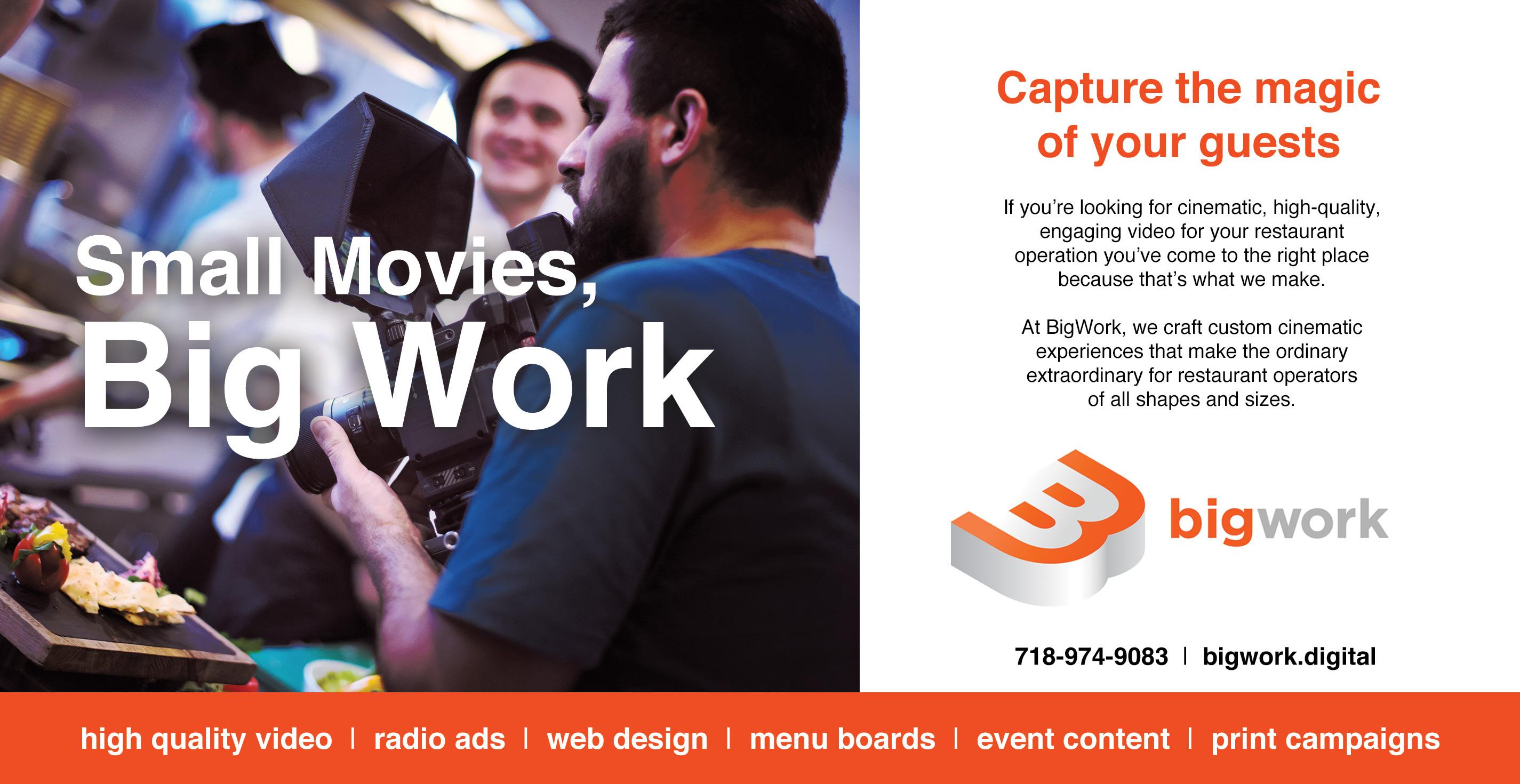




Technology has revolutionized the way dining guests make restaurant reservations. The process of a simple phone call has morphed into a complex system of online platforms and apps that have put a premium on the most popular restaurants and their most coveted dining times.
The landscape of restaurant reservations has changed dramatically in recent years, with the rise of platforms like OpenTable and Resy making it easier for diners to secure a table at their favorite establishments.
In today’s fast-paced world, securing a reservation at a popular restaurant can feel like trying to snag tickets to a Broadway show or a sporting event. The most sought-after restaurants book up quickly, especially for prime dining times like Friday and Saturday nights. As a result, diners are often left scrambling to find a table at their desired restaurant, leading to a competitive marketplace for reservations.
This high demand for restaurant reservations has created both legal and non-legal entities that special -
ize in controlling access to coveted dining experiences. Some tech savvy entrepreneurs have turned to reservation bots to automatically book tables as soon as they become available, while others have implemented strict cancellation policies to deter noshows and last-minute cancellations American Express has recognized the value of the restaurant reservation market and continues to look for ways to eat into the market dominated by OpenTable. Late last month the company took another step to grow its restaurant reservation footprint with
the purchase of the on-line reservation platform Tock in a deal valued at $400 million.
Those efforts began with the Amex purchase of the RESY reservation platform in 2019. By offering exclusive benefits and perks to cardholders who use their platform to make reservations, American Express is positioning itself as a leader in the restaurant reservation space. This competition has led to innovations in the way reservations are made, with new features
continued on page 120
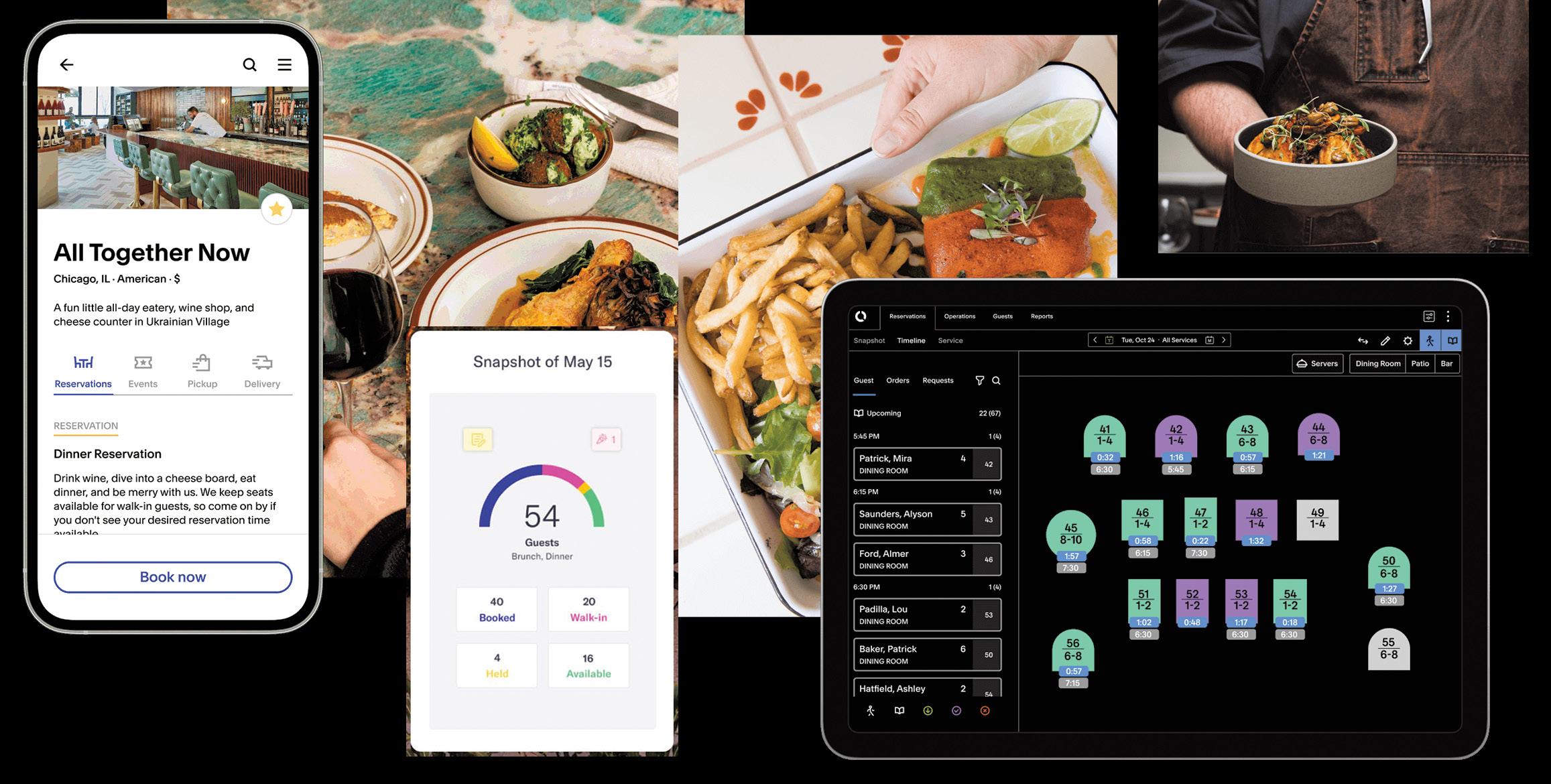

The role of dining in colleges and universities is crucial for several reasons. Firstly, dining facilities provide students with essential nourishment to fuel their bodies and minds for academic success. A well-balanced diet is essential for maintaining good physical health, which in turn can have a positive impact on mental health and academic performance. By offering a variety of nutritious meal options, dining services can help students maintain a healthy lifestyle and promote overall well-being.
Additionally, dining facilities play a significant role in creating a sense of community on campus. Shared meals provide students, faculty, and staff with an opportunity to connect and socialize outside of the classroom. These interactions can foster a sense of belonging and camaraderie, which are essential for creating a positive and supportive campus environment. Furthermore, dining areas serve as gathering spaces
where students can come together to study, collaborate on projects, or simply relax and unwind after a long day of classes.
Moreover, dining services have come to serve as a platform for promoting sustainability and environmental awareness on campus. By sourcing local, organic, and ethically produced ingredients, colleges and universities can support sustainable farming practices and reduce their carbon footprint. Additionally, implementing waste reduction and recycling initiatives in dining facilities can help minimize the environmental impact of campus operations.
With that responsibility on their proverbial plates, the nation’s college & university food service directors are set to convene this month in Louisville, KY.
The National Association of College & University Food Services (NACUFS) will host it annual NACUFS 2024 National Conference, July 17-20 at the Kentucky International Convention Center in
“Through this conference, we aim to create an enriching environment where leaders and innovators in collegiate dining can come together to share insights, inspire creativity and drive the future of campus dining.” — Kory Samuels
Louisville, KY.
This year’s conference theme, “Distilling Knowledge, Crafting Community,” underscores a commitment to fostering innovation and collaboration among dining professionals in higher education. Attendees can expect a robust program of educational sessions, keynote addresses, and networking opportunities designed to enhance skills, deepen knowledge, and strengthen community ties across campuses nationwide.
“Through this conference, we aim to create an enriching environment where

leaders and innovators in collegiate dining can come together to share insights, inspire creativity and drive the future of campus dining,” said NACUFS Board Chairman Kory Samuels, associate vice president of auxiliary services, finance and administration at the Rochester Institute of Technology. “We are thrilled to welcome our members to Louisville, where we will blend tradition with innovation to redefine excellence in our field.”
A variety of educational sessions tailored to address pressing issues and emerging trends in collegiate dining will cover topics including the integration of artificial intelligence in dining services, enhancing food allergy awareness, strategies for achieving zero carbon emissions, and best practices for workforce engagement and retention. Additional sessions will focus on elevating women in the culinary field and effective food waste prevention. Alongside these enriching discussions, the NACUFS 2024 National Showcase, taking place Thursday, July 18 and Friday, July 19, will provide attendees with the opportunity to explore the latest trends,
continued on page 116

As restaurant owners from across the nation look to expand and establish new locations, it is crucial that they keep a close eye on what is transpiring in the California legislature. The recent developments in Senate Bill 1524, which seeks to exempt restaurants from including add-on fees in their quoted prices, could have significant implications for the industry as a whole.
The legislation, which is being fasttracked through the Sacramento Capitol, would make it easier for restaurants to set food prices without having to factor in additional costs such as service fees or employee benefits. This exemption would essentially reverse a law passed just last year that required businesses to include all fees in the prices they present to customers.
While the initial legislation, SB 478, was intended to increase transparency and awareness among consumers, the new bill aims to provide more flexibility for restaurants in setting their prices. This shift in policy could have a direct impact on how restaurants across the nation operate, especially those looking to expand into California.
Attorney General Rob Bonta, the original sponsor of SB 478, touted the legislation as a crucial step towards empowering consumers with accurate pricing information. However, the unintended consequences for the restaurant industry prompted a reevaluation of the law’s impact. Senate Bill 1524 emerges as a solution to address
“SB 478 would in effect, eliminate negotiated service fees and therefore deprive employees of income. There’s nothing in the new law to prohibit restaurants from folding fees into their quoted prices and using the income for whatever purpose it is being used now.”
— Jot Condie, President & CEO of the California Restaurant Association
the concerns raised by restaurant owners and industry advocates. By exempting restaurants from the pricing regulations imposed by SB 478, the new legislation provides flexibility for businesses to set their prices without the burden of additional fees.
The swift progress of SB 1524 through the Assembly committees underscores the urgency and bipartisan support for this measure. As the restaurant industry continues to recover from the challenges posed by the pandemic, this legislation offers much-needed relief and support for businesses striving to thrive in a competitive market. With the momentum building behind Senate Bill 1524, it is poised to bring much-needed clarity and flexibility to restaurants as they navigate pricing strategies and strive to provide exceptional dining experiences for their customers. As the legislative process moves forward, stakeholders in the restaurant industry are hopeful that this bill will soon become law, ushering in a new era of opportunity and growth for dining establish -
ments across the state.
Sen. Bill Dodd, a Napa Democrat and co-author of SB 478, agreed, saying, “With the governor’s signing of this historic bill, we can finally take aim at dishonest junk fees that are tacked onto seemingly everything — from online concert tickets to hotel reservations.” SB 478 takes effect on July 1. But a couple of weeks ago, Bonta’s office released an advisory that restaurants would have to follow the new law, and restaurant owners and unions reacted, claiming that they assumed their added fees would be exempt.
Dodd, California Restaurant Association (CRA) and union officials came to the rescue of SB 1524, which was stuck in the Assembly. They lobbied to insert new language allowing restaurants to exclude fees from their menu prices if their menus include “clear and conspicuous” notices that such fees exist. Thus, patrons would have to search menus for such
on page 115
Contributing
Editorial
Phone:






Renowned for its time- and money-saving food-service appliances, Waring has been known as an innovator, from the first blender in 1937 to the Waring® Ellipse™ blending system introduced in 2023. Waring wrapped up 2023 with the launch of another revolutionary appliance: the Waring® XPress™ Multipurpose Cooktop.
Winner of a National Restaurant Association 2024 Kitchen Innovations Award, the Waring® XPress™ has both top and bottom heated surfaces that spread batter evenly, so it cooks both sides of a crêpe simultaneously. With no more need for skilled workers to spread the batter by hand or for the crêpe to be flipped, chefs can craft crêpe creations faster than ever, up to 60 crêpes an hour.
Crêpes are highly adaptable, serving both savory and sweet menu roles. They’re also a great opportunity to explore fusion food ideas. Rethink the taco by filling a crêpe with grilled beef and fresh salsa. Chicken shawarma is great with pita but wrapping it in a crêpe provides a delicate twist to a beloved dish.
The versatile Waring® XPress™ is also great for making a variety of time-honored ethnic recipes. With its nonstick top and bottom cooking surfaces, the Waring® XPress™ is the perfect for tortillas and various other flatbreads from
around the globe. Easily press and cook homemade tortillas, and then let the Waring® XPress™ make perfect quesadillas, golden on the outside and full of melty, gooey cheese and fillings on the inside. Other global flatbreads, such as roti, pita, and pizza crust, are ideal for the Waring® XPress™.
The Waring® XPress™ is also a versatile single-surface cooktop, handy in busy kitchens that need an extra cooking space. Think of it as a double-sided plancha! It’s ideal for searing meats, toasting grilled cheeses, and caramelizing vegetables and fruits. It’s also perfect for eggs, pancakes, home fries, and other morning favorites.
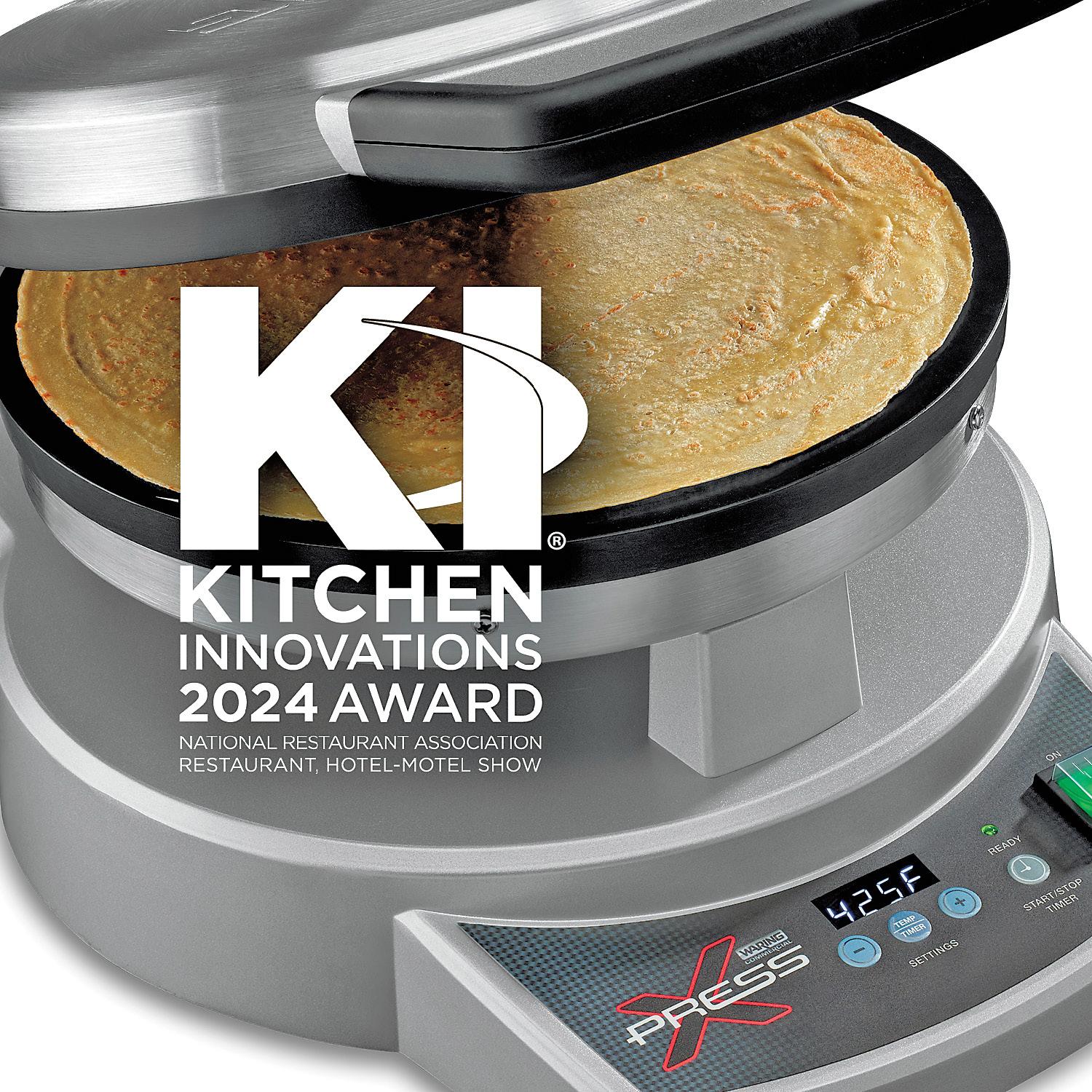
Chef Mike Bagale of the Waring Collective says, “This new machine is designed to function as a multipurpose cooktop, and I see many practical and unexpected applications for it. For example, it works very well to make Japanese souffle pancakes, in addition to a skinny pressed Spanish sandwich known as a bikini. I also really like using it to cook mini sourdough starter pizzas — they cook in just a few minutes.”
With the new Waring® XPress™ Multipurpose Cooktop, making crêpes — or quesadillas, pancakes, ethnic breads, or whatever your inner chef imagines — has never been easier, and knowing that they will feed your bottom line makes the investment a solid decision.
Visit the Waring website at waringcommercialproducts. com to learn more about the Waring® XPress™ crêpe maker and grill and to hear more about Waring Commercial solutions and support.

Medegine Guillaume officially joined the Columbia team in December 2023, although her connection to the University goes much further back. A resident of Harlem, Medegine was a participant in the Columbia Double Discovery program as a teenager. Later, she worked as event catering staff on campus. Today she works with Columbia Dining, the department that oversees both private catering and the dining hall at the Columbia Business School on the Manhattanville campus. She is responsible for the day of execu-
tion of catered events. She acts as the guest manager for the client and event attendees, oversees event staff, and as a liaison to the culinary team behind the scenes.
What’s your background and career path that led you to the culinary world?
I hold a Bachelor of Arts from Buffalo State College and studied Culinary Arts at The Culinary Institute of America (CIA). I was always a foodie -- but during an exchange trip to Paris, I really fell in love and learned to appreciate

delicious food. However, I never felt like I was good at cooking – I did not grow up learning to cook in the kitchen with my mom or grandma, but through hard work and perseverance I pushed through to succeed in my field.
In 2016, I decided to give the professional culinary world a try and started a job in guest relations at the Institute of Culinary Education (ICE). My time there deepened my passion for food and led me to enroll at the CIA. I then expanded my knowledge when I worked for Baldor Specialty Foods as a sales representative, facilitating busi-

Joyce Appelman is the SCOOP News Editor and Senior Contributing Writer for Total Food Service and previously the National Communications Director for C-CAP, Careers through Culinary Arts Program. An industry leader supporting education and scholarships, she has been instrumental in opening career opportunities for many young people in the foodservice industry. Email her at joyceappelman@gmail.com
ness for the company’s wide range of fresh ingredients and unique foods items.
I received so much comprehensive training at the CIA and that’s when I realized even if you think you know how to cook, you don’t know anything. I credit the accomplished chef instructors and the camaraderie with peers as the most rewarding part of my time there, as well as working at the CIA restaurant Bocuse – my most challenging class before graduation.
continued on page 108


By Sophia Maggio
Food and beverage play a crucial role in the overall experience of visitors to amusement parks. Whether it’s indulging in a classic theme park snack like cotton candy or enjoying a full meal at one of the park’s restaurants, the dining options available can greatly enhance the overall enjoyment of a visit to the park. In fact, for many visitors, the culinary offerings at an amusement park can make or break their experience.
The nation’s amusement parks are challenged with a selection of the right food and beverage strategy. Do they strive to stay ahead of the ever-evolving tastes and preferences of their guests, or do they stick to tried and tested items
“At the end of the day, our guests don’t want the trendiest food item. They want a menu that features the best in class of what they have come to expect, and the technology to make their experience faster, smoother, and centered around the rides.” — EA Ramey
that have kept generations happy as they take a break between rides?
For Dallas, TX based Six Flags, the choice has been to focus on traditional theme park fare like hot dogs and funnel cakes to satisfy the taste of their visitors. Six Flags, with its venues across the country, has been a leader in listening to the needs of its millions of yearly guests.
Six Flags designs its amusement parks for the most daring of consumers – but when it comes to dining, visitors aren’t looking for the newest thrills. Instead, the entertainment company sticks to “the big crispers, pizzas, sodas, and some popcorn on the side: all the foods that make the entire experience feel like a treat,” said Edithann (“EA”) Ramey, Chief Commercial Officer (CCO) at Six

Flags.
For those unfamiliar with Six Flags’ legacy, its’ amusement parks are popular one-day destinations for families, tinged with a hint of nostalgia in the form of funnel cakes and hair-raising roller coasters. “We’re a part of Americana, a part of national culture,” Ramey asserted. “Our brand has been around for a long time, and it just needs a little love and attention to stay relevant in both dining and entertainment.”
When she joined Six Flags in March of 2023, Ramey was tasked by CEO Selim Bassoul with the responsibility of relevancy: an agenda that included the beautification of parks, capital investments, and improving the guest experience through iconic rides and mouthwatering refreshments alike.
“In the beginning, there was a lot of innovative thinking around dining,” Ramey reflected. But with high-level marketing experience at Maggiano’s, Chili’s, On the Border, and other big players in the restaurant world, Ramey recognized the importance of simply elevating –rather than innovating – Six Flags’ core menu.
Drawing from her past experiences, Ramey now consults on Six Flags’ food
continued on page 14
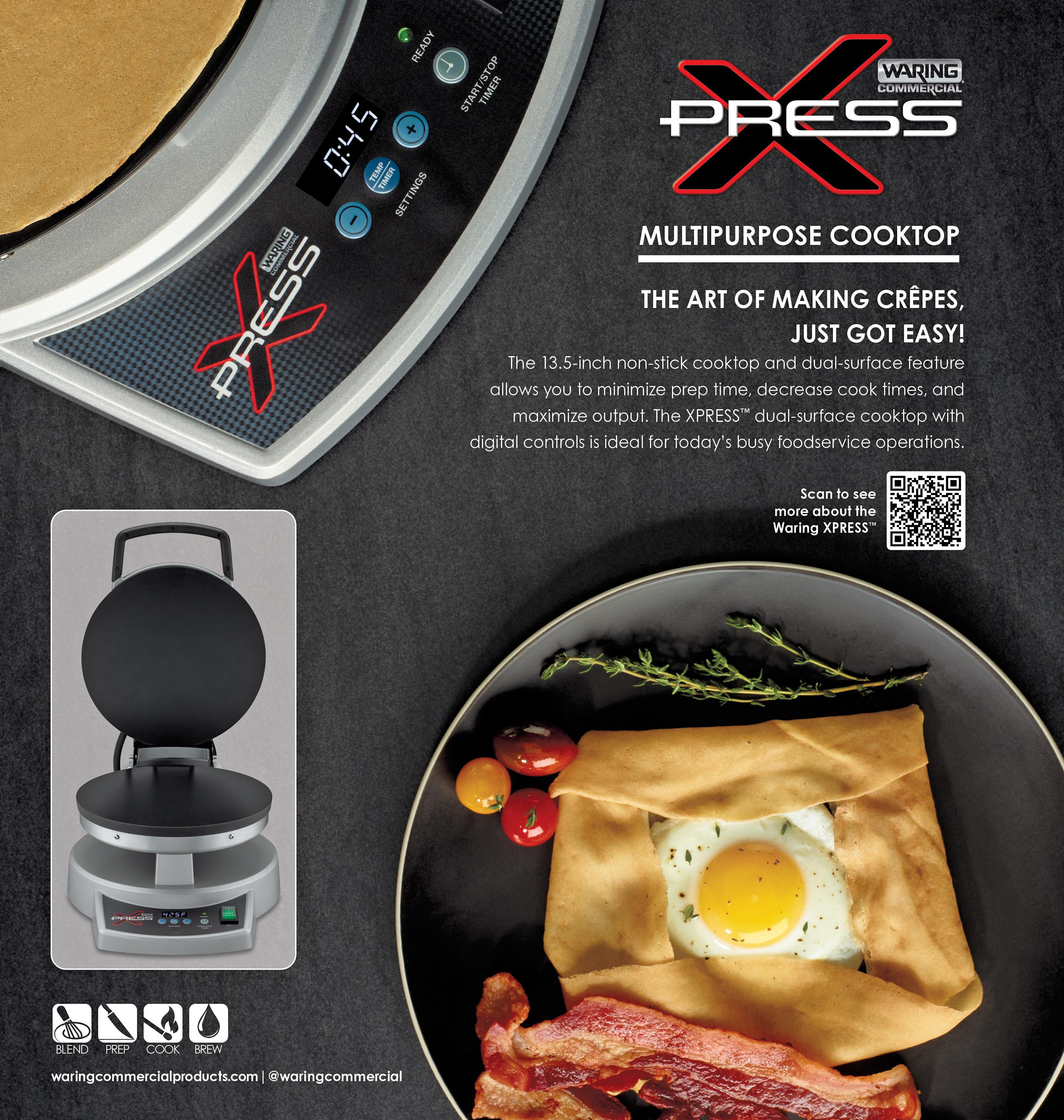
and beverage initiatives, led by the company’s Food and Beverage Director. Ramey also oversees marketing, revenue and admission products, guest recovery, and group sales – “so I’m basically charged with driving park attendance,” she summarized.
As Ramey and her team consider how to attract visitors via coasters and culinary choices, they reflect on what differentiates Six Flags from its competitors. “There’s an interesting beauty and commonality across the Six Flags family that makes it easier to market the brand,” Ramey expressed. “Ultimately, there’s a promise: you’re going to have a ton of fun, indulge in fried food, get on a roller coaster, and raise your arms up in the air.”
When promoting the parks through portfolio products like seasons passes and membership deals, Ramey leans on this imagery and the special features of each park. “The locality nuance is something we make sure to talk about,” Ramey said. “Every park offers something special: it could be their physical geography, like our San Antonio park,

situated in a dramatic rock indentation; or Magic Mountain in California, which has more roller coasters than any other park.”
In addition to regional assets, Ramey and her marketing team highlight the Six Flags dining experience through a combination of taste and technology. “At the end of the day, our guests don’t want the trendiest food item,” she observed. “They want a menu that features the best in class of what they have come to expect, and the technology to make their experience faster, smoother, and centered around the rides.”

This observation prompted the company to develop food ordering kiosks, which have already rolled out in several parks. “We completed Alpha testing and we’re in Beta now,” Ramey shared. “We’re also pairing kiosks with our mobile ordering
app, which we introduced first, and we disperse seating throughout our parks so people can order, eat, and take a break from the heat.”
In both the crowds and the kitchen, Ramey aims to elevate food and people. “With these technologies, we just want to keep guests happy,” Ramey said. Regarding the effects of new technology on kitchen staffing, “we’re focused on retaining and forming strong teams, rather than replacing people with technology,” she assured. “Kiosks, mobile ordering, and quality teams will become infused to enhance the dining experience.”
These technologies will gradually unfurl on a national level. “Our Food and Beverage Director acts more as a project manager than a culinarian,” she said, “supporting our parks as they adjust to new kitchen equipment, navigate challenges, and share solutions with other parks.”
This adjustment period is collaborative and, unsurprisingly, peoplecentered, “so that technological shifts only underscore our promise to guests,” Ramey said.
Six Flags’ promise includes delicious fried foods and even alcoholic beverages at select locations. The company recently introduced mobile beer carts, under the premise that “if you see beverages, you’ll buy them,” Ramey said. “For us, alcohol is a fun thing to add on top of our core food items, and we’re
spending a lot of time on training to ensure we’re doing this right,” honoring Six Flags’ reputation as a family-friendly company.
This reputation is reinforced by Six Flags’ community-entrenched ethos and ongoing conversations about sustainability, which resulted in the largest solar project allocated toward a for-profit organization in the United States. “We also partner with local organizations and donate tickets to families in need, as well as sports teams and other entertainers to promote connections across local fan communities and causes,” Ramey said.
“In all of our parks, we have a passion for making our communities better, so we invest a lot of thought into making people feel comfortable,” she concluded – and fueled by top-quality food and a break in the shade before their next ride. By sticking to the basics, Six Flags has been able to enhance the overall enjoyment of a visit to its parks. Visitors can look forward to not only thrilling rides and attractions but also delicious food and beverage options that cater to their preferences. This focus on food and beverage has not only improved the guest experience but has also contributed to the bottom line of Six Flags venues, as satisfied visitors are more likely to return and recommend the park to others.
All photos courtesy of Six Flags Entertainment

When it comes to accurate answers about plant-based diet, nutrition, menu planning, and benefits, I turn to Sharon Palmer, aka The Plant-Powered Dietitian. An author of critically acclaimed books, Sharon is a vegan registered dietitian nutritionist (RDN) with more than 20 years of experience in plantbased nutrition and sustainability. She also holds a Master of Science in Sustainable Food Systems.
Sharon has embraced a plantbased lifestyle since growing up in
the woodsy Pacific Northwest. She has built a career combining her passions: nutrition and writing. In addition to contributing to major publications, she has authored four books: “The Plant-Powered Diet: The Lifelong Eating Plan for Achieving Optimal Health, Beginning Today”, “Plant-Powered for Life: Eat Your Way to Lasting Health with 52 Simple Steps & 125 Delicious Recipes,” California Vegan: Inspiration and Recipes from the People and Places of the Golden State,” and “The Plant-Powered Plan to Beat Diabetes.”
Sharon is sought after for her ex-

pertise and her ability to make the sometimes complex world of nutrition informative, easy to understand, and engaging. As an omnivore, I find myself inspired by her discussions on the plant-based lifestyle, sometimes feeling tempted to follow her path.
Given Sharon’s interest in including a diverse range of plant-based ingredients to cuisine, I wondered how prunes could be used more extensively in foodservice menus beyond breakfast, smoothies, and baked goods. I reached out to Sharon with my questions. As you’ll see from her

Cherry Dumaual is a seasoned contributing writer for Total Food Service, bringing years of experience in culinary communications to her role. As the former Partnerships Director at The Monday Campaigns/Meatless Monday, she was responsible for spearheading the PR and partnership development for Monday initiatives, including Meatless Monday. During her tenure, she successfully forged partnerships with renowned organizations, such as C-CAP (Careers for Culinary Arts Program), the American Institute of Cancer Research, and New Jersey Healthy Kids Initiative. Prior to joining TMC, Cherry held the position of Senior Vice President at leading PR agencies, where she worked with major food and healthcare clients. Her passion for learning and cooking international cuisines has led her and her husband to explore local food markets and restaurants in over 50 countries. This firsthand experience has allowed her to gain a deep understanding of different cultures and cuisines, which she brings to her work in the food industry.
responses below, she has a knack for
continued on page 118


By Parker Shatkin
In today’s rapidly evolving market, manufacturers face the daunting task of continuously listening to the requested changes of their customer base and responding with new and upgraded equipment solutions to meet those needs.
This can be particularly challenging in industries such as commercial foodservice and commercial kitchens, where the demands of customers are constantly shifting and evolving.
One of the key challenges for manufacturers in these industries is staying ahead of the curve and predicting the needs and preferences of the dining public. With technology advancing at a rapid pace and consumer tastes changing constantly, manufacturers must be proactive in researching and understanding the latest trends and

“Many of our solutions are about responding to a lack of time and space.” — Marcy Mathews
developments in order to stay competitive. This requires a significant investment of time, resources, and expertise, as well as a deep understanding of the unique challenges and requirements of the commercial foodservice and kitchen industry.
Accomplishing this in the commercial foodservice and kitchen industry is particularly daunting due to the unique challenges and complexities of this market. Commercial kitchens operate on tight budgets and tight deadlines, and any equipment downtime can have a significant impact on
their bottom line.
The challenge for today’s restaurant and foodservice professionals and the dealers and consultants that serve them to find value in the equipment they specify and purchase. Since 1949, many have found Delfield to provide dependable American-made quality to keep them ahead of their competition.
The Michigan based manufacturer has been providing refrigeration, fabrication, and serving systems to clients throughout the food service industry.
Now celebrating 75 years, Delfield
has managed to do what many companies only dream of—scale up to the point of having national reach while still maintaining the sense of a local company. Delfield has become one of the largest manufacturers of custom refrigeration equipment by providing custom, sustainable solutions tailored to their customers’ needs.
Initially founded in Detroit, Delfield moved to Mount Pleasant, Michigan in 1971. As a large manufacturer in the small city of Mount Pleasant, Delfield still has the sense of a local, customer-focused company. “It’s not uncommon to find someone here who has been working at Delfield for 40+ years,” said Marcy Mathews, President of Delfield. Delfield still manufactures
continued on page 122


In recent years, the culinary world has seen the rise of a fascinating and dynamic trend: pop-up restaurants. These temporary dining establishments have captured the imagination of food enthusiasts and entrepreneurs alike, offering a unique blend of innovation, exclusivity, and culinary adventure. From experimental concepts to themed dining experiences, pop-up restaurants continue to be a fixture in the culinary world.
Pop-up restaurants are temporary dining venues that operate for a limited time, often in unconventional locations. Unlike traditional restaurants, which have permanent addresses and long-term commitments, pop-ups are characterized by their transient nature. They can appear anywhere—from empty storefronts and warehouses to outdoor spaces and even other restaurants during off-hours.
The allure of pop-up restaurants lies in their novelty and exclusivity. For diners, the chance to experience something new and fleeting is a significant draw. Pop-ups often offer limited-time menus curated by talented chefs, creating a sense of urgency and excitement. This exclusivity can make dining at a pop-up feel like attending a special event, adding to the overall appeal. For chefs and restaurateurs, pop-
ups provide a platform to experiment and showcase their creativity without the financial risk and commitment of opening a permanent restaurant. They can test new concepts, refine dishes, and gauge customer reactions, all while building buzz and a loyal following. Additionally, pop-ups allow chefs to reach new audiences and explore different markets.
NYC continues to be an epicenter for these establishments, and this summer you can find them in any of their various forms. For example, experimental pop-ups, which focus on innovative and avant-garde culinary techniques. Strong
Rope Brewery in Red Hook is collaborating with Chaat Dog. Chaat God offers Chicago-style hot dogs with a South Asian twist. One of the crowd favorites is their hot dog topped with puffed rice and tamarind sauce, as well as their mint chutney and pineapple garnish.
Collaborative pop-ups, which bring together chefs from different backgrounds to create a unique fusion menu, are another popular form. Check out Silver Apricot and Tolo, who have collaborated in the West Village, serving fresh takes on Chinese food through a decadent four course meal. Their dishes include scallion puffs, salt and pep-
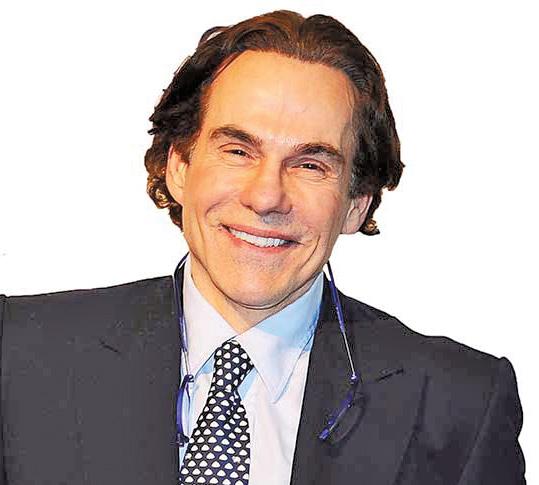
per fish, and sesame panna cotta. Also, Shy’s Burgers and Frys have taken up residency at Mimi in the Greenwich Village. Shy’s is famous for their paper-thin smash burgers, which are, of course, a fixture on the menu, which also includes pressed sandwiches and delectable deserts.
Pop-ups can also spotlight great wine. Gem Wine will take over the rooftop at Spring in TriBeCa, creating the ideal summer dining experience highlighting innovative winemakers, as well as creating a collection of refreshing spritzes and a weekly changing menu. The food will focus on communal seafood towers, composed of local fish and shellfish, as well as yakitori and other small plates. Pop-up restaurants are redefining the culinary landscape, offering diners a taste of the extraordinary and providing chefs with a platform for creativity and experimentation. Whether it’s a themed dining adventure, an experimental culinary showcase, or a seasonal celebration, pop-up restaurants continue to captivate and inspire. As this trend evolves, it promises to bring even more innovation and excitement to the world of food.


by Josephine Dlugosz
Proper bar design and the right equipment play a crucial role in maximizing beverage profits for restaurant and bar operators. A well-designed bar layout, combined with value driven equipment, can significantly increase the speed and quality of service, leading to higher customer satisfaction and increased sales.
One of the key factors in maximizing beverage profits is ensuring that the bar is designed to maximize efficiency and productivity. This includes creating a layout that allows bartenders to work quickly and efficiently, minimizing the time it takes to prepare and serve drinks. Having a well-organized bar setup with clearly defined workstations for mixing, pouring, and garnishing can help bartenders work more efficiently and serve customers faster. Investing in quality equipment can also improve the quality of drinks, leading to higher customer satisfaction and increased repeat business.
BK Resources understands that a well-designed bar with the right equip ment can be a key driver of success for restaurant operators looking to maximize beverage profits. The Illinois importer/manufacturer offers a full line of innovative bar and prep solutions that can save operators and the dealers and consultants that serve them up to 50% on their upfront investment while maximizing ROI.
BK Resources has brought a very different value-added approach with a focus on combining a bestin-class portfolio of standard stock items that can efficiently be modi fied to quickly offer the nation’s hos pitality professional a fully installed and operational bar solution. With a wide range of product of ferings, and a particular focus on bar
“We grew because we understood exactly what our capabilities were and what our dealer and consultant’s end-user customers needed to succeed.” — Matt Woelfer
design, their new vision for operators aims to yield both great margins and great success. To accomplish that goal in Metro New York, BK Resources has announced the addition of P3 Reps to represent the line in the Tri-State marketplace including New Jersey, Philadelphia and Connecticut.
“P3 Reps knows the users that are driving the market,” said Matt Woelfer, BK’s Vice President of Sales and Marketing. “Those key dealers and consultants are who we want to be connected to.” On top of that, P3 is technology-based and able to assist BK with a wide range of duties to boost exposure of the manufac
tion to the Metro New York professional.
BK Resources began 20 years ago as an importer of fabrication parts and E&S hardware, with their products coming from China, Vietnam, India, and Taiwan. After a few years, they grew and became an importer of tables and sinks. The manufacturer has grown its inventory of items over the last four years, and it is looking to reach even further with their new partnership.
“We take products that are in our warehouse, and we put it through a modification process online,” said David Bernstein, Director of Business Development at BK. “When a chef or restaurateur gets the BK Configurator in their hands, they come up with their own unique designs and ideas, but more impor-

tantly, they take ownership of it before they buy. It’s a great intuitive process.” he continued. “We’re talking an opportunity for the dealer to create a bar design that could conceivable earn them a significant margin.”
BK Resource’s modification program, called the EasyMod Configurator, allows operators to select a base unit, such as their standard worktable or chef table. Customers can modify it directly on the website, adding hand sinks and other features, or turning it into a beverage counter. With this program, BK aims to show dealers the value and potential of even the simplest of products; with properly selected BK products, there’s guaranteed efficiency, ROI, and profit margins.
Before establishing the EasyMod Configurator, the team at BK thought a lot about how to distinguish the company’s image and brand. “From a speed to market standpoint, we didn’t want to get classified as true custom work,” said Woelfer. “So everything is based off of
continued on page 120
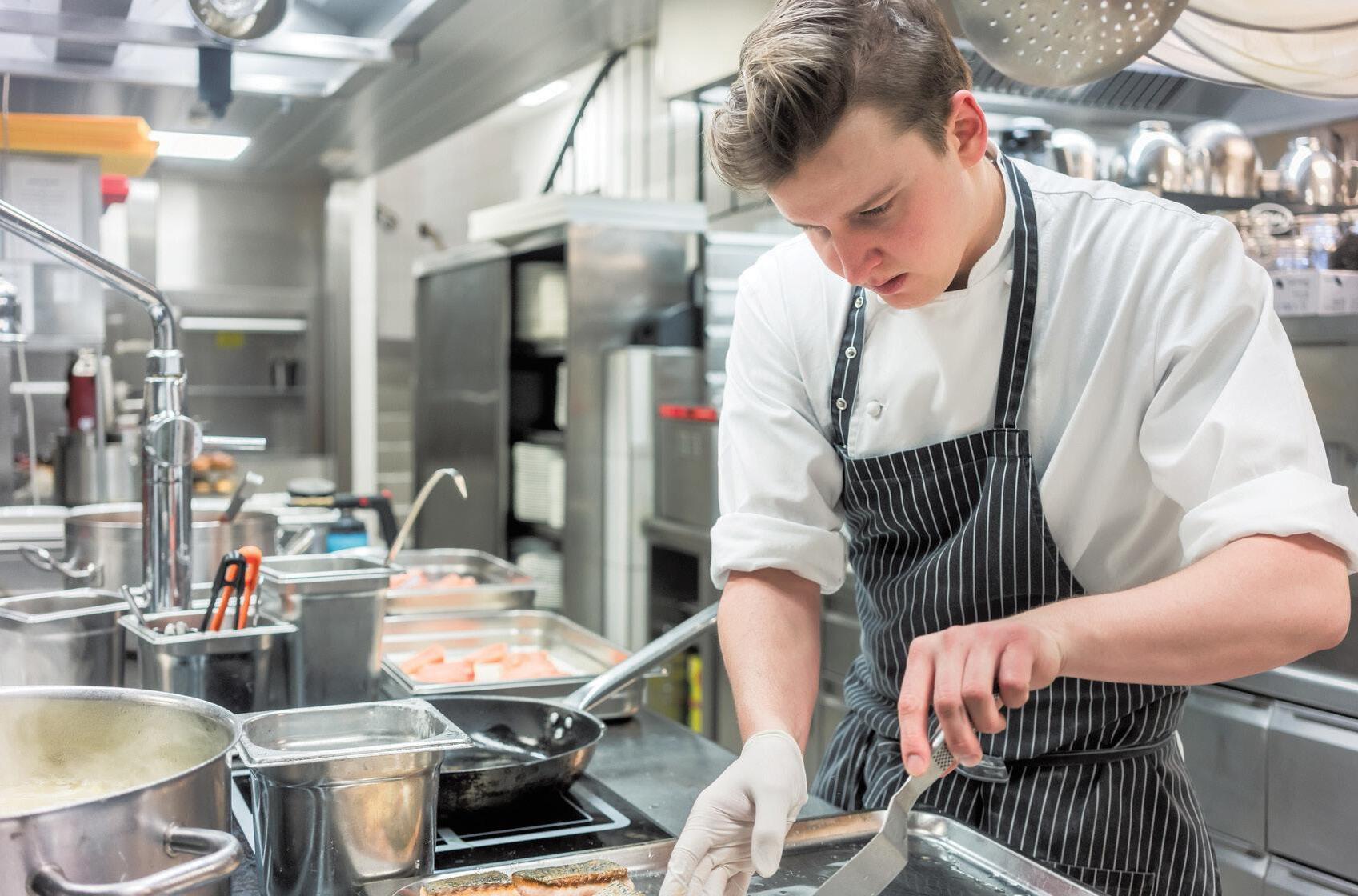

Are you tired of seeing your restaurant’s potential profits slip through the cracks? Whether it’s due to inefficiencies or high costs, it’s time to take control and build consistency in profits. Understanding why your restaurant’s financial performance fluctuates can be the key to unlocking steady, reliable growth.
A critical aspect often overlooked in building consistent profits is accountability. When accountability is missing in a restaurant’s culture, everything from financial targets to basic operational procedures can start to slip through the cracks. Without someone responsible for each part of the process, issues go unnoticed until
A critical aspect often overlooked in building consistent profits is accountability. When accountability is missing in a restaurant’s culture, everything from financial targets to basic operational procedures can start to slip through the cracks.
they become major problems.
Consider a scenario where a restaurant had a great month followed by a sudden drop in profits. Upon review, it was found that inventory management lapsed, causing excessive waste. Schedules were also created based on intuition rather than budget, and
customers started noticing the restaurant’s decline in cleanliness due to neglected checklists.
Here’s where accountability plays its part. If each shift had a designated person responsible for inventory checks, discrepancies would have been caught much earlier. If schedules adhered to the budget, labor cost would have remained in line.
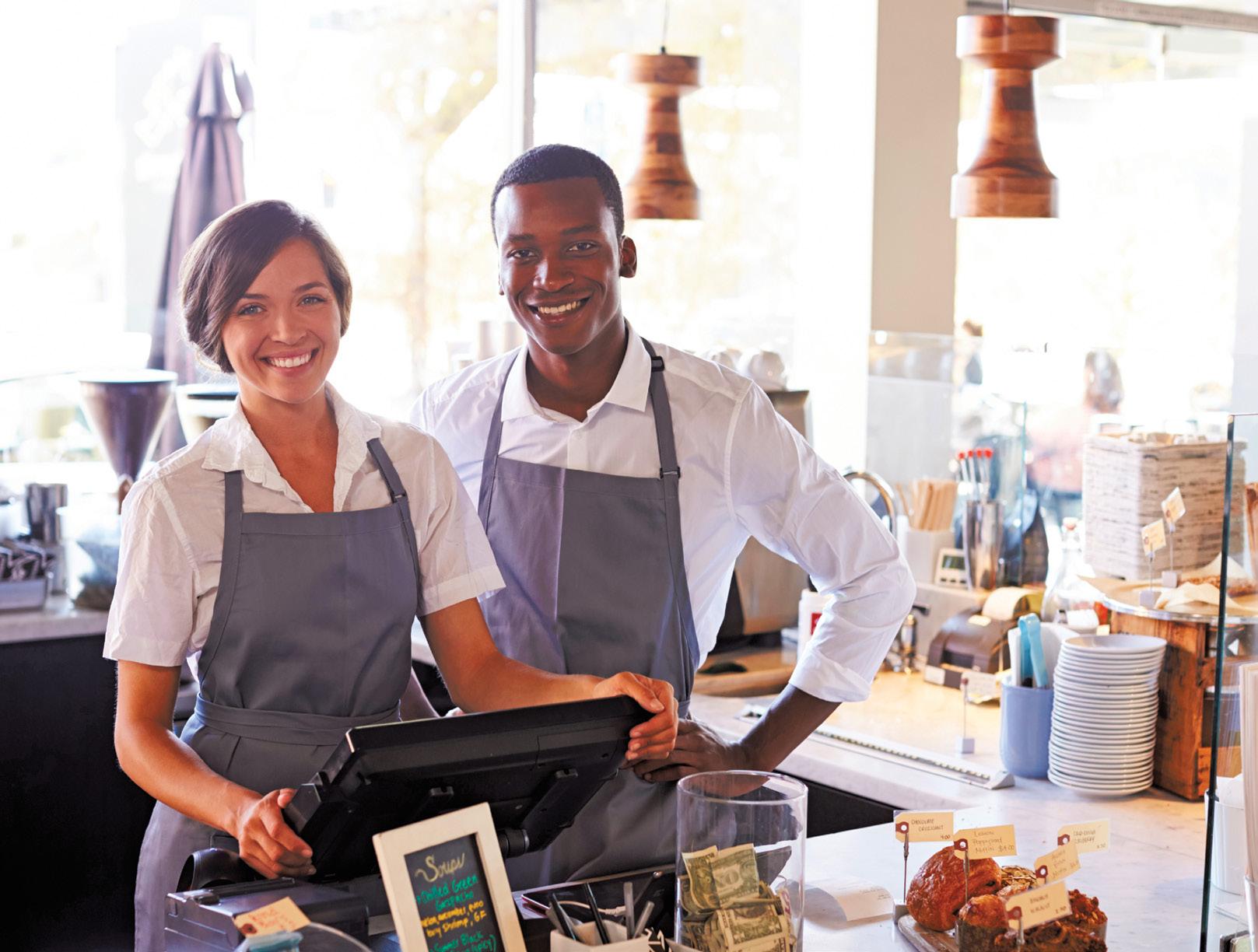

David Scott Peters is an author, restaurant coach and speaker who coaches restaurant operators how to stop being prisoners of their businesses and to find financial freedom. His first book, Restaurant Prosperity Formula: What Successful Restaurateurs Do, teaches the systems and traits restaurant owners must develop to run a profitable restaurant. Thousands of restaurants have worked with Peters to transform their businesses. Get his three principles to restaurant success at http://www. davidscottpeters.com.
and scheduling should be done on budget, and these reviews should be conducted weekly, if not daily. Structured reviews led by specific team members ensure everyone knows their responsibilities.
And if each shift ensured checklists were followed and completed, customers would have continued to enjoy a clean and welcoming environment, increasing the likelihood of their return.
So, how do we fix this?
Regular restaurant financial reviews are crucial. Start with having a restaurant budget. This means not just looking at your profit and loss statement at the end of the month but analyzing your numbers weekly using a weekly prime cost budget variance report. Ordering
Proper employee training ensures your team understands their roles and feels empowered to act when things go awry. Continuous training programs help maintain high standards and operational consistency.
Set clear performance metrics for your restaurant. Everyone, from your head kitchen pro to your servers, should know what success looks like in their role and how they directly impact the restaurant’s profitability.
Take these insights and put them into action. Implement regular financial reviews, enhance your training programs and establish clear metrics for accountability. This isn’t just about avoiding losses; it’s about creating a pathway to consistent restaurant profitability and success.

While you can’t prevent a claim, you can be ready for it. Understanding who is involved and how to prepare for the claims process will help ensure an efficient resolution so that you can resume normal operations quickly.
In the hospitality industry, when facing a loss, multiple stakeholders are involved in managing your insurance claim effectively.
The Insured: Typically, the risk management team in hospitality includes roles such as the Owner/Operator, Risk Manager, Controller, Treasurer, Chief Financial Officer (CFO), or Chief Operating Officer (COO). These individuals oversee the reporting, response coordination, and documentation required for a commercial property insurance claim. Their role is crucial in presenting a comprehensive claim to the insurance provider.
The Adjuster: Whether a company adjuster or an independent adjuster working under a company examiner, adjusters play a pivotal role in investigating and assessing losses. In the hospitality sector, they inspect damages, evaluate coverage, and measure losses incurred due to events like property damage or business interruption. Effective communication and providing detailed, factual evidence are essential in navigating potential disagreements over coverage or loss valuation during the adjustment process.
The Broker: Brokers act as essential partners in managing
claims within the hospitality industry. They assist in reporting losses, coordinating overall claim management, and serving as intermediaries between the insured and the adjuster. Brokers like HUB’s claims management professionals advocate for their clients, helping to develop and present claims while negotiating settlements. In cases of coverage disputes, brokers serve as strong advocates to achieve favorable resolutions.
The insurance claims process in hospitality typically unfolds through five distinct stages, each critical for achieving a fair and timely resolution:
1. Reporting the Claim: Hospitality businesses must promptly notify their
broker about the details of the loss, providing comprehensive documentation such as photos, videos, and lists of damaged property. This initiates contact with the adjuster who will manage the claims process.
2. Claim Investigation: Upon notification, the adjuster investigates the claim thoroughly. In hospitality, this involves assessing damages, identifying responsible parties, and determining the extent of coverage under the policy.
3. Policy Review: After investigation, the adjuster reviews the insurance policy to ascertain coverage specifics and any applicable deductibles. Clear understanding of policy terms is crucial to manage expectations regarding claim reimbursement.

Robert Fiorito serves as Vice President with HUB International Northeast, a leading global insurance brokerage, where he specializes in providing insurance services to the restaurant industry. As a 25+ year veteran and former restaurateur himself, Robert has worked with a wide array of restaurant and food service businesses, ranging from fast-food chains to upscale, “white tablecloth” dining establishments. Robert can be reached at 212-3382324 or by email at robert.fiorito@ hubinternational.com.
4. Damage Assessment: In hospitality, damage evaluation often requires expertise from appraisers, engineers, or contractors. These professionals assist in quantifying damages and may recommend preferred vendors for repair services to expedite business recovery.
5. Claim Settlement: Once repairs are completed and damaged items replaced, the adjuster finalizes the settlement process. This includes negotiating with the insured to ensure fair compensation for losses incurred, such as temporary operational expenses (e.g., equipment rental, temporary storage) essential for resuming business operations.

Effective claims management ensures swift recovery and operational continuity. By focusing on proactive preparation and collaborative engagement with brokers and adjusters, hospitality professionals can mitigate risks effectively and safeguard their operations against unforeseen disruptions.
Learn more at https://www. hubinternational.com/industries/ hospitality-insurance/restaurantinsurance/


When responsibly sourcing meats and proteins, international food company
Cuisine Solutions – which operates within the airline, hospitality, and food services industries – ensures higher quality and safety while reducing environmental impact and promoting ethical practices.
At Cuisine Solutions, the world’s leading manufacturer of sous vide products, their team is committed to sourcing the highest-quality meat from reputable farms and suppliers throughout the country, taking into account how the animal was raised, what it was fed, and how it was treated. Over the last 20 years, the company has built an extensive network of suppliers down to the farm level with a majority of beef, salmon, and lamb coming from New Zealand and Australia, as well as throughout South America including Brazil, Argentina and Paraguay.
The company only sources grassfed and grass-finished beef, allowing for no antibiotics or hormones. The animals are raised humanely, and the final product is higher in beneficial nutrients like Omega-3s and CLA (conjugated linoleic acid) while containing less monounsaturated fat than grain-fed beef. The process from farm to Cuisine Solutions plant is operated seamlessly with full traceability and documentation across the supply chain. For the company’s top-selling sliced beef sirloin, the CS team can trace the work directly back to the farm.
Apart from their beef, Cuisine Solutions also sources cage-free eggs for their Signature Sous Vide egg bites. Cage-free eggs come from ethically-

raised chickens with an all-vegetarian diet, allowing for a more nutritious, richer-flavored egg. The bacon used by Cuisine Solutions is also fully Prop 12 compliant, which addresses the confinement of animals like pigs. This is an extra step the company takes to ensure the animals are taken care of, resulting in a better and more flavorful product for the consumer. The company has the same level of traceability and care down to the farm level for their salmon from Chile and their lamb from Australia. They source with the firm ethos that what is good for the consumer must also be good for the animal.
Cuisine Solutions visits each location annually, building relationships with the farmers while monitoring the processing facilities. CEO Felipe Hasselmann and Chairman Stanislas Vilgrain personally visit the farms each year to check on the animal welfare, employee treatment, the farms’ sanitation, and the setup of the organization. They make sure there is QA staff on hand that is dedicated to working with Cuisine Solutions to ensure food safety and quality. They also look at different cuts of meat and how they may lend themselves better to the application of sous vide. An example would be their sous vide beef shank,
in which the cooking process hydrolyzes the fat and breaks down the collagen, creating a more flavorful product.
About Cuisine Solutions: Led by an international team of award-winning chefs, Cuisine Solutions is the world’s leading manufacturer of sous vide products — the innovative, precisecooking technique the company pioneered, perfected, and popularized decades ago. Headquartered in Sterling, Virginia, Cuisine Solutions services more than 30,000 restaurants and 6,000 retailers, as well as major airlines and hotels. For more information, visit www.cuisinesolutions.com.






Sixteen years ago, at Jazz Fest in New Orleans, I was introduced to the crawfish bread served by Panorama Foods. It’s a taste that’s stuck in my palate memory and a driving force for buying Jazz Fest tickets again as soon as I can. Sure, the music was great that year, as the lineup always is, but that delectable bite…it makes me crave a return.
I’m not the only one. The lines to get this item are enormous, and when Panorama took a break in 2023 from participating at Jazz Fest the articles announcing their absence were plenty. As were the articles heralding the good news that Panorama was returning with this festival favorite in 2024. Not many foods inspire this kind of
Cultivate the right beverage offerings at a festival and attendees are happy. And motivated to spend money in local restaurants and bars.
ink. Especially not at a music festival where the menu is up against a lineup featuring names like the Rolling Stones, but some foods do.
The drinks industry has realized that they can do the same thing and use the festival experience to build guest loyalty on property before and after an event.
Long story short, cultivate the right beverage offerings at a festival and attendees are happy. And motivated to spend money in local restaurants and

bars.
Jessie Tettemer, Director of Marketing at the W Philadelphia knows the value of encouraging her bartenders to operate off-site at area events and points out, “You can use the cultural calendar moments to kick off cultural experience moments for those guests. It’s the perfect way to show up around a shared passion and have a call to action and remind them that if you’ve had a good time here in this context come see us back at the hotel, we’re

Francine Cohen is an award-winning journalist covering the business of the f&b/hospitality industry, and a proud native Washingtonian (DC).
In addition to her work as a journalist she keeps busy fundraising for Citymeals on Wheels, Les Dames d’Escoffier, NY Women’s Culinary Alliance, and the USBG Foundation and serves as chief storyteller and brand steward for clients in the food and beverage sector by providing them with strategic marketing and business growth guidance. She has never met a cheese or beverage she does not like, and lives with her husband in New York; leaving him behind to visit New Orleans every summer. (Except 2020-21. Darn pandemic.) You can reach her at francinecohen@mindspring.com
going to be rolling out similar experiences.”
She continues, “You can do that around music, or around a pool for example. It’s an incredible moment to welcome in a community to celebrate,
continued on page 112


As the excitement builds for Plant Based World Expo North America, happening at the Javits Center on September 11-12, 2024, more names are being added to the growing roster of participating companies. The trade show and conference will feature a Hosted Buyer Program, which offers concierge match-making with exhibitors at the show, connecting buyers and suppliers face-to-face during the two day event. Powered by SPINS, the leading data provider for the natural and plant-based marketplace, this program offers an unparalleled opportunity for manufacturers to connect directly with foodservice providers, distributors and retailers.
Since the launch of the program at the start of the summer, confirmed partici-
pants include buyers from Sodexo, representing their higher education division and workplace division, and Compass Group, representing Chartwells Higher Education and their broader business.
The Hosted Buyer Program also includes a diverse array of buyers from various sectors including retail, convenience, travel and distribution, ensuring that exhibitors have the chance to connect with a wide range of potential partners. These include:
• American Cruise Lines
• Kroger
• 7-Eleven/Speedway
• Wholefoods Market
• Hannaford
• KeHe
• American Cruise Lines
• Meijer
• Clark Distributing
• Fairway
• Roots Market
• Migros
• Bristol Farms
• Fresh Thyme
• L&B
This diversity underscores the broad appeal of plant-based products across both retail and foodservice channels. There is a clear appetite from across mainstream supermarkets, health food stores, specialty distributors, and even cruise lines, to stay on-top of the innovations and latest launches in the plantbased sector.
For buyers, the Hosted Buyer Program is highly valuable as the meetings are pre-arranged based on their specifications, offering an efficient and effective way to do business at the event. The program, supported by foodservice consultants Elohi and data-backed by SPINS, is also designed to maximize manufacturers who participate in the event’s exposure to the right audience. Participation in the Hosted Buyer Program meetings is complimentary for exhibitors of the show.


Ben Davis programs the world’s first and only fully plant-based trade expo and accompanying news site and newsletter. He developed the original concept of Plant Based World Conference and Expo for trade show management company JD Events, inspired by his own personal plant-based journey. The event launched successfully in 2019 in the U.S. at the Javits Convention Center in New York City and is currently onto the 2024 Edition. Ben’s mission is to make delicious, natural foods accessible to everyone. He believes that diet and lifestyle are the keys to a balanced and prosperous future for all beings on Earth. Outside of his work in food, Ben is a music producer and performer under the stage name Vibe Street. His greatest joy is making people smile, dance and come alive to the magic of the present moment. Ben is determined to spend his life building community and celebrating this mysterious human experience to the fullest
overall objectives are to showcase our 2024 innovations, connect with individuals within our industry, new business leads/sales and to reinforce Oatly’s commitment to plant-based.”
“We decided to pursue the 2024 Plant Based World Expo because this honestly seems a like a ‘no brainer’ to us. It’s our target audience filled with like-minded brands and attendees alike. Plus, we have had several internal folks who have attended and recommended we participate”, says Erin Taylor, Brand Experiential Manager at Oatly who will be exhibiting at the event. “Our
With the list of confirmed buyers expanding every day there will be more opportunities for meaningful connections at the event. If you represent a foodservice organization and would like to streamline your buying process and ensure you have plant-based options covered, contact Abigail Stevens abigail@ jdevents.com to learn more about the Hosted Buyer Program.
Buyers can also register for a free pass to attend the event Plant Based World Expo to take advantage of an expo hall full of exhibitors, as well as three theaters of content included in the pass! Register at: www.plantbasedworldexpo.com/ register

Proper handling of the oil in your deep fryer between cleanings is crucial to ensuring the consistency, taste, smell and color of your fried foods. By practicing proper oil maintenance, it not only extends the longevity of the oil but also the lifecycle of your equipment and food safety overall.
Here are a few tips for deep fryer oil maintenance:
1. Avoid Polymerization: Foreign objects in your oil will speed its breakdown, causing the taste to deteriorate more quickly. Of course, this is unavoidable to a certain extent, but you can take steps to guard against it. Like load your fry baskets away from the vat so that loose particles of food and ice crystals don’t end up in the oil.
2. Cross Contamination: Using separate fryers for different foods is an effective way to prevent flavor crossover
and maintain the quality and integrity of each dish. For instance, frying fish and then using the same oil for mozzarella sticks can lead to undesirable flavor transfer, as well as potential allergen cross-contact for those with seafood allergies.
3. Oil Degradation: Water can cause oil to break down more rapidly, leading to quicker degradation of the oil quality. This can result in off-flavors and potentially harmful compounds forming in the oil. Also, water and hot oil react violently, leading to splattering and eruptions that can cause burns and other injuries to kitchen staff.
4. Pick the Right Oil: Use high-quality frying oil with a high smoke point, such as peanut, canola, or vegetable oils. Lower temperature oils can break down more quickly and may not produce desirable results. Make sure the proper oil is being used for your dish.
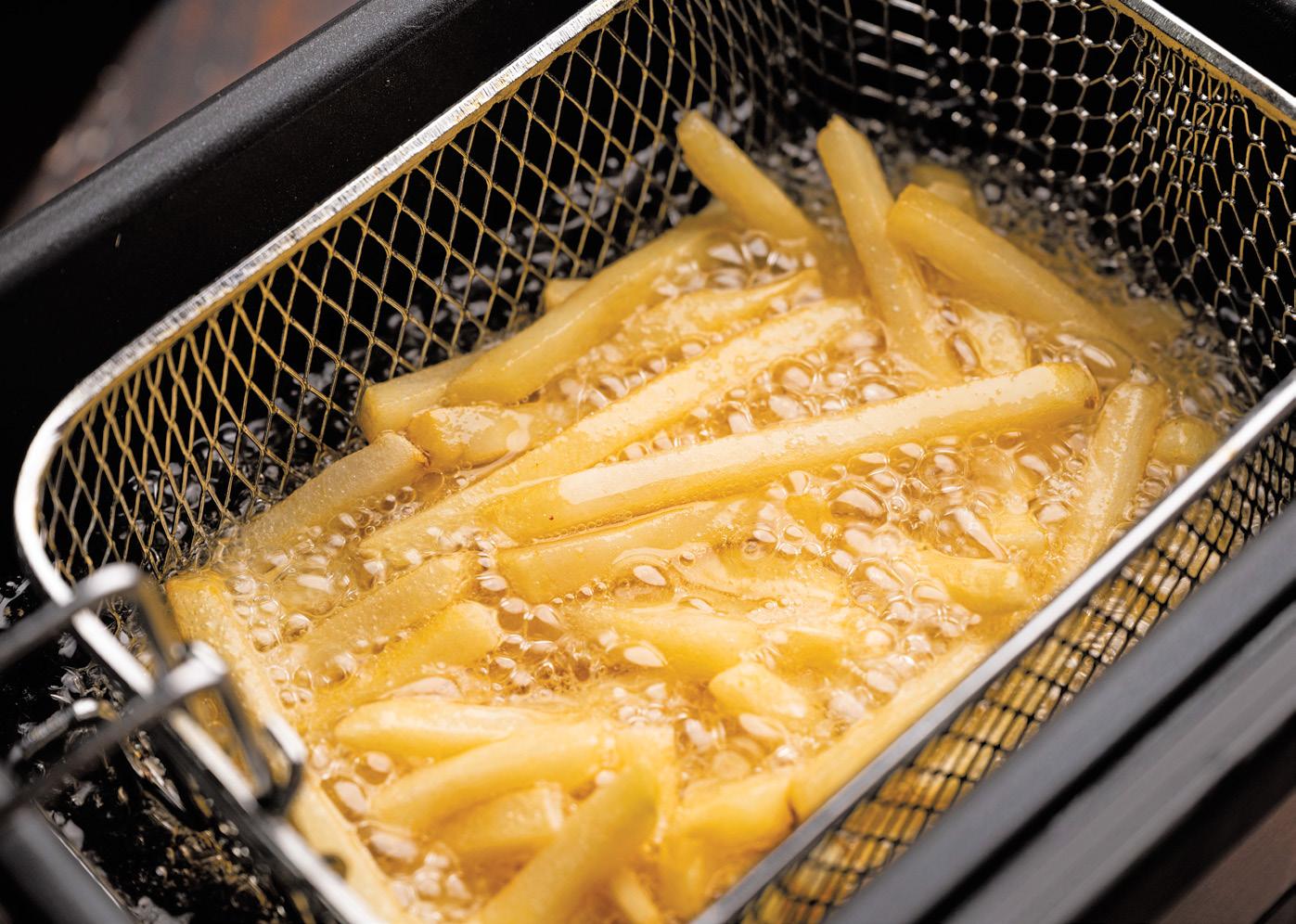
5. Temperature Control: Maintain the proper frying temperature according to the type of food you are cooking. Overheating oil can accelerate its breakdown, while frying at too low a temperature can make food absorb more oil. By maintaining a consistent temperature.
6. Filtering: Regularly filter the oil to remove food particles and debris. This prevents the oil from breaking down quickly and keeps it clean for longer use. Use a fine mesh strainer or a commercial oil filter machine for this purpose.
7. Cooling and Storing: Make sure to place a cover on your fryer at night or during any long stretch of time during the day when it’s not in use. Allow the oil to cool down completely before storing it. Once cooled, strain it again to remove any remaining debris. Store the oil in a cool, dark place in a clean, airtight container to prevent oxidation.
8. Regular Cleaning: Clean the deep fryer frequently. Remove any food residue from the fryer basket and walls using a non-abrasive sponge and mild detergent. Rinse thoroughly and dry completely before refilling with oil.
9. Dispose of Used Oil Properly: Used frying oil should be disposed of responsibly. Many cities have recycling programs for used cooking oil, or you can dispose of it at designated collection points.
By following these maintenance tips, you can ensure that your deep fryer oil remains in good condition, resulting in better-tasting fried foods and prolonging the life of your equipment.

Columbus Vegetable Oils is a leading provider of oils, fats, dressings, dips and sauces to food service, food manufacturers, retail and private label markets. Starting with modest roots in 1936, today, Columbus operates two distribution centers in Des Plaines, IL., and Reno, NV. The fourth-generation family leads the business as a certified woman-owned company that prides itself on high quality products, superior service and fast delivery.
Learn more at www.cvoils.com.

Richard Schenkel has left his mark as a self-proclaimed industry disrupter and insurgent. His latest venture, Phoenix3 Holdings, is focused on elevating the lifestyle and distributive services in the senior living, healthcare, and corporate sectors. He has once again doubled down on his experience building companies and expertise by betting on his strategic leadership at Phoenix3. His business philosophy is grounded in taking calculated risks – aligning companies around strong values on growth-oriented missions to achieve success and build shareholder value.
As the Founder and CEO of Unidine Corporation in 2001, the industry took notice as he rocked the boat within the senior living, behavioral health, corporate, and healthcare verticals. Unidine Corporation is a market leader and the
first company of its kind to provide strategic dining management services that offer chef-driven programs with strict quality standards and a strong emphasis on culture. Under Richard’s leadership, Unidine became a $800M+ managed volume company with over 7,000 team members. In the span of 20 years, Unidine grew from $0 to $700M+ in sales revenue. In 2017, Compass Group USA partnered to acquire Unidine, bringing it under its umbrella as a world leader in food service management. Richard led Unidine through the full life cycle of business development from privately funded, to private equity, to capital group. In 2021, he created Compass Community Living, the largest senior living and support service company both in the USA and globally. Richard served as the CEO of Compass Community Living, the parent entity of three
unique brands: Morrison Living, Coreworks, and Unidine. Under Richard’s discerning leadership, Compass Community Living’s 15K+ employees have provided hospitality and service excellence to more than 1,400+ retirement communities, behavioral health facilities and acute care hospitals across the USA, delivering $1.3B in revenue.
Richard strongly believes that “culture will always shape an organization.” His business philosophy is grounded in aligning companies around strong values on growth-oriented missions to achieve success and build shareholder value, taking calculated risks.
“The key to a successful business is creating a team that feels like family. Our performance is truly enhanced when we are engaged on both personal and professional levels. Culture is imperative for helping define how organizations
continued on page 38
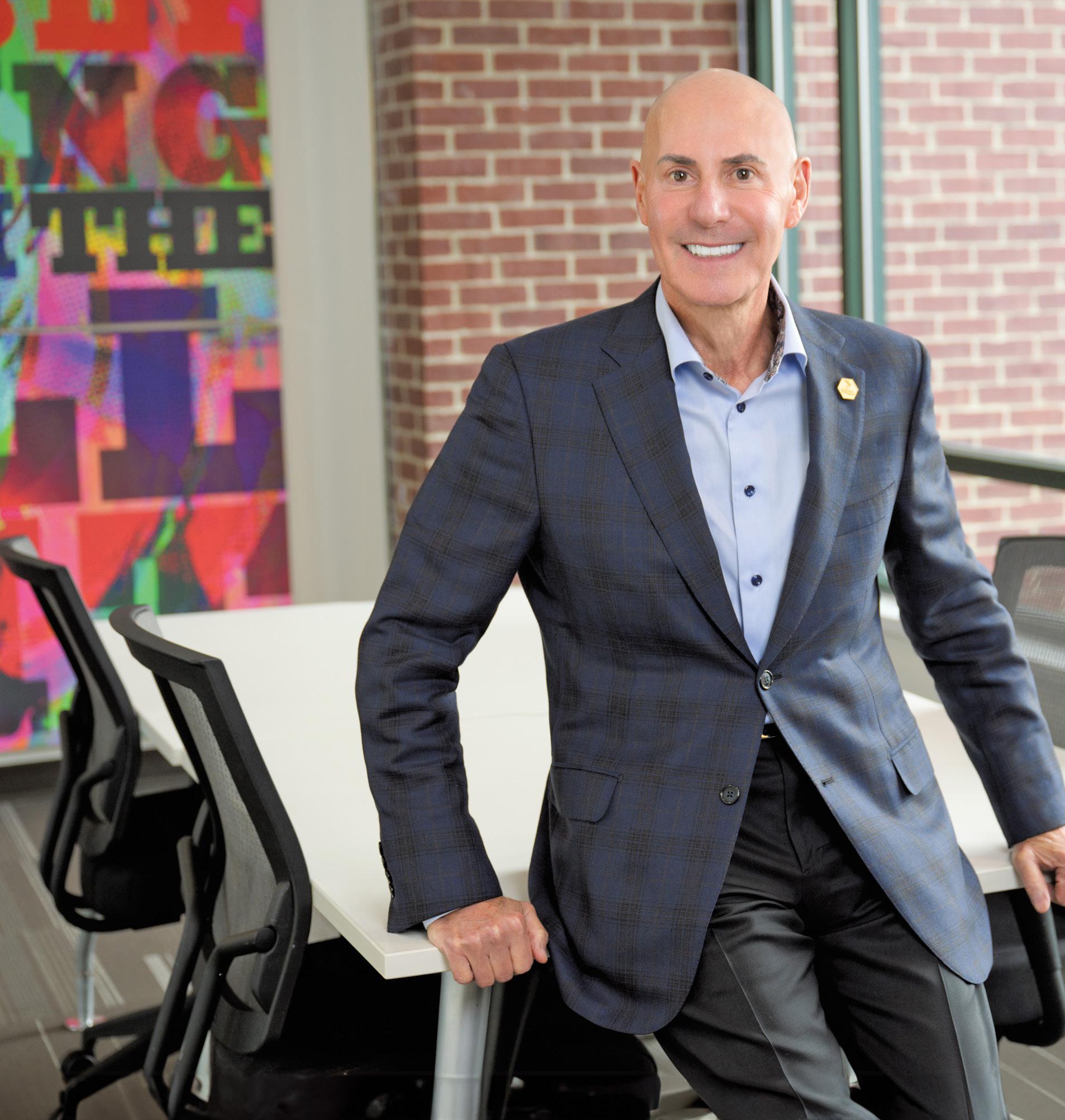
by

coalesce, incite growth, and increase profitability.”
Could you please provide a brief overview of your background for those who may not be familiar with you? Specifically, could you discuss the factors that led you from Newark to Madison, and elaborate on this journey for a moment?
Certainly. I had the privilege of growing up assisting my father at his luncheonette in Newark, New Jersey from a young age. This experience exposed me to the hospitality industry and instilled in me a strong work ethic. Transitioning from this role, I began working at Daughters of Israel, a long-term care facility in West Orange, New Jersey, under the guidance of the food service director. Despite my initial lack of knowledge in the industry, I dedicated myself to learning and eventually excelled in this environment. Working at this facility during summers and after school provided me with valuable insights into food service management within a senior living setting, particularly in a skilled nursing facility.

formal setting, where we were referred to as Dietary Dietitians. I transitioned to employment with Aramark for a brief period before joining Marriott Corporation, where I enjoyed a lengthy tenure. Notably, my involvement with Marriott predates the establishment of certain entities within the organization, with Bill Marriott himself attending my orientation, underscoring the company’s smallscale operations at the time. This transition marked a significant shift in culture and operational dynamics.
Marriott is widely regarded as an iconic company within the hospitality industry. Could you please share some of the key lessons that you gained from your experience with Marriott?



















I am curious to know if your grandparents were alive during that time. It is evident that you possess an understanding of the challenges faced by the population, considering their advanced age.
During the past, the demographic composition was notably diverse – particularly in skilled nursing where individuals possessed a certain level of acuity yet retained mobility. In contrast, present-day skilled nursing facilities exhibit a higher acuity level, often resulting in a lack of discharge from such establishments. Following my stint at the University of Wisconsin-Madison where I pursued a degree in food service administration, I delved into food service management. An internship at Bronson Methodist Hospital in Kalamazoo, Michigan’s dietary department provided me with valuable experience in a more









There are popular sayings that highlight the importance of taking care of employees to ensure that they in turn take care of the guests. The organizational structure at that time was notably different. It is worth noting that the company’s worth was estimated to be between 300 to 400 million. During that period, a significant portion of my career was dedicated to this company. Subsequently, I engaged in several small business startups within various industries – independently or in partnership with others – always appreciating the entrepreneurial spirit. Transitioning from Marriott, I relocated to the Boston area where I joined Dayca International. Regrettably, this experience did not align with my expectations, so I made the decision to transition to another food service management company, where I played a key role in its expansion and even facilitated an acquisition with another organization.
Transitioning from a large corporate environment to an entrepreneurial venture can be a challenging endeavor for individuals. Can you elaborate on how and why you were able to successfully make this transition?
Prior to Unidine, I was involved with
continued on page 40


Republic Management Corporation. Subsequently, I ventured into the technology sector with a startup called SingleCenter.com, an online dating platform aimed at rivaling Match.com. However, due to the economic downturn in 1999 and 2000, many businesses, including Google, faced challenges. In retrospect, I realized the importance of focusing on my expertise in food and dining, leading me to establish Unidine in 2000.
I believe that my experience working for a large company allowed me to effectively absorb a lot of knowledge. However, I have always possessed a self-directed mindset, which I believe is essential for entrepreneurship. Being able to motivate oneself without external influence is crucial in this field. My background has also equipped me with the skills to develop systems similar to those found in larger corporations within a startup setting – ensuring a structured approach rather than a chaotic one. Furthermore, I have learned the value of financial prudence in a startup environment, where every dollar must be accounted for.
I agree with your observation that individuals transitioning from larger organizations to startups may struggle due to the differences in work culture and expectations. At my company, Unidine, we have encountered this when recruiting individuals from major corporations, whom I refer to as the “Big Three.” When we launched in 2001, it was Aramark, Compass Group that had Morrison Living and Sodexo. Those were the three that we’d bump into. We took a very different philosophical approach back then to be the whole foods and food service management. Fresh food, no convenience, culinary driven. One thing led to another and we started to gain some traction in the market in the first five years. Entrepreneurs dream and a lot of them fail because the dreams are too big to be sustainable in practice. Fortunately, at Unidine, we raised capital in year seven and went on a tear to become very, very successful.
I funded it totally the first five or six years. We started with three people, and we built out the infrastructure. In any startup, the whole issue is about selling new clients. We were very successful initially in the Northeast and Mid-Atlantic. Then we moved into the Midwest and
Southeast. By the time I had resigned, I think we were in 38 states. We built the business with a core of senior living, health care, and corporate dining.
Could you please clarify how much of the contract securing process is dependent on a financial commitment to build out a kitchen facility as opposed to the culinary culture and menu offerings? This has been a point of curiosity for me.
During the period when a company is privately held, there is typically a focus on viewing a dollar as a dollar and making conservative investments, as opposed to larger corporations. This mindset remains prevalent today, as individuals continue to prioritize excellent service and a positive organizational culture over seeking capital. Industries such as colleges, universities, senior living, healthcare, and corporate dining are heavily reliant on capital expenditures. However, in my view, the process of securing agreements in these sectors has become excessively complicated.
Is the need for a publicly traded company to acquire growth through purchases rather than organic growth a contributing factor to this phenomenon? What factors drive this trend?
It is believed that a public company must have a specific growth target, with the common perception being that investing in capital expenditure (CapEx) is the way to achieve this growth. For instance, if a company is worth 20 billion, aiming for an 8% growth rate would equate to 1.6 billion in annual growth. Despite the appeal of CapEx to attract national clients, this was not the primary focus of our organization. Instead, we sought out individual clients who were interested in unique offerings, which ultimately led to our success and subsequent growth of the organization.
I just realized we overlooked a point you made regarding the significance of individuals. Could you elaborate on how you developed this aspect? Although I dislike using the term “culture,” it accurately describes the concept. How did you establish an en-
continued on page 42


vironment in which employees were motivated to come to work every day?
The foundation of a strong organizational culture begins on day one. Clearly defining the mission, vision, and values and living by them daily is essential. This goes beyond simply printing them on cards for employees to glance at when convenient. Instead, it should be deeply ingrained within the organization. Daily lineups, akin to the Pledge of Allegiance in schools, should be conducted without fail to reinforce this culture.
Culture is a key aspect of an organization, reflecting its competitiveness and holding individuals accountable for living up to its values. At Unidine, this was enforced rigorously, with a designated Director of Culture overseeing its implementation throughout the company. The strength of this culture was evident when employees who left Unidine for other opportunities would reach out to express how unique and familial the culture was
in comparison.
It is often only upon leaving an organization that individuals truly appreciate the culture they were once a part of. This underscores the importance of consistently nurturing and upholding a positive organizational culture.
It can be argued that technological advancements have led to a divergence from fundamental principles that were once foundational in organizational development.
To a certain extent, I believe there has been an impact. However, it is evident that within the industry, there will be new entrants who must identify a unique market segment beyond technology. Personally, I have not been particularly impressed with the technological advancements in the realm of food and dining management services. At Uni-
continued on page 44



dine, we prioritized maintaining the integrity of our brand, unlike other companies that may compromise their brand identity in pursuit of profit. Our refusal to compromise on quality was a key factor in our success.
In contrast, larger corporations may prioritize business growth at the expense of brand integrity. This highlights the distinction between a privately owned organization with a clear focus on values and a larger corporation solely driven by expansion.
One of the current challenges facing our society is the increasing cost of the labor force and the diminishing workforce. In light of this issue and its impact on the industry, how can we effectively navigate towards implementing a $20 minimum wage?
It appears that many have overlooked the significance of wages as the sole motivator for individuals in the industry. There exist numerous alternative methods to inspire and attract individuals to this field, yet none have been effectively
implemented. Often, organizations solely focus on compensation, such as a $20 hourly wage with healthcare benefits and a 401K. However, many individuals are forced to take on multiple jobs even at this wage level. For the average person, working 40 hours a week at $20 per hour amounts to $800. When multiplied by 52 weeks, the yearly income is $41,600, which is below a livable wage. Therefore, organizations must be willing to explore innovative strategies to redefine the roles of their employees in order to enhance retention rates. While I may not have all the solutions, at our investment company, we prioritize ownership stakes as a significant incentive. Unfortunately, larger corporations with 275,000 employees often overlook this approach and are hesitant to offer ownership opportunities to their workforce. This shortsightedness is likely to result in high turnover rates and ultimately lead to failure for these organizations.
Could you please clarify the meaning of ownership in the context of ESOP
It is important to consider various ownership models such as ESOP, Profit interest, and phantom stock within the realm of food service management. However, there has yet to be an ownership model that encompasses all employees within a company. The introduction of such a model would position a company as a trailblazer in the industry, setting them apart from larger competitors who may struggle to implement such a system due to their size and structure. This represents a misconception within the industry, as there are individuals who seek opportunities for creativity and innovation within their roles. By offering ownership to all employees, companies can attract top talent and potentially revolutionize the industry. For emerging companies, this approach may lead to significant success and establish them as leaders within the food service management sector.
It is commonly understood that the time period between 5 p.m. and mid -
night is when individuals prioritize their personal lives, including spending time with family, among other activities. This aspect of life is not readily accommodated in the restaurant industry.
Certainly not. Recently, I was engrossed in watching a television show called “The Bear” which revolves around a chef who establishes a restaurant in Chicago. The dynamics portrayed in the show are truly captivating, and led me to contemplate the parallels between running an organization and the workings of the restaurant industry – particularly in a kitchen environment where precision and teamwork are paramount above all else. Comparing this to the quality of life in food service management, there appears to be a discrepancy. It seems that the potential to attract talented individuals exists, provided they are afforded the opportunity for creative expression. Often, individuals in these roles are constrained by excessive structure, hinder-
continued on page 46


ing their ability to innovate. It is essential to strike a balance between providing a framework and fostering creativity in order to cultivate a successful team.
Does creativity allow for the selection of my own menu, choice of vendors, and shopping locally? What implications does this hold?
It is recommended to establish guidelines for certain aspects of the operation, while also allowing individuals a greater degree of creative freedom. In the search for a talented executive chef, it may be counterproductive to strictly dictate recipes and menus. Top-tier restaurants often seek chefs who can showcase their creativity, and imposing rigid constraints may limit the ability to attract such individuals.
Furthermore, in response to that, there is a RATIONAL combination oven that can be implemented. With this oven, we have the capability to pre-program all of our menus in advance, alleviating any concerns or worries. This provides a significant advantage in streamlining our
operations.
During my tenure as CEO, I have always prioritized consistency and quality in our products. When selecting culinarians for our team, we sought out creative and dynamic individuals who were committed to pushing the boundaries of culinary innovation.
One particular chief culinarian even proposed to have the entire organization produce its own ketchup. While I appreciate the spirit of experimentation, I believe that this idea may have pushed the boundaries too far. As a consumer myself, I can discern the difference between various brands of ketchup, and I continue to prefer Heinz ketchup.
When seeking talent, did you prioritize the CIA and Johnson and Wales as the initial or final destinations?
As our organization expanded, we integrated talent acquisition into our processes more extensively. We always sought individuals who were genuinely interested in joining our team. As the company grew from its inception to
reaching hundreds of millions in revenue, we observed a shift in the type of talent required. The journey from zero to 400 million was particularly enjoyable. Upon surpassing the 500-million mark, profitability became more achievable, yet there was a risk of losing touch with both clients and team members. I personally conducted interviews for every candidate joining Phoenix Three, focusing not only on technical skills but on cultural fit. In my view, aligning values and DNA with new hires is akin to building a family within the organization. While I humorously reflect on wishing I could have interviewed my children’s significant others, this sentiment underscores the importance of CEO involvement in key hiring decisions beyond direct reports. Such involvement contributes to the organizational culture and its values being upheld throughout the company.
I am also interested in hearing about your work ethic. In the scenario where you have an associate who lacks a
strong work ethic, how would you handle the situation?
It is believed that work ethic cannot be taught, and this belief has become a fundamental principle within our organization.
What was the rationale behind maintaining their distinctiveness rather than integrating them for synergy?
My philosophy was centered on the idea of operating two separate brands under one overarching entity, similar to managing multiple restaurant associates. This approach allowed for autonomy while still falling under the same umbrella. This concept was applied to senior living with the establishment of Compass Community Living. As the CEO of a rapidly growing company, I found enjoyment in building and leading organizations. However, I made the decision to resign in 2022 because I believe in the importance of having fun in what I do each day. When work becomes
continued on page 48


just a job, devoid of enjoyment, it loses its appeal.
Upon announcing my resignation, some expressed concern that I was retiring. I clarified that I was resigning to pursue new opportunities and continue to have fun in my work. I believe that life is too short to not enjoy what you do, regardless of age. Retirement may bring joy to some, but personally, I find fulfillment in staying active and engaged. Each individual’s perspective on retirement is unique, reflecting the diversity of people and their values.
Can you please elaborate on the origins of Phoenix3 and provide some insight into its development process?
Indeed. Phoenix3 has undergone a significant evolution. Upon departing my previous position, I was uncertain about my next steps. Recognizing the availability of capital in the private equity landscape, I observed a gap in industry knowledge among investors. This led me to conceptualize a model that combines elements of private equity with specialized industry expertise. The idea was to support portfolio companies by providing relevant subject matter experts to facilitate their growth.
It is evident that many entrepreneurs face challenges as they strive to scale their businesses from zero to $100 million. Lack of industry expertise can often be a limiting factor in their success. My personal experience of leading a $1.5 billion organization with 17,000 employees from its inception attests to the importance of expertise and discipline in achieving substantial growth.
In entrepreneurial ventures, the need for evolving talent is crucial. Individuals who may have been instrumental in the initial stages of a company’s growth may find themselves outpaced as the business expands. This necessitates making difficult decisions to ensure continued success.
Phoenix3 was founded on the principles of combining capital investment with industry expertise. Our initial investment in Infuse Hospitality, a management service company specializing in on-site management of multi-tenant buildings and restaurants, has yielded positive results.
On-site management of multi-tenant buildings involves the process of overseeing the operations and maintenance of a property with multiple tenants. Upon entering the building, one is expected to adhere to certain protocols and procedures.
The company, which began in Chicago, is part of our portfolio. Co-founded by Michael Schultz and Michael Klong, we believed that with proper funding and strategic management, they could progress to the next stage of growth. Currently, the company is performing admirably. Additionally, we have made smaller investments in ventures such as a family meals app designed for catering services in restaurants. While this investment may fall slightly outside our usual focus, the company is currently seeking funding in a venture capital round and is led by a commendable CEO.
Could you please clarify if the space designated for easy catering is the one being referred to?
Indeed, I completely agree. However, I believe we should adopt a more flexible and disciplined approach in this regard. Currently, we are assessing several other management service companies and will invest in those where we possess the requisite technical expertise. It is imperative to maintain discipline in this regard and refrain from venturing into unfamiliar industries. Our primary focus lies in distributed services and lifestyle service companies catering to corporate, senior living, or healthcare sectors.
One of the questions I would like to pose is regarding the potential return to work, specifically in relation to Infuse. Do you foresee a resurgence of individuals returning to office environments? What are your predictions for the future of workplace populations?
The frequency of traffic congestion varies based on geographical location. In my experience, certain days in New York City, such as Tuesday through Thursday, tend to have heavier traffic compared to Monday and Friday. However, even in cities like Boston where fewer people are commuting to the office on those days, there is still an observable increase in traffic. It is evident that the traffic pat-
terns have changed in recent times, but it is not as predictable as it used to be. I am curious to know your thoughts on this matter.
From personal experience, I have observed a stark difference in the real estate landscape between Boston and Miami Beach, where office spaces are scarce and come at a premium. Meanwhile, in cities like Chicago – where Infuse is headquartered have yet to fully recover from the economic downturn – there remains a distinct niche for companies like Infuse to assist property owners in these areas. The emphasis on amenities as a strategy to attract occupants to these buildings is evident, with various companies exploring innovative approaches.
What’s your read on the status of the healthcare marketplace?
You have a skilled nursing market that is a relatively low-cost operating business. Let’s call it what it is: It’s Medicaid, Medicare for the majority of the population. As much as you want to provide great dining service there, the feds do not give you a dollar more, a dollar less to accomplish that.
Sounds an awful lot like the correctional feeding model.
Right, very much the same. It’s the same three players dominating the healthcare market. When you get into this independent living and assisted living model, I think as the population ages out, it’s got to change. You can’t put people in a dining room three meals a day, seven days a week. We’re going to give you a menu and we’re going to have floral carpet in the dining room. I’m not saying they’re all like that. I think it’s got to get shaken up.
I equate it to the way colleges and universities work. Do you remember meal plans? You’d go to college and there was a 12, a 14, or a 21 meal plan and there wasn’t a la carte. Then they came in with debit cards and then they became a P&L where you had to attract students to the dining service by having great food and service – they’d even let outsiders come in if it was great. I think the UMass is one that has done a wonderful job. Right, wrong, or different? Self-operated. With senior living, everybody’s trying, but
there’s too much focus on offering flexibility to clients and you get the sense that everybody tries to be everything to everybody.
A former senior chef, now working at a country club, told us that he resigned from his position at a prestigious senior living facility in Westchester due to the residents’ preference for simpler fare such as hot dogs and macaroni and cheese over the items listed on the menu. The residents sought comfort food options instead.
Yes, they do. Occasionally, we may go to extremes, but we are still able to produce excellent comfort food. Furthermore, it is important to always have a reliable selection of comfort menu items available. In my opinion, the market is evolving as the individuals entering independent living facilities nowadays are knowledgeable and adaptable. It is a mistake to think that this issue is just about food. The current state of the market suggests a need for change, particularly in the integration of technology within senior living facilities. It is evident that residents possess smartphones but lack a seamless way to interact with the services provided. This fragmented approach, where clients dictate the terms, must evolve to meet the changing demands of the market.
As a senior living operator, it is essential to consider the role of service in attracting and retaining staff. The prevailing expectation of securing high-quality staff without appropriate compensation is unrealistic. A reevaluation of the current model is necessary to ensure that employees are adequately rewarded for their efforts without the reliance on gratuities.
The comparison to the country club market highlights similar challenges faced in terms of service quality and compensation. By reevaluating the current practices and adopting a more sustainable approach to rewarding staff based on performance, senior living facilities can enhance their overall appeal and quality of service.
All photos courtesy of Phoenix3 Holdings, LLC
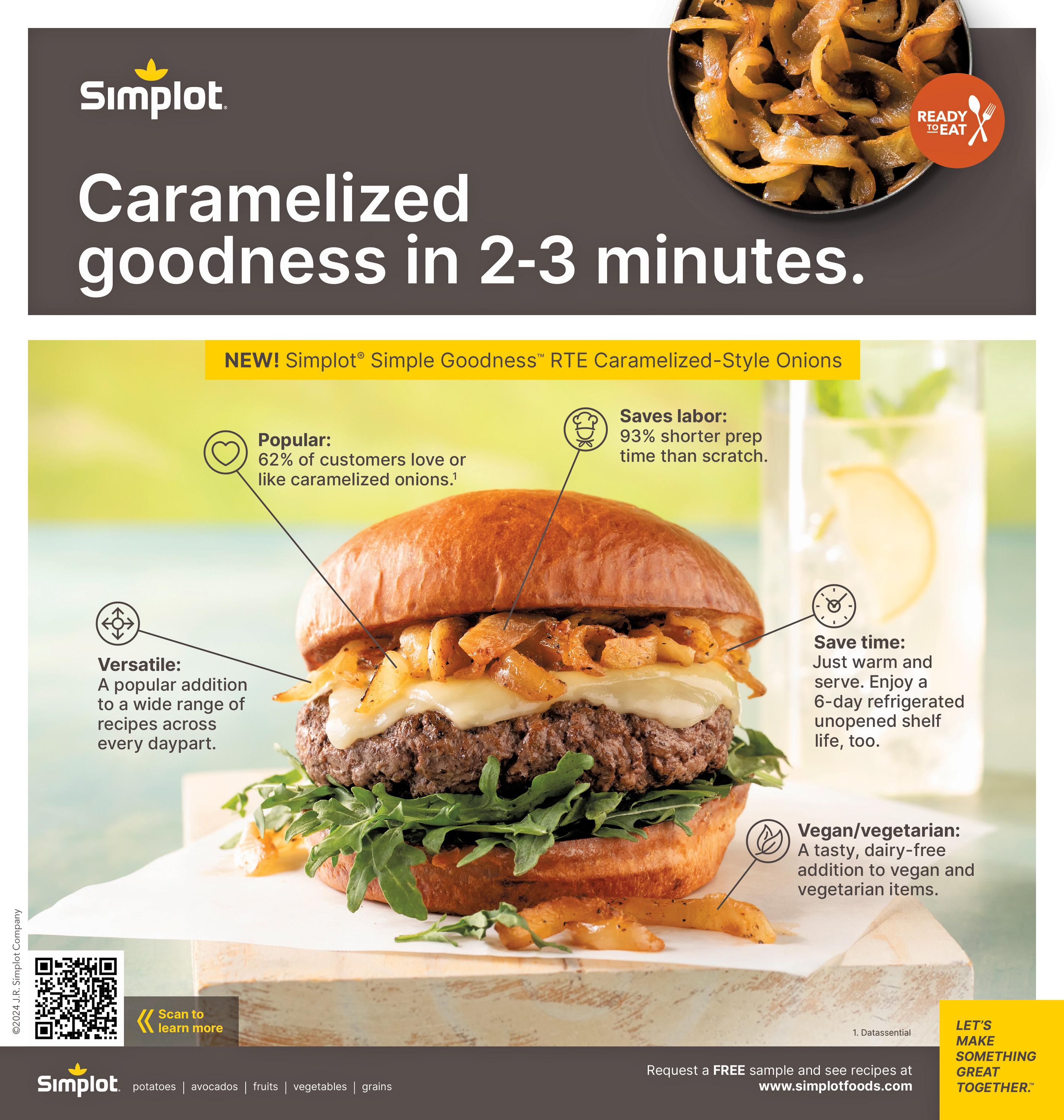
In bustling commercial kitchens, where the sizzle of frying food and the aroma of delicious meals fill the air, safety should always be a top priority. Among the myriad of hazards that chefs and restaurant staff contend with daily, one particularly insidious threat lurks silently: carbon monoxide (CO) emissions from open fryers. This odorless, colorless gas poses grave dangers to both staff and customers, yet its risks often go unnoticed until it’s too late.
Carbon monoxide is a byproduct of incomplete combustion of carbon-
containing fuels, such as natural gas, propane, or wood. In commercial kitchens, where fryers operate continuously to churn out crispy delicacies, the combustion process releases CO into the air. Without proper ventilation, this toxic gas can accumulate to lethal levels, putting everyone in the vicinity at risk. Prolonged exposure to carbon monoxide can lead to serious health issues, including headaches, dizziness, and even death due to asphyxiation. To mitigate these risks, it is crucial for commercial kitchens to install and maintain efficient exhaust systems and regularly monitor air quality. Additionally, staff should be trained to recognize the symptoms

of CO poisoning and take immediate action if they suspect exposure. Implementing these safety measures can help protect workers and patrons from the dangers associated with carbon monoxide.
Beyond the confines of the kitchen, diners enjoying a meal are also susceptible to the dangers of carbon
monoxide. In poorly ventilated spaces or establishments with inadequate safety protocols, patrons may unknowingly inhale toxic levels of CO, putting their health and well-being in jeopardy. The repercussions of such incidents can be catastrophic, tarnishing the reputation of the restaurant and leading to legal liabilities.
continued on page 114
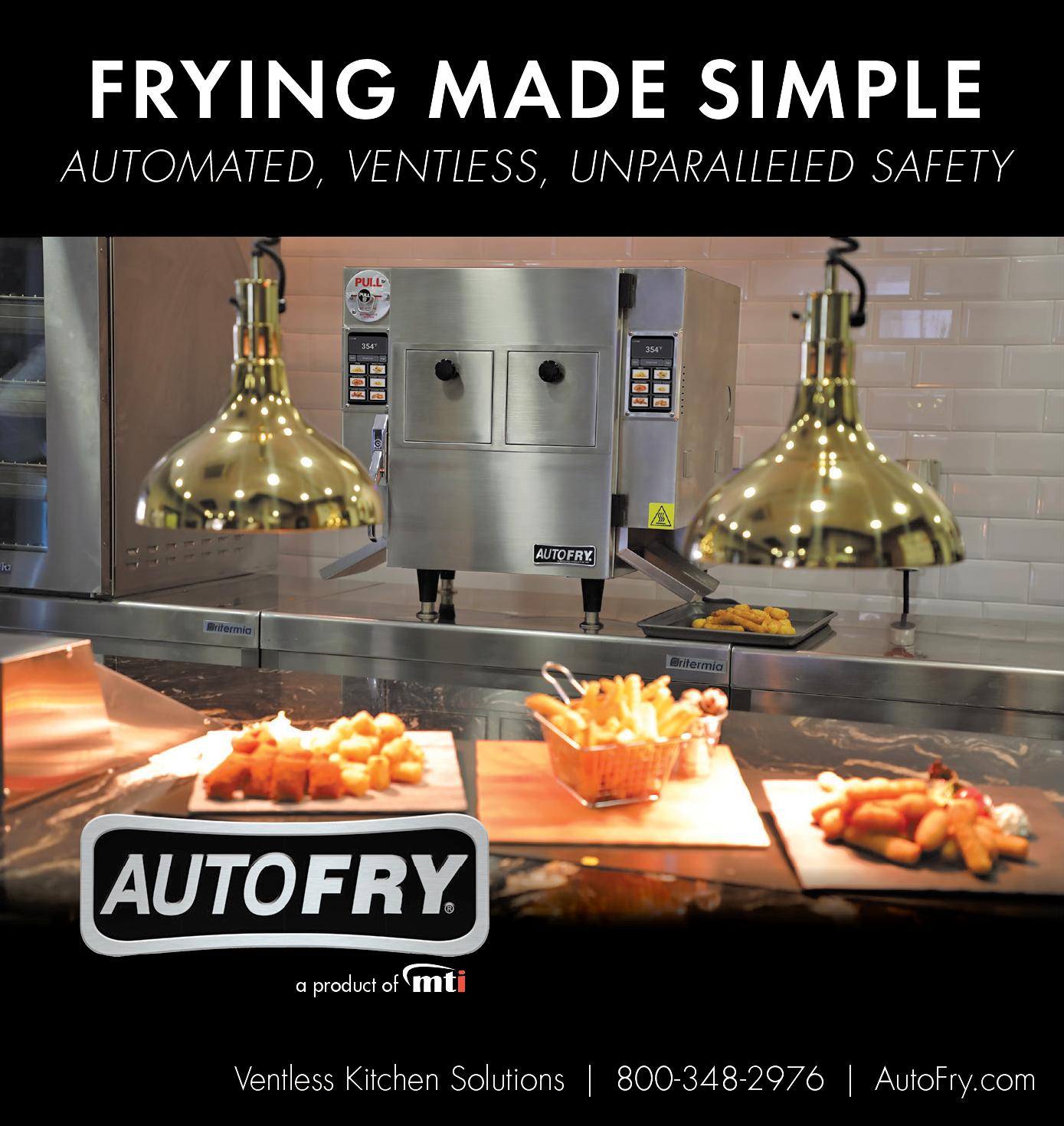
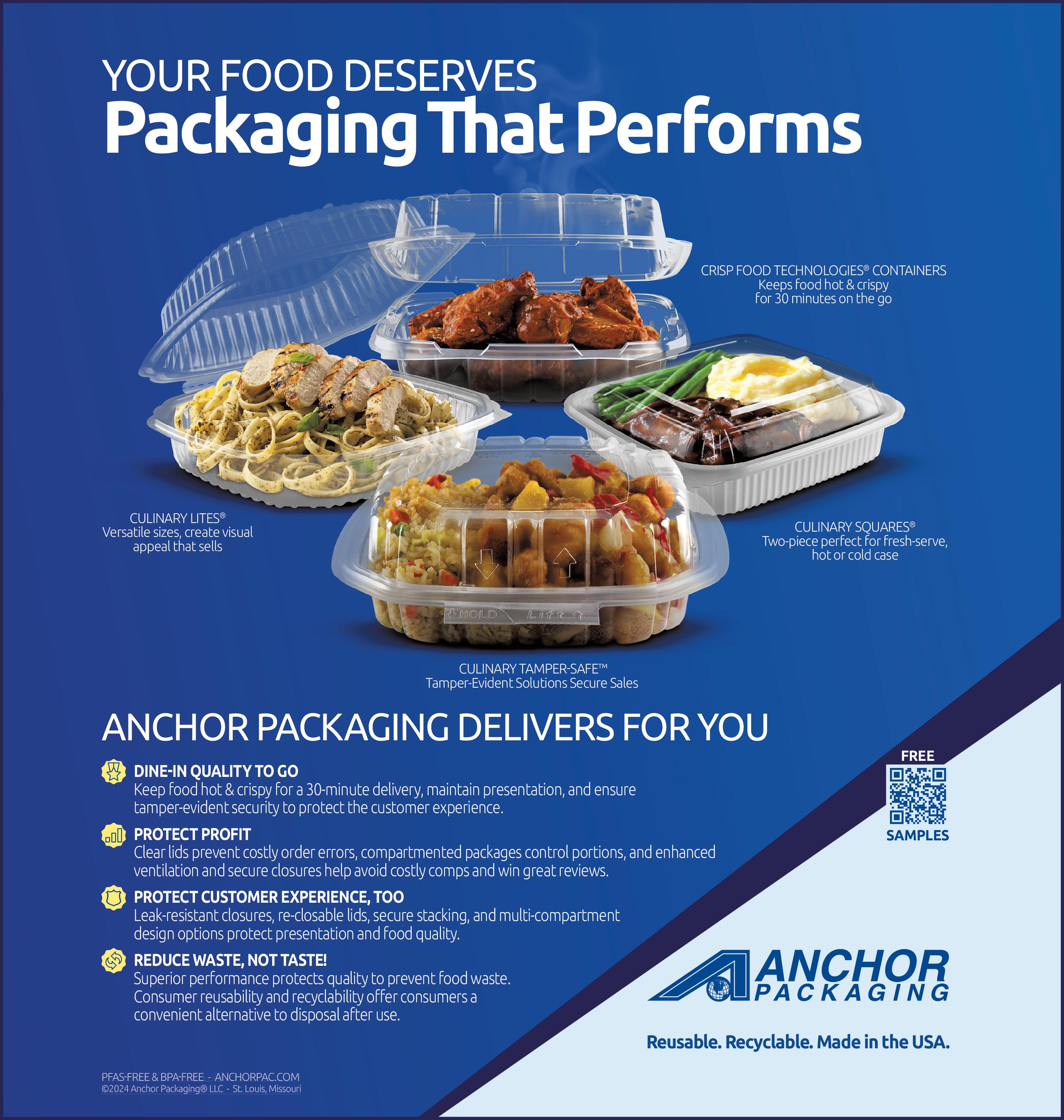
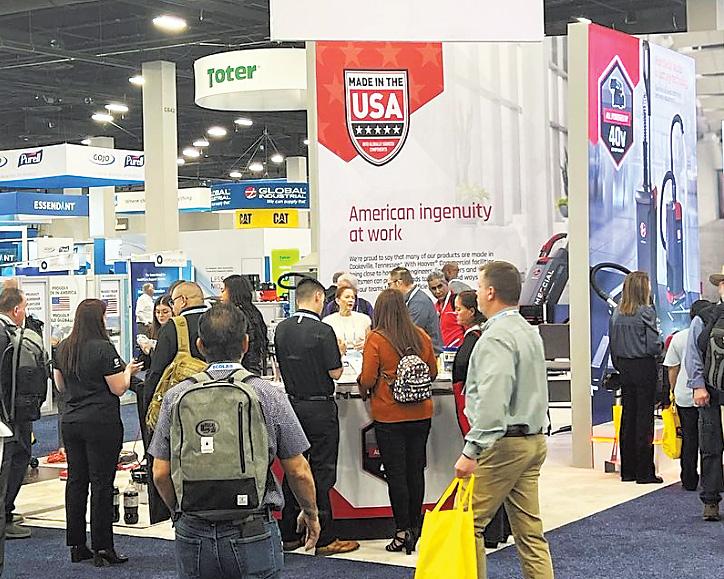
In today’s world, sustainability and cleanliness in commercial buildings and businesses, especially in the hospitality industry like restaurants, have become an essential for hospitality professionals. This shift is primarily being driven by the growing demand from dining patrons who are increasingly conscious about the environmental impact and agendas of the establishments they choose to visit.
As a result of these new levels of customer demand, sustainability initiatives and cleaning practices have become key focus areas for the restaurant and foodservice professional. So, finding the resources to create and implement a sustainable agenda has become an industry-wide priority for both the operator and the nation’s distributors that serve and support them.
One of the ways in which the industry is addressing this demand for sustainability and cleanliness is through attending key events led by the annual ISSA Show North America slated for the Mandalay Bay Convention Center in Las Vegas, NV, Nov. 17th-21st, 2024. ISSA Show North America is the cen-


terpiece of the industry’s sustainability movement, bringing together leading experts, manufacturers, distributors, contractors, and facility managers to showcase the latest innovations, products, and technologies in the cleaning industry. This annual event provides a platform for industry professionals to explore, innovate, and elevate their knowledge, ultimately helping them to enhance their businesses and meet the expectations of their environmentally conscious patrons.
For manufacturers in the cleaning industry, participating in events like the ISSA Show can open up new opportunities to connect with potential customers, strengthen relationships with existing customers, and stay ahead of market trends. Distributors, building service contractors, and facility man-

agers also benefit from attending the show as it gives them access to the latest products and technologies that can help improve efficiency and sustainability in their operations.
This year’s event will feature a bustling Mandalay Bay convention floor.
“With over 10,000 member companies representing distribution manufacturers, building service contractors, and in-house service providers, the ISSA is a powerhouse in the cleaning industry, noted ISSA Show Manager Ed Nichols.
“I’m proud of the initiatives that our exhibitors have taken to make the show floor special, Nichols said. More than 100 companies last year had special demonstrations in their booths. It speaks to our event promoting our core themes while staying open to what’s new.”
Nichols and his ISSA Show North
“More than 100 companies last year had special demonstrations in their booths. It speaks to our event promoting our core themes while staying open to what’s new.” — Ed Nichols
America team have also taken the commitment to another level as they search and select show event venues.
“The Mandalay Bay Convention Center, where the show is held, is a prime example of sustainable practices in action. The facility features the largest solar panel rooftop in Las Vegas and actually powers 20% of the center’s energy needs,” Nichols detailed.
ISSA Show North America also understands the importance of a carefully crafted and curated educational program. The Sustainability Council of ISSA is pivotal in developing and contributing to the course development, with a focus on sustainability in the cleaning industry. With over 170 educational sessions and a focus on networking opportunities, the ISSA Show is a must-attend event for cleaning industry professionals. From facility operations to healthcare, the education program covers a wide range of topics to help attendees stay informed and connected.
“We also recognize the channels within the industry continue to evolve. continued on page 124

AVRAMAR brings you the ultimate guide to making the most of the summer BBQ season with delectable fish dishes. Our expertise in Branzino and Dorade ensures your summer menu will stand out and delight customers. Discover how to grill fish to perfection, enhance flavors, and create signature dishes that will keep your regulars coming back for more.
Why Fish is a Flexible Addition to Summer Menus in the Foodservice Industry
Fish is an incredibly versatile ingredient, offering endless possibilities for summer menus. Its light, delicate flavors are perfect for warm-weather dining, making it a favorite among health-conscious customers. It can be prepared in a variety of ways, from grilling and baking to incorporating into refreshing salads and light dishes. The versatility of fish allows chefs to experiment with different seasonings, marinades, and cooking techniques to create unique, flavorful dishes that can easily become signature menu items.
Grilling fish on a BBQ can seem intimidating to some. The unfamiliarity and the fear of the fish falling apart might discourage even experienced cooks from trying it. However, once you learn the techniques, grilling fish becomes a straightforward process that creates exceptionally flavorful results. The smoky taste and charred edges you get from the BBQ
are incomparable to anything you can achieve in a kitchen. Plus, grilling fish outdoors means food service establishments can avoid the strong odors that can permeate indoor dining areas, enhancing the overall dining experience for customers.
Mastering the art of grilling fish not only adds a healthy, delicious dish to your repertoire but also creates an impressive appeal for your summer meals.
Grilling Fish: Top 3 Tips for Creating Standout Menu Additions
1. Dehydrate Fish Skin for Extra Crispiness
The key to achieving a crispy texture on your grilled fish is to dehydrate the skin. Before grilling, place the fish in the refrigerator uncovered for a few hours. This process removes excess moisture from the skin, ensuring it crisps up beautifully when grilled. This technique not only enhances the texture but also intensifies the flavor, offering a delightful contrast to the tender flesh of the fish.
Why It Works: Removing moisture allows the skin to caramelize and crisp up without steaming. This method is particularly effective for species like Branzino and Dorade, which have thinner skin.
Pro Tip: Ensure the fish is thoroughly dried with paper towels before placing it in the refrigerator. Pat it down again before grilling to remove continued on page 126




By Jackson Hart
Southern biscuits are more than just a side dish on menus in the South. They are a culinary staple that hold a special place in the hearts of diners and chefs alike. These fluffy, buttery creations have a way of bringing people together and creating a sense of home and comfort.
On restaurant and foodservice menus in the South, homestyle southern biscuits are often featured in a variety of ways. They can be served as a side dish alongside fried chicken or barbecue, or as the star of the show in a biscuit sandwich filled with crispy bacon, eggs, and cheese. Some establishments even offer biscuits as a dessert, topped with sweet honey butter or served with a side of jam or preserves.
The popularity of southern biscuits on menus can be attributed to their versatility and ability to complement a wide range of dishes. They can be dressed up or down, depending on the occasion, and can be enjoyed at any time of day. But it’s not just the taste and texture of southern biscuits that make them so beloved – it’s also the sense of tradition and heritage that they represent. When diners see a biscuit on a menu, they are transported back to fond memories of family gatherings and Sunday suppers, where the table was always set with a basket of freshly baked biscuits.
For chefs and restaurant owners, including southern biscuits on their menus is a way to connect with their patrons on a deeper level. It shows that they understand and appreciate the rich culinary history of the South, and are committed to honoring and preserving that heritage. It also sets them apart from other establishments, as diners are always on the lookout for authentic and delicious southern fare.
Any chef who’s ever made homestyle
southern biscuits – rich, delicate, and pillowy soft – knows White Lily. A Southern staple for nearly two centuries, the brand continues to offer unrivaled excellence in winter wheat flours. Marketing VP Brent Minner shares some of the brand’s colorful history, flour best practices, and how the company is expanding into new markets.
White Lily has long been a crown jewel in the classic Southern baking tradition. Founded in Knoxville, Tennessee in 1883, the brand is renowned for their expertly refined portfolio of soft red winter wheat flours. With a lower protein content than hard winter wheat, or other wheat varieties, the flour lends itself well to the baking of more delicate Southern delicacies, like cakes and biscuits. Nearly 150 years after its founding, White Lily continues to promise the highest quality flour milled from 100% soft winter wheat, and is trusted by a range of Americans, from the veteran five-star chef to the humble home baker.

“It’s rare to have a product like this, where the story really tells itself.” — Brent Minner
breads when harvested and milled.
The brand’s flour, itself, has an interesting story. Sourced from domestic wheat grown in the southern United States and the Ohio Valley, it’s milled only from soft red winter wheat, which requires a temperate climate to grow. In milder conditions, the red wheat berry needn’t produce as much protein. In colder conditions, higher protein content helps the berry to better withstand cold snaps and prolonged freezes, but results in a coarser flour better suited to
White Lily has used the same technique in producing its flour since the brand’s inception and offers a quality and reliability that its customers cherish. As a result, the brand is easy to market, remarked Minner: “It’s rare to have a product like this, where the story really tells itself.” It’s a pantry staple and a wellkept Southern baking secret, and while “each chef or baker experiences [the flour] differently, the thing that reigns true is that it’s a trusted ingredient in the kitchen that they’ve been using for years
and has been passed down from generation to generation.”
As a result of its long-time use in Southern kitchens, many chefs have developed generations-old recipes for biscuits that rely on White Lily flour to be perfect. “In general,” Minner explained, “biscuit makers have their own ways of doing it – there’s no right way, just your way.” Many chefs, as a result, refuse to even consider the possibility of using another brand. Therefore, White Lily must ensure that every batch of flour offers the same high and reliable quality to its customers. “It’s our responsibility to make sure we’re providing these chefs with exactly what they expect, and so we perform frequent and stringent quality checks and seek constant feedback from our customers about their experience with the flour,” Minner added. The brand, clearly, takes their quality and tradition very seriously.
In recent decades, though, White Lily has branched out from offering solely soft winter wheatbased products, and diversified its product portfolio. Most notably, the brand offers a range of cornmeal flours and mixes. While cornbread is less regionally diverse than the Southern biscuit, the majority of its consumption comes from the same region. As such, it seemed fitting for the company, whose ideal customer is based in the South, to expand their offering of traditional Southern baking supplies into the cornmeal
continued on page 124

The food supply chain is a complex network that spans from farm to table, encompassing production, processing, packaging, distribution, and retail. Managing this intricate system efficiently is crucial to ensure food safety, minimize waste, and meet consumer demand. In recent years, big data has emerged as a powerful tool in transforming food supply chain management, enabling predictive analytics that enhance decision-making and operational efficiency.
Big data refers to the vast volumes of structured and unstructured data generated across the supply chain. This data comes from various sources, including sensors on farms, weather forecasts, market trends, transportation logistics, and consumer purchasing behavior. By harnessing this data, food supply chain managers can gain deeper insights into every aspect of the supply chain, from production to consumption. This leads to strengthening predictive analytics, a branch of advanced analytics that uses historical data, statistical algorithms, and machine learning techniques to forecast future outcomes. In the context of the food supply chain, predictive analytics can help anticipate demand, optimize inventory, and reduce waste.
One of the most significant benefits of big data and predictive analytics in the food supply chain is its ability to predict consumer demand accurately. By analyzing historical sales data, seasonal trends, and external factors such as economic indicators and social media trends, predictive models can forecast demand with high precision. This helps retailers and suppliers ensure they have the right amount of stock at the right time, reducing both shortages and overstock situations.
Utilizing vast amounts of collected date can benefit restaurants in many ways. For example, inventory optimization. Efficient inventory management is

crucial in the food industry, where perishable goods have a limited shelf life.
Predictive analytics can analyze past inventory levels, sales patterns, and shelflife data to recommend optimal inventory levels. This ensures that products are fresh and available, reducing spoilage and waste.
Predictive analytics can also enhance the overall efficiency of the supply chain by identifying potential bottlenecks and delays. For instance, by analyzing transportation data and weather patterns, companies can anticipate disruptions and reroute shipments proactively. This leads to more reliable delivery schedules and reduces the risk of spoilage due to delays.
In the physical restaurant, using collected and analyzed data can help eliminate food waste. By leveraging big data, companies can better align production with demand, reducing excess inventory
and minimizing waste. Additionally, predictive models can identify patterns that lead to spoilage, enabling companies to take preventive measures. In addition, data can play a critical role in ensuring food safety by enabling traceability and real-time monitoring. Predictive analytics can identify potential contamination risks by analyzing data from various points in the supply chain, such as temperature logs, sanitation records, and transportation conditions. This allows for quicker response times and more effective recall processes, protecting consumers and reducing the impact of foodborne illnesses.
The future of predictive food supply chain management looks promising, with continuous advancements in big data technologies and analytics. The integration of artificial intelligence (AI) and the Internet of Things (IoT) will further enhance the capabilities of
predictive models, enabling even more accurate forecasts and efficient operations. However, there are challenges to overcome. Data quality and integration remain significant hurdles, as the accuracy of predictive analytics depends on the reliability of the data collected. Additionally, ensuring data security and privacy is critical, given the sensitive nature of the information involved.
Big data and predictive analytics are revolutionizing food supply chain management, offering unprecedented insights and capabilities to optimize operations, reduce waste, and enhance food safety. As technology continues to evolve, the food industry will increasingly rely on data-driven strategies to meet the growing demands of a dynamic market, ensuring a sustainable and efficient supply chain for the future.



The Hope In The Water docuseries travels the globe to discover the creative solutions and breakthrough blue food technologies that could not only feed us but help save our threatened seas and fresh waterways. The series highlights the stories of amazing innovators, water farmers, and fishers who are working toward a sustainable future for the planet. This three-part docuseries is brought to you by thirteen-time Emmy award-winning producer and writer David E. Kelley and four-time James Beard award and Emmy award winner, Andrew Zimmern. It features folks like Martha Stewart, José Andrés, Shailene



WHAT WE’RE LISTENING TO:

Baratunde Thurston, and more.
Hope In The Water is part of a larger multi-year impact campaign led by the non-profit, Fed by Blue. The mission of Fed by Blue is to provide and inspire visionaries, thought leaders, ocean lovers, activists, early adopters, foodies, and consumers with the knowledge and materials to help protect and participate in a responsible blue food system.
“Fed by Blue is working to amplify efforts that are bringing new pathways, new dialogue, and new perceptions about the importance of foods that come from water. Helping to develop a docuseries on this topic has been an anchor for our greater work,”
said co-founder Jennifer Bushman.
Matt Sartwell, Managing Partner, Kitchen Arts & Letters Bookstore in New York City shares his book reviews...
Rice the Italian Way by ItaliaSquisita
Italians have been cultivating and cooking rice for more than a thousand years, selecting varieties suited to their favorite purposes and showcasing rice dishes in home kitchens and in legendary restaurants.
Food magazine ItaliaSquisita offers here a systematic look at contemporary Italian rice cooking, ranging from venerable classics to inventive modern rice dishes from Michelinstarred kitchens. Among the contributing chefs are:
• Heinz Beck
• Massimo Bottura
• Moreno Cedroni
• Carlo Cracco
• Antonio Guida
• Gualtiero Marchesi
The book includes fundamental techniques for various preparation methods, as well as for making the broths which are key to so many Italian rice
continued on page 62
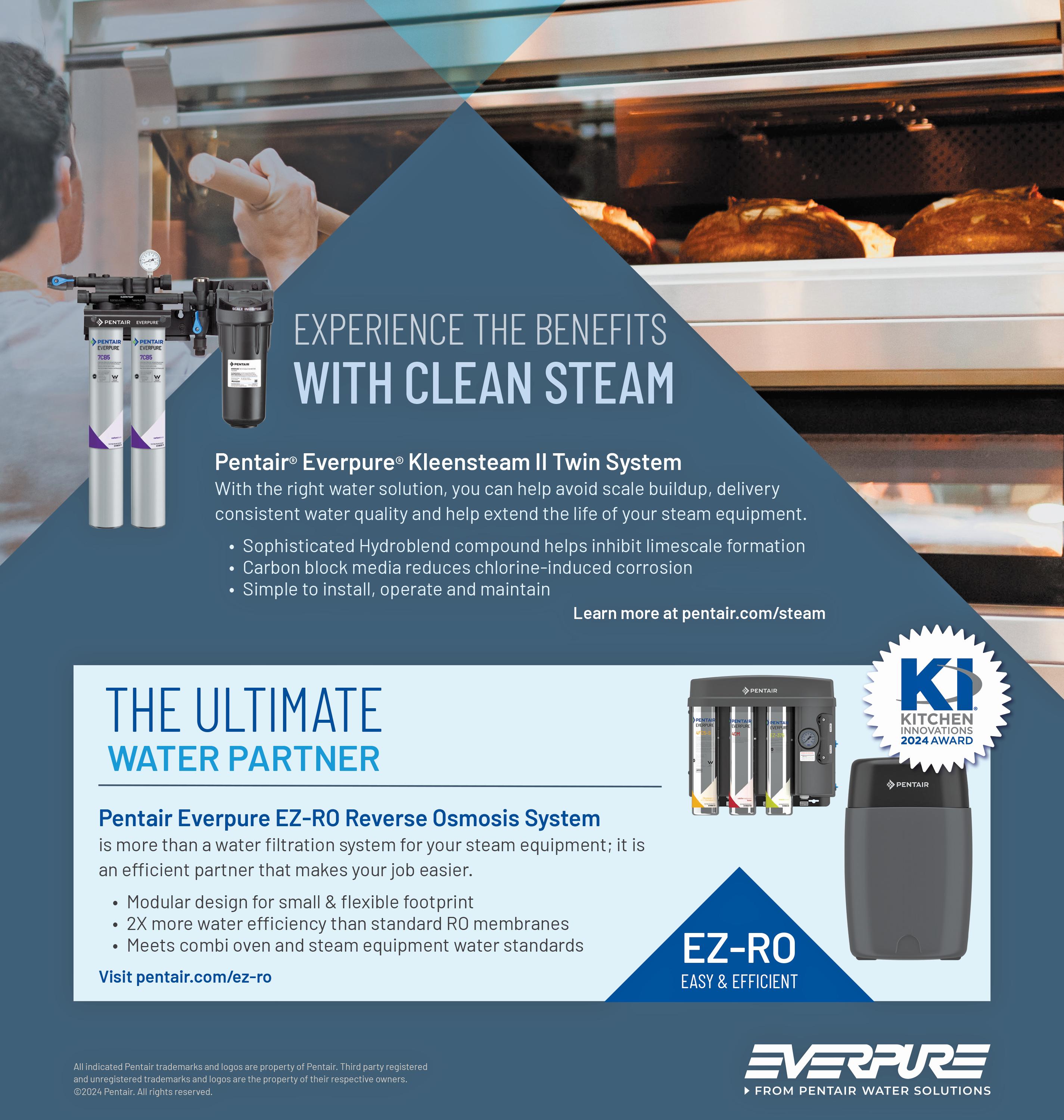
dishes. Different versions of risotto predominate and feature a remarkable range of ingredients and flavors. But there are also arancini, suppli, timbales, rice-stuffed vegetables, and desserts.
Each dish is show plated. Measurements are in the metric system.
Keep it Zesty: A Celebration of Lebanese Flavors and Culture from Edy’s Grocer by Edy
Massih
Taking over a neighborhood deli in Greenpoint, Brooklyn, Lebanese-born Edy Massih–who’d attended the CIA and worked in NYC restaurants–brought a bright and vivid new presence to the block.
Drawing on fresh spices and flavorings, updating traditional Lebanese dishes, or co-opting American standards, Massih is a pantry guy, creating his own herb blends, making his own pickles, jams, and preserves, and using them boldly and deftly in dishes such as:
• Chocolate tahini overnight oats
• Charred corn, tomato, and halloumi salad
• Pistachio-crusted lamb chops
• Turkish coffee tiramisu
Also included is Massiah’s signature Brown Paper Board, a hangloose spread of appetizers, cheeses, meats,

salads, spreads, and almost anything else you like that dispenses with platters in favor of, you guessed, it, brown kraft paper. Bold and fun.
Editor’s Note About Podcasts- Listen and subscribe wherever you get your podcasts, including on Apple Podcasts, iHeart, Spotify, Stitcher, Google Podcasts, Audible & more.
A six-episode podcast series Breaking Waves shines a spotlight on ways top visionaries are bringing topics like geopolitics, artificial intelligence technology, and more into the future of ocean conservation.

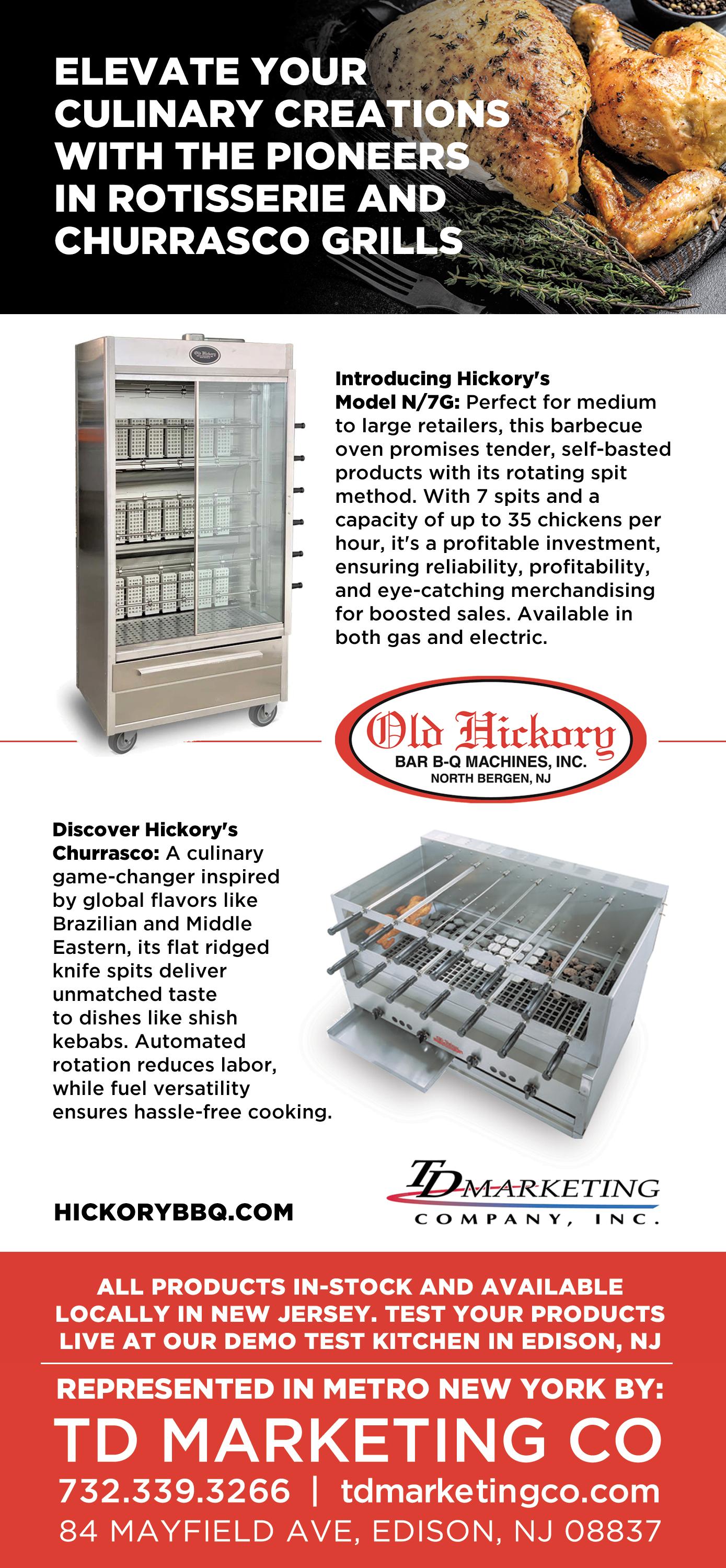
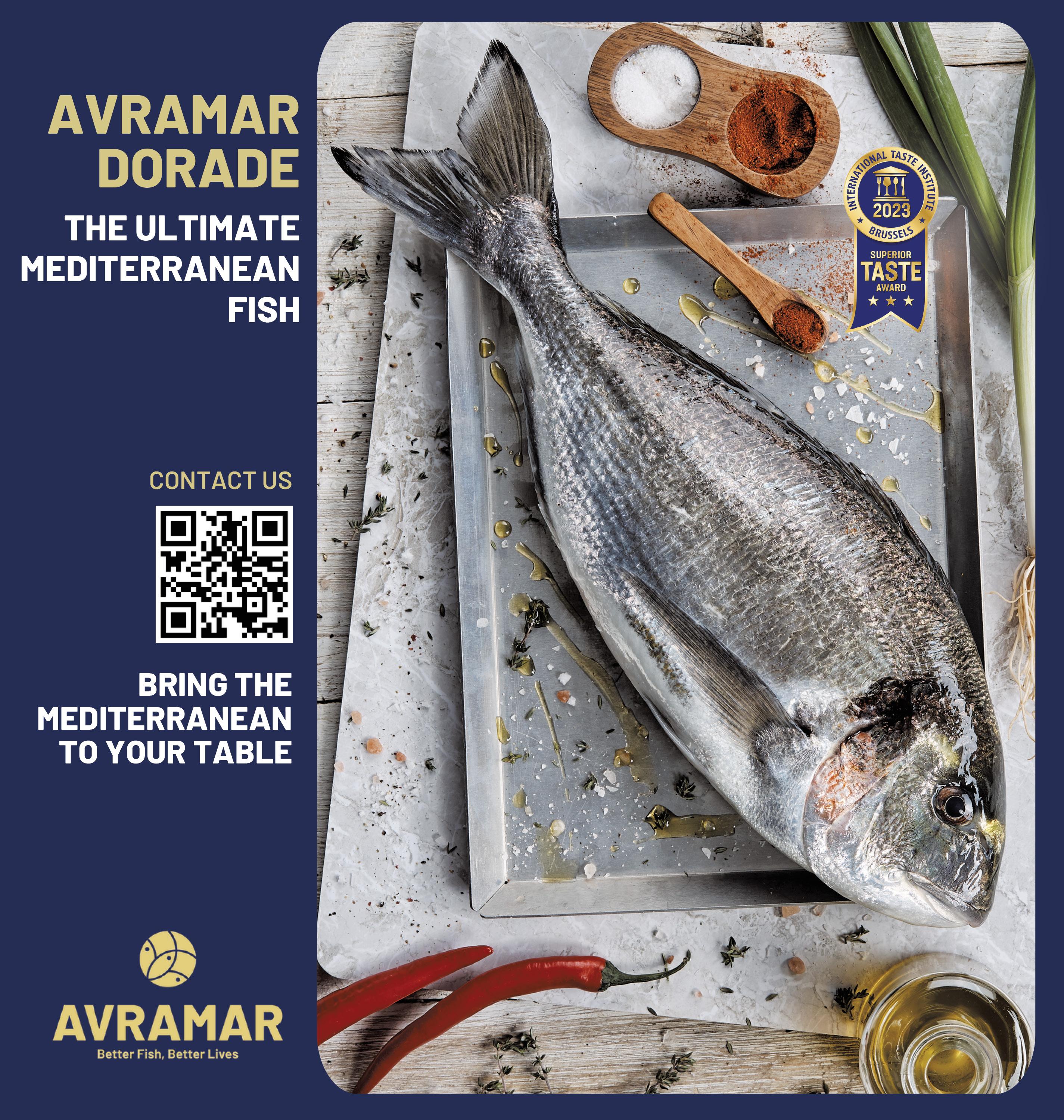


By Parker Shatkin
In 2024, giving back to the community is more important than ever, but finding ways to successfully make an impact can be difficult. The Joy in Childhood foundation, powered by Dunkin’, has managed not only to give back locally but to spread their reach nationwide. Between offering grants and setting up volunteer events, the Joy in Childhood foundation has impacted millions of children nationwide, providing resources to kids battling sickness or hunger.
The Joy in Childhood foundation was founded as an independent 501(c)3 organization in 2006. What began as a humble effort has grown into a national program, embodying the spirit of philanthropy within the Boston area and beyond. Although they are an independent organization, the Joy in Childhood foundation works in affiliation with Dunkin,’ which provides partnerships with local stores across the country. “As a Dunkin’ franchisee, it’s very important to give back, especially in our own communities,” said Victor Carvalho, the foundation’s president.
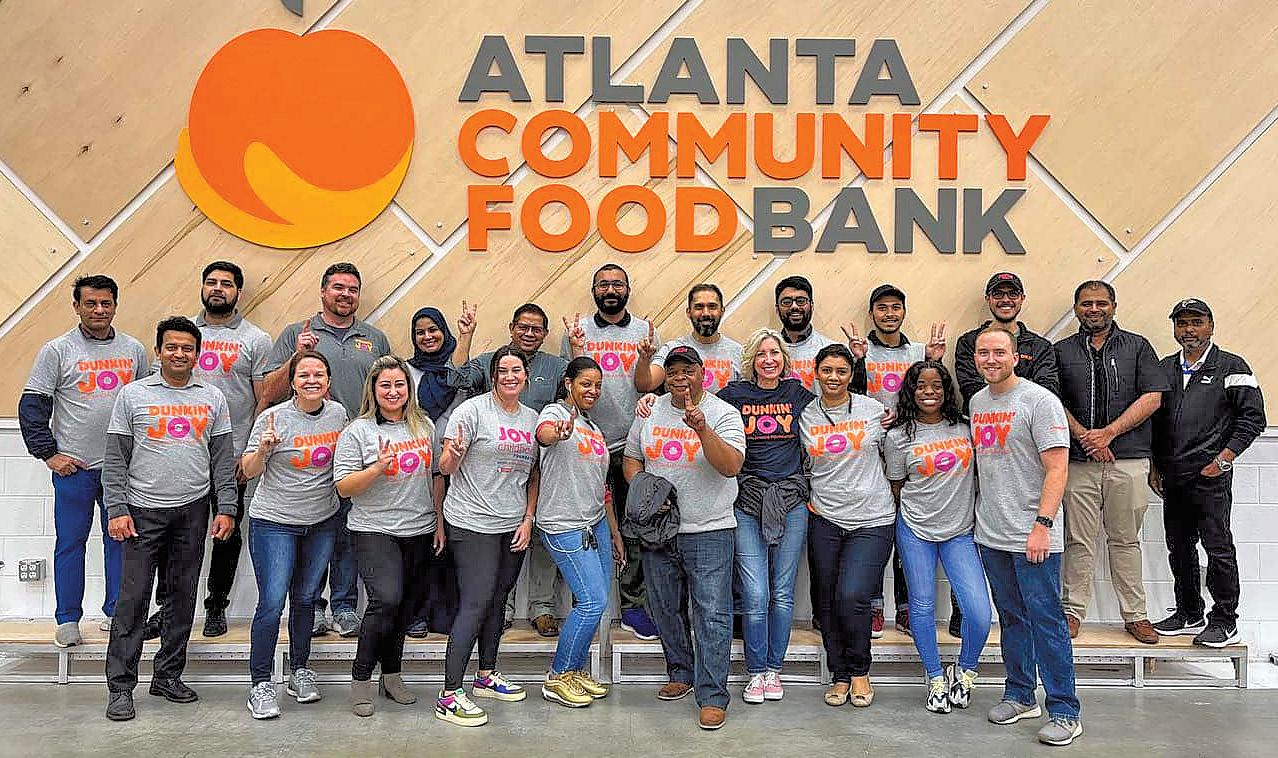
“There’s no better feeling than putting a smile on the face of a kid who is struggling.” Carvalho hopes that someday the kids they help will be inspired by their work to give back to their own communities in turn.
Carvalho’s jump from franchisee to philanthropist has been incredibly successful; in 2023, the foundation raised $16 million to be used for their signature grant programs. These grants go to food banks, school food programs, hospitals,
and community health centers nationwide, providing crucial support for organizations helping children and families dealing with sickness and hunger. When asked how they choose which organizations receive grant funding, Carvalho noted that the foundation chooses organizations that they know will use the money to support the community, and that they make an effort to expand their reach by awarding grants to organizations across the country; for example, Carvalho mentioned a food bank in San Diego who was a recipient of one of the foundation’s grants after the floods. “Of course, we want to serve our own com-
munity in the Boston area, but we also want to spread our reach across the country,” he said.
There is no doubt that the support for these organizations is necessary now more than ever. “What we’re seeing is that since the pandemic, our grant applications have increased yearly. There’s definitely a growing need for us to step in where we can,” Carvalho said. Although the growing need is notable, the foundation has been able to provide continued support, and to expand their team of volunteers at the same time. “Back in 2014, we used to do one week of volunteer events,” he said. “With the involve-
“There’s no better feeling than putting a smile on the face of a kid who is struggling.” — Victor Carvalho
ment we’ve had, we’ve made it into a month-long event.” Joy in Childhood’s volunteer events are different from those in which a company might go volunteer at a food bank for a day—“Here, you may be standing next to a franchisee or a director of operations and you’re all just team members.” Organizing these volunteer events is not only a way to give back to the community but fosters a spirit of collaboration and support among team members at all levels. These events also allow volunteers to see the impact of their efforts in real time. The foundation was able to award over 600 grants across the country in 2023, but to be able to be personally involved in the process is a valuable experience for team members as well as the children and families they are helping.
Dunkin’s Joy in Childhood foundation aims to continue to provide these services for as long as there is a need for them. Looking ahead, their goal is to continue growing the foundation, increasing their philanthropic reach, and amplifying their impact on communities across the nation. “Of course, we would love it if we could get to the point where no child in the country needed the support of our foundation,” Carvalho said. “But as long as they are, we intend to continue to provide our support.”
Organizations looking to apply for grants and corporations interested in partnering with Dunkin’s Joy in Childhood foundation can do so at joyinchildhoodfoundation.org.

By Sophia Maggio
For restaurateurs in 2024, the legal implications of “compliance” extend well beyond matters of health code into the digital realm. The Web Content Accessibility Guidelines (WCAG), legally enforced in the U.S. by the Americans with Disabilities Act (ADA), require restaurateurs to maintain the health of their websites – or risk very physical consequences.
This is where Jacquie Sherry Coombe, Co-Founder and COO of Elite Strategies, enters the scene – and with a full team of experts behind her. A self-described “Manhattan girl”, Coombe began her career in hospitality marketing in New York, continuing her family’s decadeslong legacy in the restaurant industry.
As a young hospitality professional, Coombe worked for a major New York City based restaurant company as well as night clubs, and later shifted into a development and operations role before joining moving into the hotel industry. “Even though I had a great career at the time, I had a one-year-old child and was

looking for ways to redirect my professional path,” she reflected.
Serendipitously, Coombe’s husband, Patrick Coombe – CEO and Co-Founder of Elite Strategies and a U.S. Navy Veteran – had years of experience with computer programming, IT, and related consulting work. The business-savvy couple decided to merge Patrick’s technical expertise with Jacquie’s ability to manage teams and leverage connections in the hospitality world.
The resulting enterprise began in 2009 as a service for small businesses: a focused period that “we loved and learned from,” Jacquie said. “But over time, we started working with hotel and restaurant groups, international and national brands, and evolved into a full-service, 360-degree digital agency.”
Today, Elite Strategies is an international provider of internet marketing and design services. The company’s team includes professionals with backgrounds in web development, advertising, design, content creation, digital accessibility, and search engine optimization (SEO).
“Sometimes, clients think they just need a ‘creative team’ or a ‘development team’ for particular needs,” Coombe described. “But at Elite Strategies, we recognize and position our value as a full-service company that pulls expertise from different professional walks of life.”
This dynamic skillset is invaluable, especially in view of stringent ADA regulations. Coombe traced some of the most consequential ADA changes to 2016, when the scope of ADA-identified disabilities expanded to include seizure disorders, learning disabilities, dyslexia, and other conditions.
“But, given our established digital expertise and experience, we were able to provide evidence for clients’ legal teams, document the clients’ remedial actions to make their websites ADA-compliant, and help them settle their cases at significantly lower amounts.” — Jacquie Sherry Coombe
“The situation became very serious, and several restaurant and hotel groups found themselves in litigation due to ADA noncompliance,” Coombe shared. “But, given our established digital expertise and experience, we were able to provide evidence for clients’ legal teams, document the clients’ remedial actions to make their websites ADA-compliant, and help them settle their cases at significantly lower amounts.”
“We can’t say enough about the invaluable role that Jacquie and her team have played in helping my clients in the restaurant industry meet ADA compatibility for their websites,” noted Amanda Fugazy, a leading industry attorney specializing in restaurant law at Ellenoff Grossman & Schole LLP. “It’s become a moving target that demands someone that is tuned into the constant changes in compatibility requirements.”
“Elite Strategies offers a range of services from text and images changes to ensuring proper heading structures, and even providing keyboard navigation options,” Fugazy added. “These changes not only make the website more accessible and user-friendly for individuals with disabilities but also improve overall user experience.”
Coombe could not have anticipated
this ADA-induced turn, nor prepared to provide these services by obtaining a specific degree. “There are no certifications or formal educational programs for this kind of work,” she noted. “We had just worked with so many websites and clients, and established trusting relationships with them, that they started coming to us with these concerns.”
Many clients lack the time and expertise to keep up with the ADA, WCAG, and other digital and legal developments. As a result, “a lot of our remedial work now takes place in litigation; and at that point, there’s nothing you can do to stop it completely,” Coombe concluded.
What restaurateurs and other business owners can do, Coombe advised, is “get their websites assessed for accessibility right away.”
“Once you’re too far gone, the lawsuits can and will happen,” she said. She offered the hypothetical of a hotel group with hotels in 12 locations: “Say they get a suit for one location; pretty soon, the suit would simultaneously hit every other location.” E-commerce sites, restaurant and hotel groups, and gourmet shops are especially susceptible to this kind of legal action, Coombe said.
continued on page 120

Trade shows have always been a vital part of the business world, serving as a platform for professionals in various industries to gather under a single roof to share and source new ideas, products, and technologies. In recent years, trade shows have become more important than ever, especially in industries such as the restaurant and food service industry. The annual National Restaurant Association (NRA) show has become a focal point for the industry, showcasing

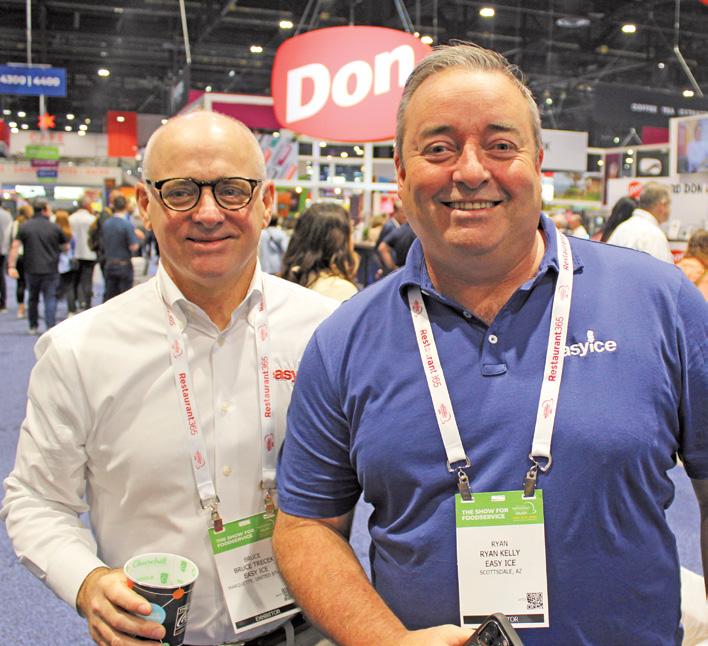
the latest in food, beverage, equipment, and technology.
In the restaurant and food service industry, trade shows like the NRA show play a crucial role in helping businesses grow and stay competitive in a rapidly evolving market. With the challenge of a shrinking workforce and increasing minimum wage, restaurants and food service establishments find themselves at a crossroads in how to maintain the tradition of face-to-face hospitality while also keeping their doors open with


reasonable profitability.
The recent NRA show provided restaurant and food service professionals with a valuable opportunity to network with industry peers, learn about the latest trends and innovations, and discover new products and technologies that can help streamline their operations and improve customer satisfaction. These events also offer a platform for industry leaders to come together and discuss pressing issues facing the industry, such as labor shortages, rising costs, and

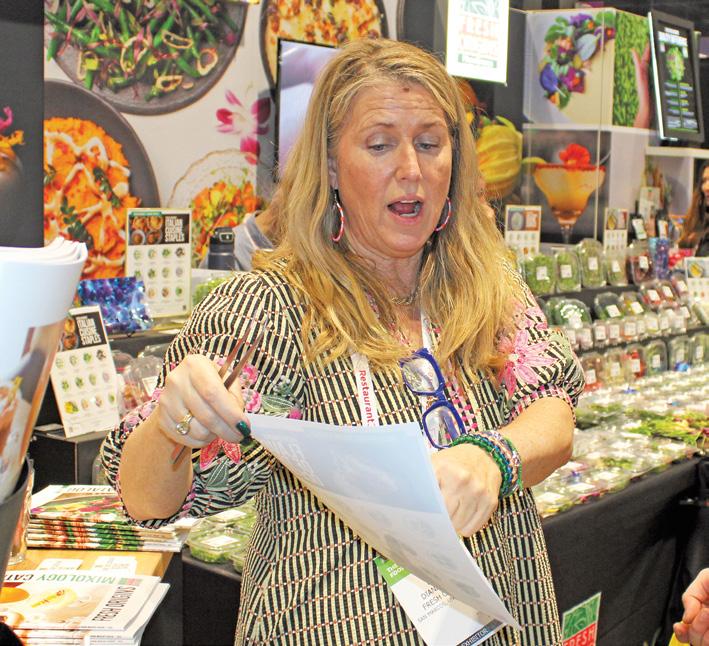
changing consumer preferences.
The annual Chicago event enabled restaurant and food service professionals to build what we are calling a “sense and cents” balance moving forward. The show was all about maintaining the traditional values of face-to-face hospitality between server and guest in today’s dramatically different environment. Restaurateurs that attended the NRA Show were introduced to solutions that
continued on page 72




enable efficiency, cost-effectiveness, and innovation as they battle to position themselves for success in an increasingly competitive market.
“The Show has long been the birthplace of innovation, where industry leaders converge to shape the future of foodservice,” noted Tom Cindric, President of the National Restaurant Association Show. “With a line-up of exciting offerings—including the 20th anniversary of

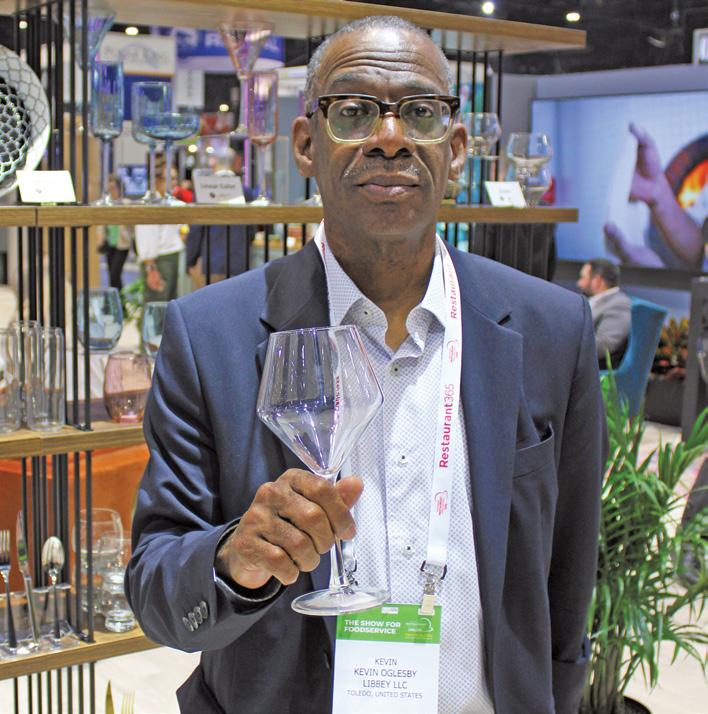

the Kitchen Innovations Awards, the exceptional trend-setting recipients of the FABI Awards, the debut of our new Expo + Education program, and an expansive Show floor spanning a space larger than 12 football fields—we’re thrilled to have offered participants an unparalleled experience, igniting growth, fostering collaboration, and inspiring all who attend.”
Among the highlights of The National Restaurant Association Show floor in-
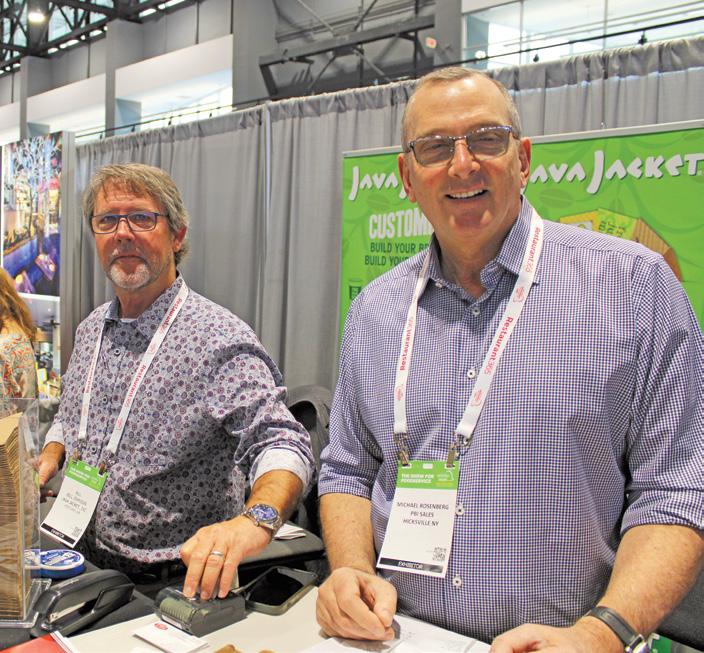


cluded over 2,240 exhibitors spanning over 720,000 square feet with over 900 product categories on display, ranging from food and beverage to equipment, technology, AI-powered solutions, and emerging global flavors. Cindric and his team understand the value of Specialty Pavilions, dedicated to showcasing the latest offerings, innovations, and curated experiences tailored to specific interests from across the nation and the world.



These included: A Taste of the States, Bellavita Italian Pavilion, Iberica Spanish Pavilion, The Beverage Room, Global Food Expo, Organic & Natural, the TECH Pavilion, and the Startup Alley. This year, several key trends stood out on the Show floor, reflecting the evolving consumer demands for seamless customer service, convenience, and memo-
continued on page 74


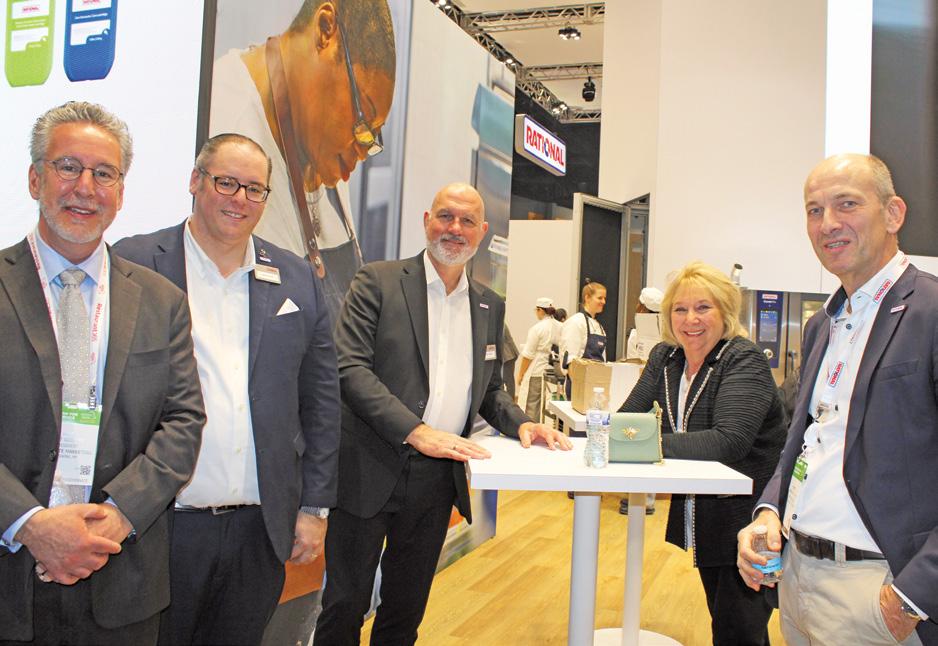

rable experiences. One major trend was the focus on flavor experiences, with restaurants embracing global flavors, playful plating, and health-conscious options to captivate consumers. Another prominent trend was the integration of technology to enhance convenience, including AI-driven solutions such as voice assistants that enhance customer service, kitchen equipment with built-in sensors that free up staff, as well as in-
novations in AI-generated plant-based food development. Sustainability continued to be a critical focus, with many exhibitors highlighting eco-friendly products and zero-waste initiatives that set new standards for food production. Additionally, the rise of snacking as a response to changing consumer lifestyles was evident, with a variety of convenient and indulgent snack options on display.
The legacy of the NRA for decades has
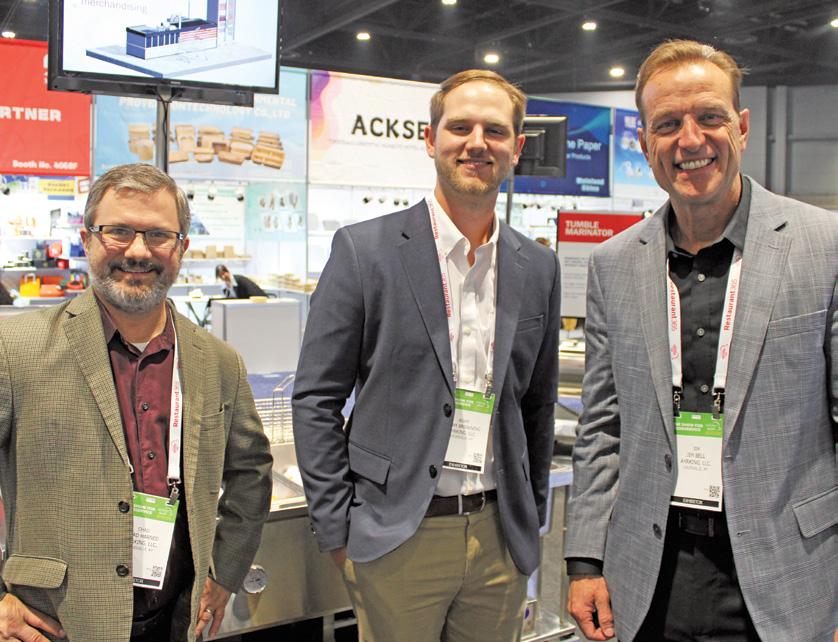
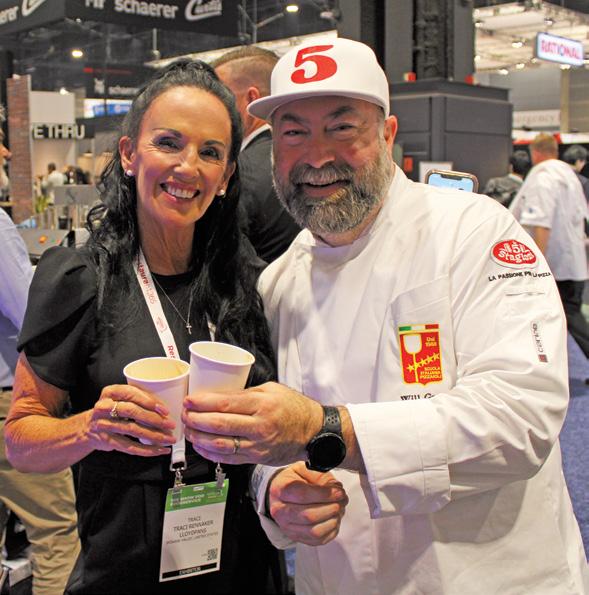


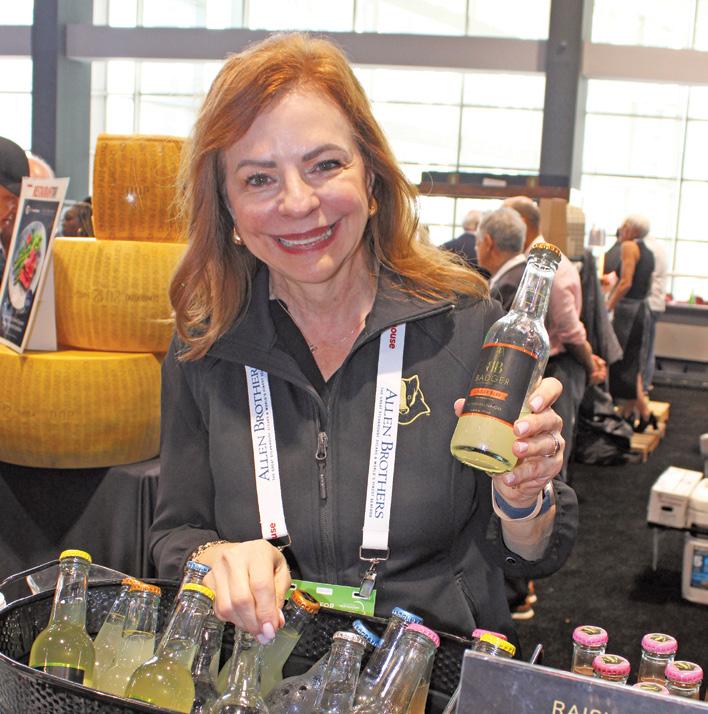

been its ability to draw major industry and political figures (Presidents Regan and Bush 1&2!) from across the globe as keynoters. The ‘24 edition of the show combined both with a captivating discussion with acclaimed chef, restaurateur, and humanitarian, José Andrés. A true visionary in both the culinary and humanitarian realms, Andrés explored the profound influence food can have on communities and how his culinary



journey has intertwined with his philanthropic efforts.
The NRA show also celebrates the industry with a number of both on-site and off-site award ceremonies. The FABI Awards spotlighted the most innovative and forward-thinking flavors of the year, driving trends and satisfying today’s consumer demands for more sustainable
continued on page 76




and eco-friendly products. For 2024, 35 recipients were selected as industryaltering products that shape what’s new and next for the future of food and beverage.
The annual Kitchen Innovations (KI) Awards celebrated 25 foodservice equipment innovations that improve operations and generate growth through advances in automation, efficiency, safety enhancements, sustainability, and


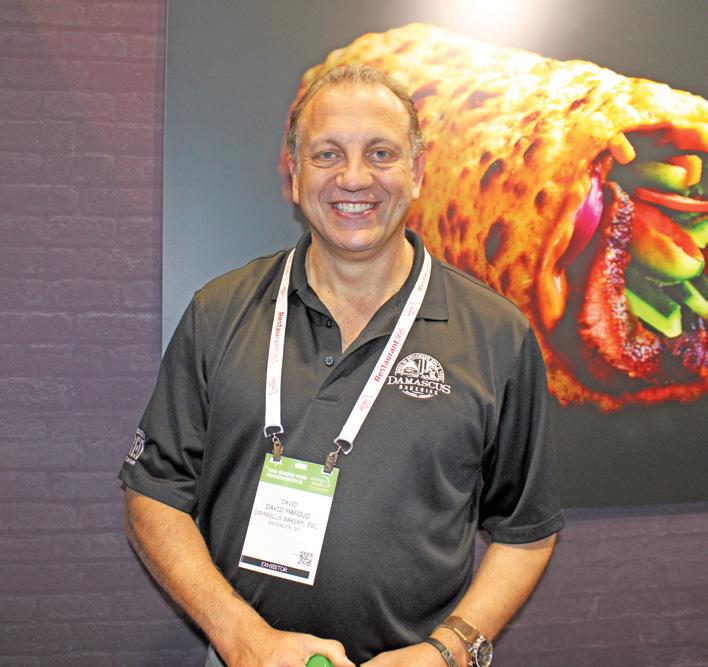
more. Spurred by evolving landscape of technology and developments in AI, robotic solutions, autonomous ordering, and customer service, KI Awards have expanded beyond back-of-house operations to recognize innovations that also offer labor, waste, and energy savings.
This year’s show also offered a full slate of Celebrated Chef Demos Chef Brian Duffy hosted a live P&L consulting session, providing practical insights into


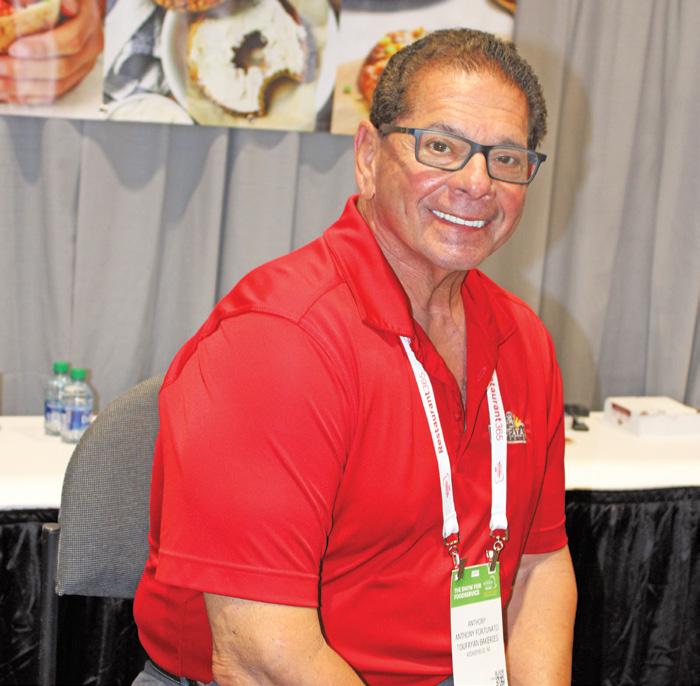
menu assessment and budget management. The Culinary Experience equipment providers are Atosa USA, Inc., Hobart, Middleby Corp., Robot Coupe USA, Inc., Southbend, Traulsen, and Tramontina USA.
Mixologists and beverage experts were on-site to demo creative and unique techniques on the Beverage Room Stage and shared their outlooks on topics such as culinary and cocktail pairings, non-

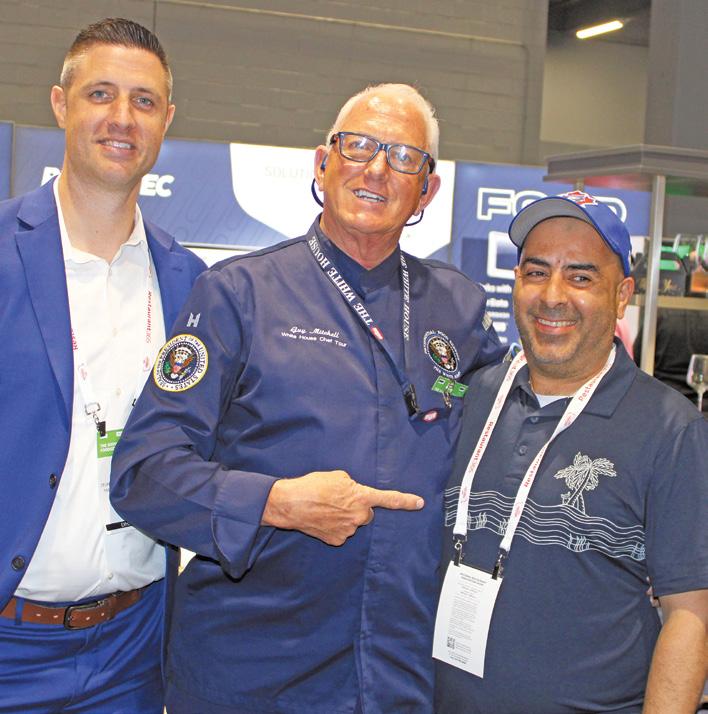

alcoholic innovations, aperitivo culture, global spirits exploration, and healthconscious cocktail trends, alongside other cutting-edge developments in the beverage industry.
Among the most notable “NRAWeekend” events was the annual IFMA Golden Silver Plate Awards Celebration in Chicago event, held in the beautiful
continued on page 110

One the nation’s leading independent food brokerage firms, AJ Letizio Sales & Marketing, was well represented at



Foley & Lardner LLP, a national law firm, was recently sued by an incoming associate after the firm rescinded the associate’s job offer the day before she was supposed to start working for the firm. The firm announced that its decision was based on the associate’s public comments on the Hamas October 7th attacks, likely referring to a speech the associate made where she said the Hamas October 7th attack on Israel was the “natural response of 75 years of occupation and violence by Israeli forces.”
As tensions continue to rise over the Israeli-Palestinian conflict more people are speaking out and voicing their unpopular opinions on social media. Employers aren’t too thrilled about their employees gaining notoriety over
Starting off, what about the common go-to argument, “I can say whatever I want, this is America, I have free speech.” The answer to that is: “No, not really.”
their political views, especially when it causes workplace drama or brings unwanted attention to their business. But can you fire your employee for taking a political stance? In New York, the answer isn’t as simple as “yes” or “no”. Starting off, what about the common go-to argument, “I can say whatever I want, this is America, I have free speech.” The answer to that is: “No, not really.” The First Amendment of the U.S. Constitution prevents only the
government from punishing you for your speech, and even then, numerous exceptions apply. In a conversation between you and me, the words “free speech” don’t mean much. Similarly, the First Amendment doesn’t prevent an employer from firing an employee because of something they said, but that doesn’t mean employers should go around casually firing employees based on their political speech.

Several federal laws protect specific types of employee speech. For example, Federal whistleblower laws prohibit employers from firing or retaliating against employees who report fraud, corruption, or other dangers to public health and safety.
Title VII of the Civil Rights Act of 1964, protects employee’s rights to speak out against unlawful workplace discrimination or harassment. The National Labor Relations Act protects employees’ rights to discuss and engage in protected concerted activity (when employees work together to improve their working conditions, typically by forming a union).

Peter Wilms is an Associate in the Labor & Employment Group at Ellenoff Grossman & Schole LLP. Mr. Wilms represents management in wage and hour litigation, traditional labor relations, ADA Title III violations, legal compliance and more. He provides counseling services to businesses operating across the hospitality industry and beyond in unionized and non-unionized settings. He previously represented educational institutions and municipalities as general counsel and handled all manner of labor-management and employment compliance matters. Mr. Wilms can be reached at (212) 370-1300 or pwilms@egsllp.com.
The New York Labor Law prevents employers from firing or refusing to hire a person because of their “political” or “recreational” activities. What conduct qualifies as a “political” activity remains unclear and state courts have provided little clarification. The consensus is that it narrowly applies to political actions, such as running for a political office, assisting a political campaign, or engaging in political fundraising. “Political” speech on controversial social issues, such as immigration, abortion, or crime policy, that does not fall within one of those categories, is not protected by the statute. Can you fire an employee for their political speech? As long as the employee’s speech isn’t protected by federal or state law, then yes, you can. But “Should you fire them?” is a whole different question.
Even if an employee’s speech isn’t protected by one of these laws, firing an employee for their speech can easily create an opportunity for them to turn around and sue you for unlawful discrimination. Some speech may be closely associated with characteristics that are protected by federal and state anti-discrimination laws, such as race, continued on page 115


In the current dining landscape, consumers’ demand for clean, antibiotic-free proteins continues to soar. According to Persistence Market Research, global sales of antibiotic-free proteins are projected to jump from $148 billion to $445 billion by 2032. With consumers in search of clean-label food solutions, foodservice professionals are called to adapt their menus to this dynamic shift in diner preferences.
While antibiotic-free (ABF) protein has become the industry standard driven by consumers’ expectation for transparency in poultry and beef, there appears to be a consumer knowledge gap around antibiotic-free seafood options like salmon. In a primary research study polling more than 800 consumers, 40% of participants were uncertain if the salmon sold in stores was antibiotic free. More interestingly, 42% stated that buying ABF salmon was important to them.
Seasoned chefs are partnering with ArkA, a trailblazer in the antibiotic-free protein niche, that proudly stakes its claim as the world’s first brand offering a full line of fresh, frozen, and smoked salmon products that uses no antibiotics never-ever. ArkA consistently delivers on its promise to keep its salmon antibiotic-free at every stage of the process – from farm to table. ArkA’s commitment represents a major industry breakthrough, guaranteeing consumers and foodservice professionals a fully transparent product so that chefs can feel confident when displaying their antibiotic-free menu options.
The value customers place on their food’s origin and production methods, as well as its environmental impact, fuels their willingness to pay a premium for these options. Recent menu trans-
parency partnerships between national fine dining restaurants and ArkA have proven to lift sales and help empower diners to make choices that are in line with their values.
Here’s 3 ways ArkA is changing the game for foodservice professionals and
guests alike.
1. Ultra-premium quality protein: Going beyond the antibioticfree promise, ArkA distinguishes itself through the exceptional quality of its salmon. ArkA’s salmon provides a top-


tier culinary experience with its brilliant color, incredible taste, and clean finish. In the competitive world of fine dining, every ingredient counts. When it comes to salmon, the colder the temperature of the water they’re raised in, the higher the fat content will be. ArkA hails from icy, pristine Antarctic waters, ensuring you get quality fatty fish with high omega-3 content. The brand prides itself on the absence of artificial colors, preservatives, flavors, sweeteners, and other harmful ingredients, ensuring full transparency throughout the process. Offering the purest salmon, ArkA is renowned for its versatility making it easy for fine-dining chefs to have flexibility in their menu development. With a select few ArkA products, chefs can create sashimi-grade menu concepts or reinvent dozens of premium dishes, saving time and money.
2. Commitment to animal welfare: ArkA treats its fish well by providing optimal conditions for development, in turn producing a higher quality product worthy of an ultra-premium menu. Achieving an optimal, stress-free living environment for the salmon is key, with daily observations and regular veterinary visits in place. ArkA increases seabed oxygen conditions, prevents organic waste from contaminating the seabed, protects marine life, and leads initiatives to clean up surrounding coastlines, ensuring a healthy environment for the salmon to thrive in.
3. Certifications and Sustainability: Born of Multi X, ranked in the world’s top 4% most sustainable food companies and the first company to ever be ranked in both the FAIRR Coller and Dow Jones Sustainability In-
continued on page 108

Metro New York’s leading Healthcare foodservice executives met last month at the Sheraton LaGuardia for their annual Educational Seminar and Vendor Exhibition with a theme of: “Elevate... New Perspectives in Healthcare Food Service”.
Nearly 100 members from the TriState healthcare dining community were challenged by a wide diversity of topic and speakers. The annual event began with Simone Nicolas, MS, RDN, CDN, President of AHF-NY and Kingsboro Psychiatric Center welcomed the gathering. AHF National Program Manager Sarah Bennett outlined the 2024 initiatives of the organization.
The keynote speaker Leisa Bryant, Executive Director, Food and Nutrition & Patient Transportation, University of Texas M.D. Anderson Cancer Center, then focused on Unlocking the Power of Your Brand: Moving from Ordinary to Extraordinary.
The vendor floor was abuzz with several new ideas. From the latest in nutritional menu addition ideas to

energy efficient equipment and green and sustainable cleaning solutions, Metro New York’s healthcare dining professionals had their choice of many new ideas.
As with all aspects of business across Metro NY and the nation, AHFNY took on the sensitive subject of the role of Artificial Intelligence (AI).
Amanda Maucere, MS, RDN, LDN of the Florida Department of Health


addressed the New Technology in Healthcare Food and Nutrition.
As with so many segments of foodservice, industry professionals continue to work towards understanding the role of plant-based items on menus. Lianna Levine Reisner, of Plant Powered Metro New York shed light on successful strategies on the
continued on page 118





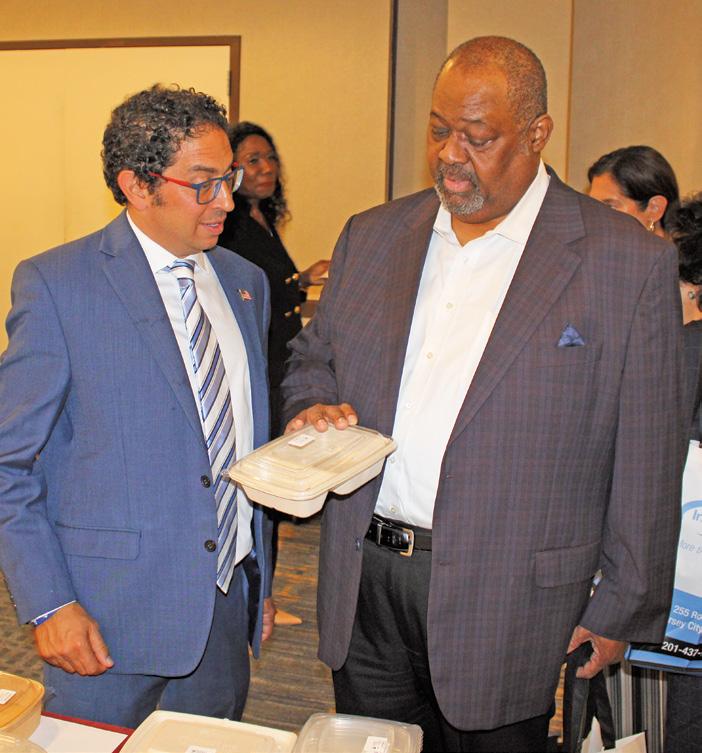

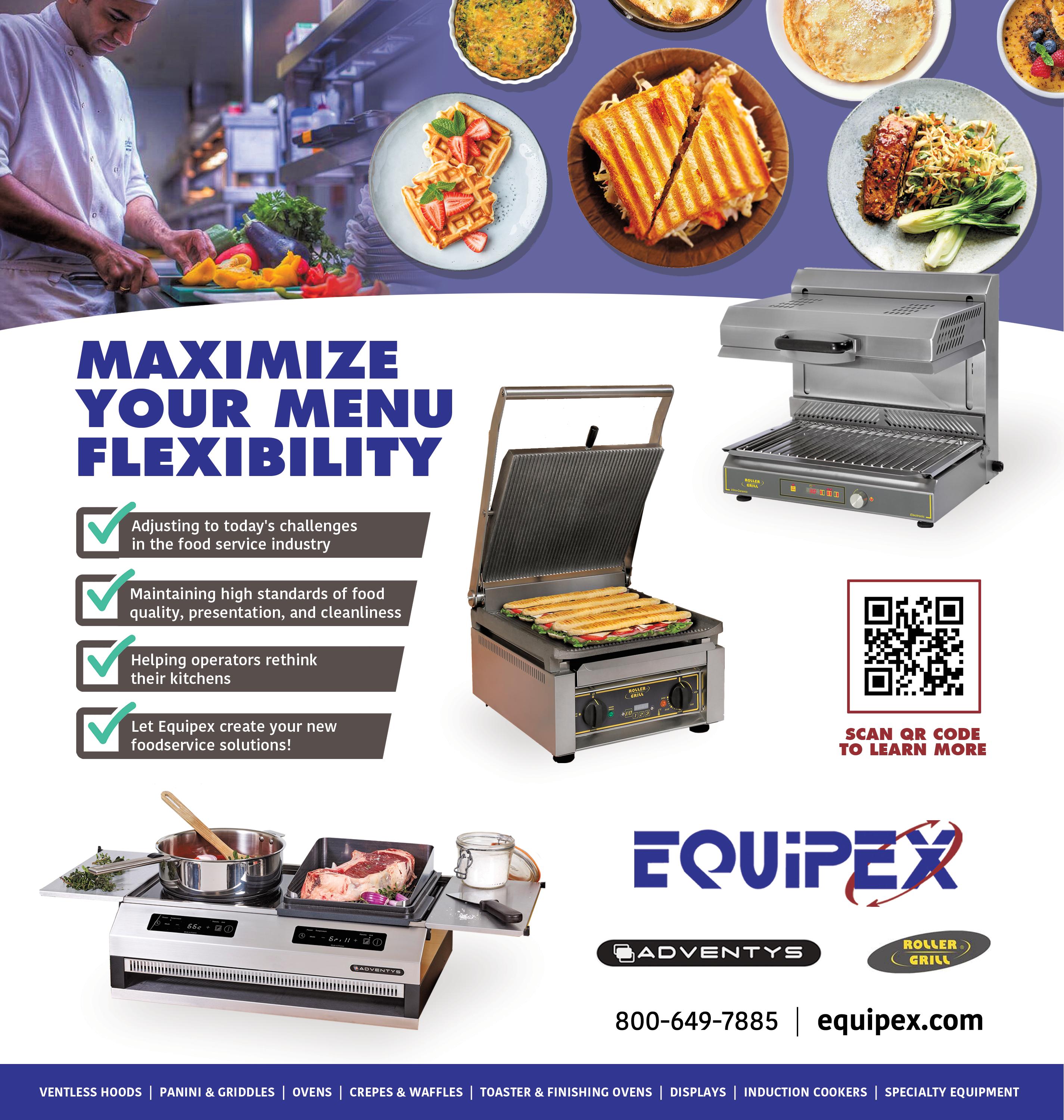
Since its invention in 1945, the microwave has remained a staple appliance in both home and commercial kitchens. With the ability to quickly cook and raise the temperature of a food product, microwaves assist in optimizing both efficiency and food safety. These days, the marketplace is crowded by combitechnology and smart kitchen gadgets, making it easy to overlook the humble microwave. However, a long-lasting, quality microwave has an essential role in any commercial kitchen.
“The microwave has never received the respect it deserves,” said Steve Stohrer, President of the Midea Brand at Empire Marketing Group. “But it provides a service like no other.” As the largest appliance and microwave manufacturer in the world, Midea is consistently revolutionizing the field of commercial kitchen appliances, with microwaves currently at the center of their business.
Midea grew as an OEM company and spent many of its formative years building ovens for well-known brands. In 2017, when Empire Equipment became Midea’s North American master distributor, Stohrer teamed up with Ken Megarr, Midea’s R&D Culinary Applications Chef and Product Manager to launch a new line of commercial microwaves. The veteran duo, who previously worked together in the Panasonic microwave division for over than 25 years, have collaborated with Midea and introduced a brand
“Since our launch, our name and products have quickly gained recognition, establishing us as a dominant force in the category within a short span of time.”— Steve Stohrer
which is designed and built on the valuable insights gained from a combined 60 years of expertise in the field. Key features with unique product design, an unrivaled distribution model, and unmatched warranty support clearly distinguish themselves in the category. Due to their impressive lineup. Midea has managed to build a large testimonial list, featuring many well-known restaurant chains, major vending accounts and high-volume food service equipment dealers. “Since our launch, our name and products have quickly gained recognition, establishing us as a dominant force in the category within a short span of time” Stohrer said. TD Marketing, who represents and distributes Midea in the major metro area of New York and Philadelphia, has assisted in the contin-
ued growth of the Midea brand.
Currently, the line consists of 10 commercial microwave models of varying sizes, ranging from 1000-Watt to 2100Watt machines. The diverse offering has models for all applications whether your quick serve, casual dining, fast casual or vending
Additionally, Midea’s products follow its Green Strategy, which was unveiled in 2021. Under the Green Strategy are various sustainability goals, including a target of achieving carbon neutrality by 2060, and six core pillars, including green design, green procurement, and green manufacturing.
Besides Midea’s varied and sustainable microwave line, the company also
continued on page 113
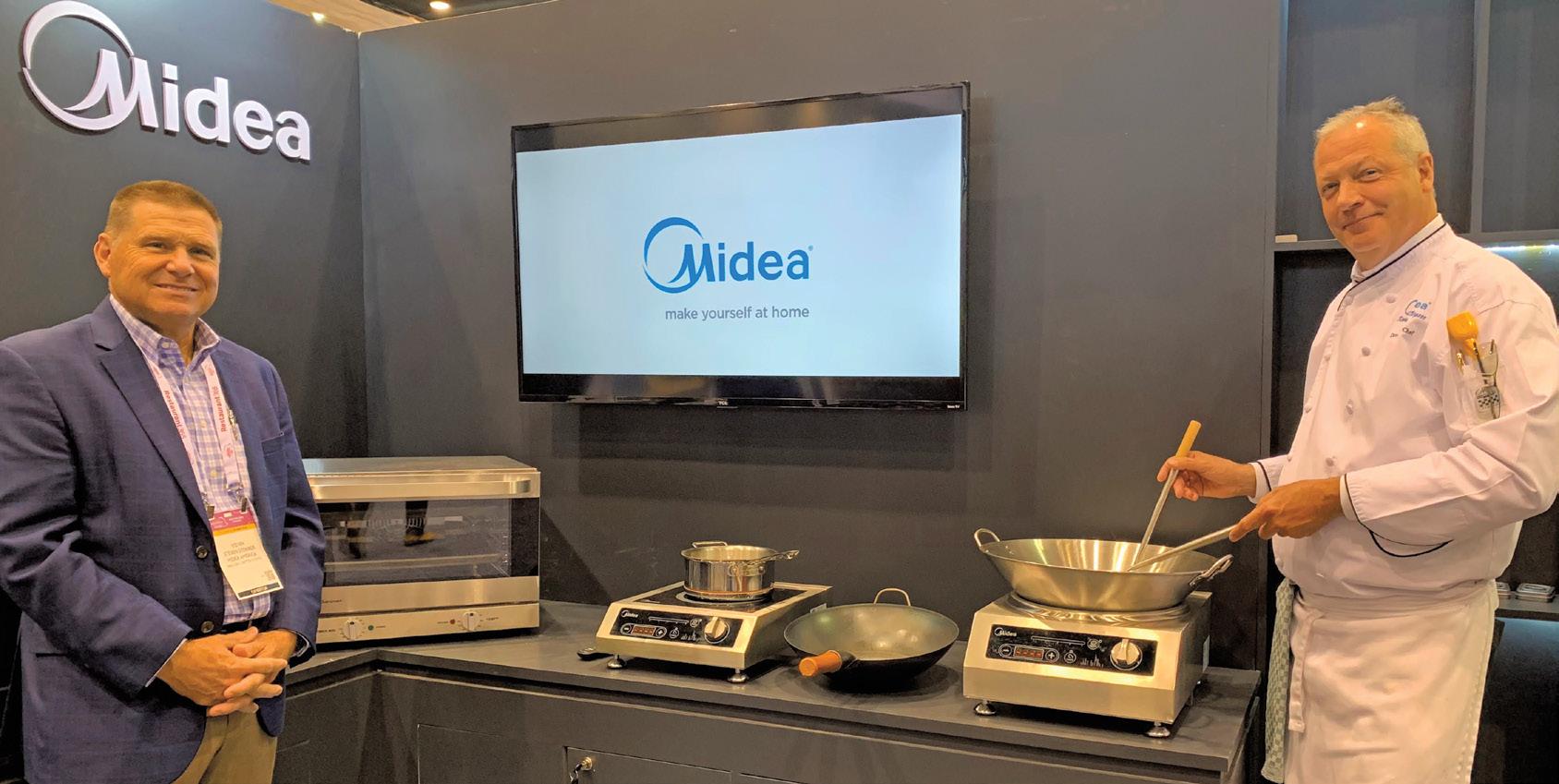
Microwave ovens are often overlooked as the greenest pieces of equipment in the kitchen because they have become so commonplace.
• Microwave ovens feature Instant-on and instant-off feature that reduces energy consumption because they eliminate pre-heating and don’t produce any residual heat.
• Unlike so many pieces of both hot and cold equipment in a kitchen, when a microwave is not in use, it utilizes/ wastes NO energy.
• Remember covering the food you microwave is a USDA requirement!
• So don’t forget the basics of microwave cooking like always covering the food so it STEAMS and locks in flavor and nutrients by making the cooking more even.
• A Cornell University study documents the nutritional benefits of steaming vs other cooking methods.
• Don’t forget to keep the inside of your Midea Commercial Microwave clean so that flavors pop and you minimize energy consumption and lock in nutrients!
Our Midea team is here to help with any questions.


Inline Plastics, a leader in innovative packaging solutions, recently announce the expansion of its acclaimed Flip n’ Mix tray collection with the introduction of two new offerings. Designed to revolutionize the packaging of fresh toppings, these trays empower culinary creativity while elevating presentation standards.
Crafted with meticulous attention to detail, the Flip n’ Mix trays feature a single open well, ensuring unfettered freedom in topping placement. The trays are compatible with the all-clear 7x7 squares, providing a 360-degree view of the tantalizing ingredients within. By strategically positioning toppings at the forefront and holding them snugly near the lid, these trays effortlessly showcase their contents, enhancing visual appeal.
fers increased depth, accommodating a diverse array of topping options to suit varying preferences. Ideal for packaging salads, these versatile trays mark another milestone in Inline Plastics’ commitment to delivering cutting-edge solutions that meet the evolving needs of the food industry.
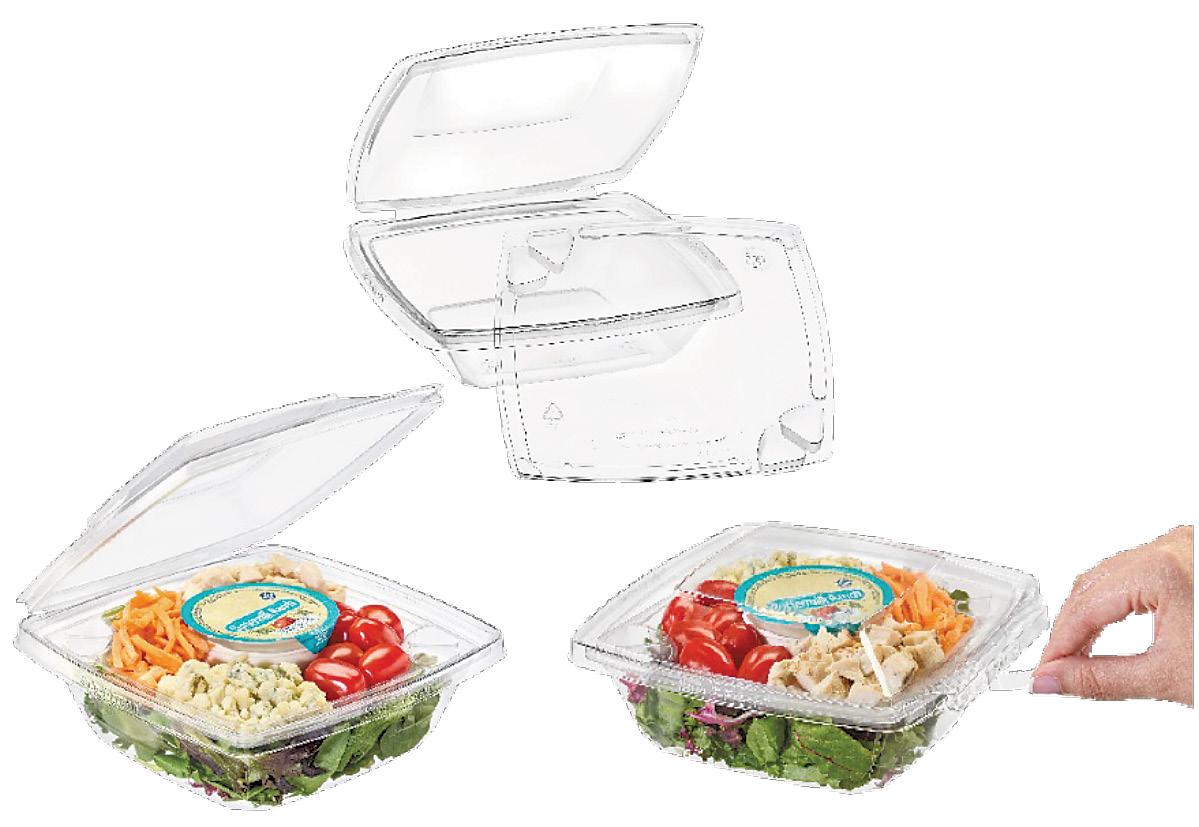
One of the standout features of these trays is the unique easy lift system, boasting dual sets of finger pockets for seamless removal. This innovative design ensures a hasslefree experience for both consumers and retailers alike. The FMT0MPW variant caters to applications requiring flat item storage, such as dressing packets, or for maintaining contents securely during vertical merchandising. Meanwhile, the FMT1MPW of-
“We are excited to expand our Flip n’ Mix tray range, offering enhanced options for our customers,” said Marlene Bautista, Product Portfolio Manager at Inline Plastics. “These new additions exemplify our dedication to innovation and customer satisfaction.”
Experience the next level of packaging excellence with Inline Plastics’ Flip n’ Mix trays – the perfect blend of functionality and aesthetic appeal.
For more information, please visit Inline Plastics.


Foodservice operators and the equipment and supply dealers that support them depend on an innovative range of equipment to satisfy their dining patrons. Their goal with today’s labor and energy cost challenges is improving efficiency, reliability, and profits.
Simultaneously, those creating the vision for the nation’s foodservice manufacturers understand that a crucial piece of the puzzle is to prioritize employees’ satisfaction and professional growth.
Wisconsin based Hatco Corporation has found its recipe for success by responding to both the needs of its customer and employee bases. The industry leading foodservice equipment manufacturer is headquartered in Milwaukee, WI, with a state-of-the-art manufacturing facility in Sturgeon Bay, WI.
Earlier this year, the company’s reigns were passed to Lorne Deacon. With the recent conclusion of the National Restaurant Association Show in Chicago
“In my time in foodservice and prior career in banking and finance, I’ve been offered the opportunity to grow many times. I believe that opportunity exists for all our employee-owners, especially today.” — Lorne Deacon
and the bi-annual NAFEM Show set for first quarter ‘25 in Atlanta, Total Food Service thought it would be an interesting time to garner insight from a key E&S leader. Hatco’s President and CEO, described the early organization “as a family-based company founded on innovative products and a serious focus on building best-in-class equipment, like dishware sanitization and food warming products, along with being great partners to our customers.”
“Over the decades, we’ve created a fun culture that promotes not taking ourselves too seriously while ensuring all our employee-owners feel empowered

Lorne Deacon
to make the best decision for our business and customers,” Deacon continued. “We like to say that Hatco is comprised of ‘People who Serve, Products that Solve.’”
At the core of this tagline is Hatco’s ESOP, spearheaded by Hatco’s former President and CEO David Rolston. Hatco employees take pride – and literal stock – in the provision of top-tier equipment and service to foodservice operators. The ESOP contract began in 2007, when Hatco employees assumed 100% beneficial ownership of the company.
Understanding the company’s employee-owned structure offers more nuanced insight into its enduring success, beginning with its establishment in 1950. Through its Employee Stock Ownership Plan (ESOP), the leadership team at Hatco Corporation responds to both demands. The result is an equally customer- and employee-driven enterprise: one that champions innovation in foodservice equipment and customer service, as well as its perspective on employee growth and involvement in Hatco’s long-term initiatives
Rolston’s ESOP evangelism continues to shape Deacon’s vision for Hatco. “My role is to drive Hatco’s vision from a growth perspective, fostering and communicating on the bedrock already created around the ESOP,” he shared. “To that end, our three most recent acquisi-
tions are employee-owners.”
Those acquisitions include ADM, acquired in 2021, and Food Warming Equipment Company, Inc. (FWE) and American Range, both acquired in 2022. Hatco acquired Ovention, Inc., in 2013. In addition to these divisions, Hatco partners with Minnow, which streamlines food delivery and pickup via contact-free Pickup Pods.
Collectively, these collaborations secure Hatco’s reputation as a leader in foodservice manufacturing, remarkably committed to its employee-owners, domestic manufacturing, and “KnockYour-Socks-Off” (KYSO) customer service. These commitments are fueled by a growth mindset, which Deacon applies to Hatco’s acquisition integration and all other key initiatives.
“What ignites the human spirit is when the leaders of our organizations offer us a reason to grow,” Deacon quipped, paraphrasing a Simon Sinek quote. “In my time in foodservice and prior career in banking and finance, I’ve been offered the opportunity to grow many times. I believe that opportunity exists for all our employee-owners, especially today.”
Deacon started in the foodservice industry as a regional manager with Star Holdings, a Middleby Company, and grew from there. Today, he acknowledges his good fortune of “working at companies who invest in developing their people.”
“The constant in all my roles leading up to Hatco was an unwavering focus on people: the customers and the employees,” Deacon reflected.
To honor this people-centered focus and support the growth of an ESOP like
continued on page 122

In recent years, the restaurant industry has witnessed significant growth in takeout and delivery revenues. This the rise of technology that enables seamless ordering and delivery processes. Restaurants have come to understand the value of offering takeout and delivery options, as it not only expands their customer base but also significantly contributes to their bottom line.
Moreover, takeout and delivery services have proven to be a lucrative revenue stream for restaurants. With the increasing popularity of food delivery apps and online ordering platforms, restaurants have been able to reach a wider audience and generate additional income. The battle over fees with the major delivery apps is certainly nothing new. However, as restaurants continue to expand their takeout and delivery services, it is important for them to keep an eye on legislation and litigation that may impact
Under this proposal, the fees that companies like DoorDash, Uber, and Grubhub can levy on restaurants would rise significantly, from 23% to a substantial 43% of each order.
the delivery industry.
One of the key issues that restaurants need to be aware of is the regulation of food delivery services. New York City’s restauranteurs are facing another battle with the NYC City Council’s introduction of Proposal Int 762. If passed it would permit major delivery companies to claim nearly half of the revenue from restaurant delivery orders, potentially harming small businesses in the process.
During a recent hearing, the NYC Hospitality Alliance urged the City Council to reject a proposed measure that aimed to eliminate the current cap on fees imposed by third-party delivery companies

such as DoorDash, Grubhub, and Uber. These fee restrictions and other marketplace regulations were established in response to reports of detrimental business practices by delivery giants towards restaurants and workers.
We see Proposal Int 762 as an attempt to dismantle the fee cap and thereby increasing costs for struggling small businesses. Our NYC Hospitality Alliance position is that Third-party delivery companies have a well-documented history of taking advantage of restaurants. It is therefore not surprising that they are pushing for the City Council to pass the Bigger Fees for Big Delivery Bill.
Under this proposal, the fees that companies like DoorDash, Uber, and Grubhub can levy on restaurants would rise significantly, from 23% to a substantial 43% of each order. This increase poses a significant burden on small businesses with slim profit margins. Industry experts argue that these delivery giants wield significant power over local restaurants akin to public utilities, necessitating stricter regulations due to their impact on small businesses.
While these delivery companies claim to offer additional ‘marketing services,’ in reality, this proposal could result in restaurants being buried in search results if they do not comply with these demands. This could make it challenging for New Yorkers to discover local eateries that are unable or unwilling to engage in

Rigie is the Execu-
Director of the New York City Hospitality Alliance, a trade association formed in 2012 to foster the growth and vitality of the industry that has made New York City the Hospitality Capital of the World. Learn more at https:// www.thenycalliance.org/
pay-to-play practices.
Again, this issue has been with us from the debut of their party delivery platforms. The difference today is that the stakes are much higher with growing delivery revenues. Discussions surrounding the fee cap on third-party delivery companies were initiated prior to the COVID-19 pandemic, following hearings by the City Council into their questionable business practices. Calls for an investigation into Grubhub were also made by now U.S. Senate Majority Leader Chuck Schumer.
Despite opposition, these companies are resorting to legal actions and lobbying efforts to deregulate big delivery in New York City, as highlighted in the recent op-ed titled: “Corporate Giants Deploy Subpoenas to Squash Advocacy, Press.” The Alliance is here to help you with information on contacts to let your voice be heard in the fight against Proposal Int 762.

For many, a career in food service can be incredibly rewarding; it allows professionals to express their creativity and bolster community through food and beyond. Because of this, it is important for individuals in food service to give back and aim to better the industry. Supporting the next generation of food service professionals is one way to do it, and the Society for Hospitality and Food Service Management (SHFM) non-profit is a guiding leader in this movement. The society itself was founded in 1979 as the merger of two organizations, the National Industrial Cafeteria Managers Association (NICMA) and the Association for Food Service Management (AFSM). Both programs emerged between the 1950s and 70s, each aiming to address different areas of food service for those in the workforce. Now, SHFM’s philanthropic foundation aims to empower the next generation of diverse hospitality professionals through awareness, education, and relationship building.
In terms of the foundation’s mission, “we’re raising money to create space for people of all walks of life and to support their ascension into our industry,” said Davin Wickstrom, the SHFM Foundation’s Chair. Wickstrom has been working in food service for years and is also the Director of Industry Relations at Vivreau Advanced Water Systems. His role in food service is what led him, and the majority of the foundation’s board, to SHFM in the first place.
Despite the board’s mutual connection to food service, “if you looked at our group as a whole on paper,” Wickstrom said, “you may not pair us all
“We’re raising money to create space for people of all walks of life and to support their ascension into our industry.”
— Davin Wickstrom
together.” The feature that does connect them all — which he describes as unrelenting — is the desire to be a service leader, to give back, and to support and educate others. This is the key to SHFM’s mission, Wickstrom continued, and the board is determined to do what they can to move that mission forward.
New to the foundation this season is Joe Esteves, the Director of Retail for Sodexo Food and Facilities Management. Esteves joined Sodexo in 2003 as a pastry chef and has been a part of the company since then, holding a variety of roles over the years, including Area General Manager. Additionally, he is a member of Sodexo’s Employee Business Resource Groups, People Respecting Individuality and Diversity and Equality (PRIDE).
“Joe embodies the spirit of what the foundation is,” Wickstrom said. “He asks how he can serve others and help create something. He’s an awesome addition for sure.”
The board is also made up of the following individuals, each of whom serve as directors of the SHFM Foundation: Amy Franks, JLL; Julia Fry (student advisor to the foundation board), Michigan State University; Stephanie Gilbert, Food Service Holdings; Nahum Goldberg, NGAssociates Foodservice Consultants, Inc.; Rob Gordon, RSG Hospitality LLC; Crystal Hamilton, Knowbie; Curtis Lease;
American Dining Creations; Matt Rigney, Structural Concepts and Jessica Zucker, Eurest/Compass Group.
“Everyone has a voice in the foundation,” Wickstrom said, highlighting the diverse group of individuals who make up the board. However, this sentiment reaches far beyond the board members whose backgrounds are in food service: much of the foundation’s impact is made through its fellowship program.
The year-long fellowship program pairs students with leaders in the food service industry, inviting them to SHFM’s regional and national conferences, and sparking connections with various seasoned professionals in the industry. These professionals have included Paul Fairhead, CEO of ISS Guckenheimer, and Joe Ganci, President of Sodexo, among other industry leaders.
These valuable relationships between industry professionals and the next generation of industry leaders are what drive the foundation to continue to work towards its mission. Each year, there’s a student advisor who serves on the foundation’s board and who offers a unique insight and voice. Currently, Michigan State University (MSU) student Julia Fry serves as student advisor. MSU alumna Lauren Hassinger served as the previous student advisor.
“Lauren was on our foundation
board, and we were able to get her an internship with the Compass Group, which turned into a permanent job in NYC,” Wickstrom said. This success story was possible through the active, educated network that the foundation promotes — and it’s just one of the many ways the SHFM Foundation is empowering the next generation. The foundation also works with the U.S. Armed Forces to provide educational opportunities for its members serving in hospitality assignments. The foundation and SHFM have supported the Hennessey Traveler Program program for over 45 years. Much like the mentorship program, it aims to provide encouragement and support to those who are interested in the food service and hospitality industry following their departure from the military.
Looking towards the second half of 2024, Wickstrom is feeling confident about what the SHFM Foundation has planned to continue its important mission. The foundation is starting phase two of its fellowship program, which is set to finish by early fall, just before their national conference. Additionally, their annual foundation gala is set to happen on Veteran’s Day in NYC. “Really, we’re seeing what’s next for our young people, and also the leaders who are mentoring them,” he said, feeling hopeful about the positive relationships that are yet to come out of the foundation’s programs, and that are sure to shape the industry for the better.
For more information about the SHFM Foundation, visit their website, https://shfm-online.org/.

In the culinary world, the ability to succeed in a variety of marketplaces is a true testament to a chef’s skill and adaptability. Nowhere is this more evident than in the dynamic and diverse culinary scenes of Miami and South Florida, where chefs must navigate a melting pot of cultures, tastes, and preferences.
Taking that skill set across the country to Northern California presents its own set of challenges requires a chef to possess unique creativity, flexibility, and a deep understanding of their audience. While NorCal is known for its vibrant food scene and focus on local, sustainable ingredients, chefs from Miami and South Florida could find themselves out of their comfort zone. The emphasis on seasonal, farm-fresh produce and a more laid-back, casual dining experience may require chefs to adjust their approach and mindset.
Ultimately, the challenges of succeeding in a variety of marketplaces as diverse as Miami and South Florida, and then bringing that skill set to Northern California, require chefs to be adaptable, innovative, and resilient. Chef Mike Fischetti of the Pocket in Carmel, has been able to find success on both coasts.
By staying true to his culinary vision, embracing new challenges, and constantly pushing the boundaries of their creativity, Fischetti has thrived Sonoma’s culinary landscape. Success in the culinary world is not easy, but for those chefs willing to rise to the occasion, the rewards are immeasurable.
Nestled in the charming town of

Carmel-by-the-Sea, The Pocket is a hidden gem where friends and family come together to create unforgettable memories. Chef Fischetti and his team have curated a warm and inviting atmosphere that sets the stage for an exceptional dining experience.
As with so many of the nation’s top toques, it was family that created the

passion for the industry.
“I would say my grandmother inspired me to be a chef,” Fischetti explained. “My parents worked a lot when I was younger, and my grandmother would watch my siblings and me. I was always in the kitchen helping her gather ingredients, prep all the stuff she didn’t want to, and carry anything she didn’t want to carry. She was the first executive chef I worked with who delegated a lot of grunt work to me — LOL. I always loved being in the kitchen with her; she was very serious about feeding our family and instilled in me at an early age that the joy of
feeding people was overwhelmingly gratifying.”
Chef Mike’s journey in the culinary world began at the Art Institute of Fort Lauderdale in 2006, where he honed his skills and developed a deep appreciation for quality ingredients. From there, he embarked on a remarkable career that has taken him from the vibrant culinary scene of Miami to the picturesque landscapes of the Bay Area.
During his time at Ortanique in Coral Gables, FL Chef Mike worked his way up from Line Cook to Sous Chef, and eventually Chef de Cuisine at Ortanique in Grand Cayman. Under his leadership, the restaurant was
continued on page 116


Do you have the SCOOP on any foodservice and hospitality news? Send items to SCOOP Editor Joyce Appelman at tfs@totalfood.com
SCOOP heard that Cornerstone Foodservice Group (CFG), a leader in premium, innovative foodservice equipment, buffetware, and induction solutions, recently announced it has acquired Equipex, a highquality cooking, holding, induction, ventless hood and display equipment manufacturer since 1996.
This strategic alliance adds Equipex to CFG’s collection of leading brands, Spring USA, Versa- Gard, LloydPans, and Astra, to offer additional strategic capabilities, product lines, and service abilities to their commercial customer base. Together, the organizations provide a comprehensive solution for restaurants, hotels, and other foodservice companies looking for high-quality back-of-house, cooking, and display equipment. The acquisition also includes SA Vents, Equipex’s patented Small Appliance Ventless Hood System.
“Combining the power and momentum of what our individual organizations have achieved over the last 25+ years will strengthen our value proposition and kitchen equipment offering for the foodservice market both today and in the future,” said Kristine Holtz, CEO of Cornerstone Foodservice Group, “this investment is a testament to our dedication to providing a comprehensive solution for chefs, operators, and foodservice professionals worldwide.”
The Equipex portfolio offers products that meet the needs of the foodservice industry and include Rollergrill International panini grills, convection and pizza ovens, warming displays, waffle bakers, salamanders, and other niche-focused cooking equipment. Equipex also offers Adventys cooking and warming induction equipment, along with its patented countertop small appliances ventless hood system.
Gary Licht, founder of Equipex, will continue with the company in a leadership role. “We are excited to join the CFG family of companies,” said Licht. “They have built an impressive business committed to providing quality service and products to the foodservice market. Our acquisition by Cornerstone Foodservice Group allows us to incorporate our vast portfolio of prod -
ucts into their already expansive offering.”
Equipex will continue to operate out of their facility in Providence, Rhode Island.
SCOOP learned that while the first ingredient in most BBQ sauces is high fructose corn syrup (HFCS), the first ingredient in Red Gold’s new BBQ Sauce is tomato puree. The list of superior ingredients in the new BBQ Sauce makes all others pale in comparison for finger-licking goodness.
“We know operators have plenty of choices when they look for a BBQ sauce for their menu, so we knew we needed a formula that stood out from the rest in flavor and quality,” says David Halt, Red Gold’s Senior Director of Business Development. “The first thing you will notice when you taste it is that it is delicious. When you look at the ingredient statement, you will know that you need to make the switch to Red Gold®.”

The new BBQ sauce uses real sugar instead of HFCS and has no artificial caramel color. With 80% less sodium than the leading foodservice brand, its list of superior ingredients includes Worcestershire sauce, molasses, garlic, chili powder, and tamarind. Its sweet and tangy flavor makes the new BBQ sauce flavor the ideal condiment for multiple menu applications.
Now available in one-gallon plastic jugs, it is perfect for back-of-house use, along with our 1.5-gallon dispenser pouches. The BBQ Sauce is also available in 1 oz. Dunk Cups for takeout, drive through and catering applications. Operators are encouraged to taste Red Gold’s new BBQ Sauce for themselves absolutely free by requesting a sample at RedGoldFoodservice.com/sample-requests.
SCOOP learned that Columbus Vegetable Oils recently announced the appointment of Frank M. Nimesheim to the role of Environmental, Health and Safety Manager.

Nimesheim will oversee the development, implementation and monitoring of day-to-day production programs aimed at ensuring a healthy and secure environment for all employees while upholding compliance protocols. His responsibilities include conducting audits, providing comprehensive training, enforcing procedures and spearheading initiatives to enhance safety and sustainability practices throughout the organization.
“Frank plays a pivotal role in ensuring that we continue to operate in a manner that focuses on the health and safety of our employees and the community in which we live,” said Paulette Gagliardo, presi -
continued on page 98


dent, Columbus Vegetable Oils. “With a wealth of experience, Frank is poised to lead Columbus to new heights. He will reinforce our position as a leader in workplace safety and environmental responsibility. Welcome to the family, Frank.”
With more than 25 years of industry experience, Nimesheim has worked in operations for a majority of his career. Most recently, he was the Environmental, Health and Safety Manager at Blommer Chocolate in Chicago. Previously, he worked at Mauser Packaging where he led a multi-million-dollar project to assure 100 percent OSHA compliance at its facility.
“Columbus has an incredible reputation in the industry, and I am looking forward to working with the team on new projects to further the company’s goals,” said Nimesheim. “I was initially drawn to the role because of Columbus’ strong reputation and commitment to quality, but as I learned more about the opportunity to innovate by working alongside such a talented team, I knew this was the right place for me.”
Nimesheim is an active member of the American Society of Safety Professionals (ASSP) and Board of Certified Safety Professionals (BCSP). In his spare time, Nimesheim is a Master Scuba Diver Trainer and Technical Diver. He volunteers as a maintenance diver at the Shedd Aquarium. He is also a Mentor Angel for Immerman Angels that serves cancer patient caretakers. A native of Detroit, he currently resides in Chicago and pursues a passion for street photography.
Columbus Vegetable Oils is a leading provider of oils, fats, specialty butters, dressings, dips and sauces. Founded in 1936, the company serves ingredient manufacturers, food service distributors, retail outlets and private label markets. Brands include Butcher Boy, Mike’s Brand, Sunrise Shortening, Nature’s Secret, Sorrento’s Olive Oil and Soaper’s Choice. The headquarters is in Des Plaines, Ill., and a distribution center in Reno, Nev., both facilities hold the prominent SQF certification in food safety and quality. Today, the fourthgeneration family leads the business as a certified woman-owned company that prides itself on high quality products, superior service and fast delivery. Learn more at www.cvoils.com
SCOOP knows that outdoor cooking has long been a popular and beloved method of food preparation, bringing a unique and fla -
vorful experience to diners around the world. For restaurant and food service operators, incorporating outdoor cooking into their dining experiences can create a truly memorable and distinctive atmosphere for their guests.
New Jersey-based equipment supply rep Pecinka Ferri has recognized the importance of outdoor cooking in enhancing the overall dining experience and has taken steps to showcase the potential of “al fresco” dining.
Pecinka Ferri recently hosted a special event: Pecinka Ferri Hosts Hot Dog Days Of Summer Barbecue at their headquarters in Little Ferry, New Jersey, where they highlighted a number of outdoor cooking strategies while industry guests enjoyed the delectable summer fare of Pecinka Ferri Chef/Partner Nick Mercoigliano.
The event gave Pecinka that opportunity to display the Josper grill. The Spanish made grill has become a favorite of chefs and operators worldwide with its ability to quickly create amazing menu items with a minimal footprint. “We’ve found that country clubs love the flexibility that the Josper gives them,” noted Pecinka Ferri’s Joe Ferri.
Outdoor cooking has long been a beloved method of food preparation, bringing a unique and flavorful experience to diners around the world. For restaurant and food service operators, incorporating outdoor cooking into their dining experiences can create a truly memorable and distinctive atmosphere for their guests. “Outdoor cooking has long been a beloved method of food preparation, bringing a unique and flavorful experience to diners around the world, Ferri concluded. For restaurant and food service operators, incorporating outdoor cooking into their dining experiences can create a truly memorable and distinctive atmosphere for their guests.”
This event was designed to bring together opera -
tors, dealers, and consultants who support them, allowing them to experience firsthand the unique and innovative outdoor cooking solutions at Pecinka Ferri’s Headquarters. The New Jersey rep in fact has recently rebranded its home as “The Culinary Center” to reflect the full slate of educational and networking events. Earlier this year, they hosted a Pizza Forum and Beverage Profit event for the trade.
SCOOP learned that RATIONAL USA, the leading manufacturer of intelligent cooking equipment for commercial foodservice, recently announced that Joseph Gomez has been promoted to Sales Director for the Central region.

Joe Gomez
Gomez joined RATIONAL in February 2017 and has been highly successful in his role as an RSM. Joseph was USA Salesperson of the Year in 2021 and in the global Club of Champions three times: 2021 (2nd), 2022 (1st), and 2023 (3rd). He helped develop his rep group into winning Partner of the Year for 2023. He will report to Ryan Elsen, Vice President of Street Sales.

Gomez will fill the leadership role of the late Jayme Schneider, who passed away earlier this year. In recognition of his impact on RATIONAL, along with our entire industry, RATIONAL will introduce the Jayme Schneider Legacy Award. This honor will be bestowed upon a RATIONAL employee who exemplifies a significant and lasting influence. The inaugural presentation of this award will take place at the RATIONAL USA 2025 kickoff event, setting a new precedent for excellence within our organization. continued on page 100

“It was an honor to have Jayme on our sales leadership team. His 17-year career at RATIONAL has been marked by unwavering dedication and exceptional leadership,” says Ryan Elsen. “I am confident that Joe will lead our Central Region to success and that his skillset will continue to propel us into a bright future.”
It has been an exciting year for Rational USA with its recent introduction of The unit that debuted at NRA ‘24 combines the best of combi-steamers and speed ovens: the quality and quantity of one, the quickness of the other. The iHexagon features iClimateBoost, the heart of the new system, which intelligently adjusts steam, hot air, microwave, fan wheel, and time parameters to each food.
The RATIONAL Group is the world market and technology leader in the field of hot food preparation for professional kitchens. Founded in 1973, the company employs more than 2,500 people worldwide.
SCOOP learned that Motion Technology, Inc. (MTI), a leading provider of innovative kitchen equipment solutions, has recently announce its newest rebate partnership with Tequesitos!, the beloved purveyor of delicious cheese and chocolatefilled treats. This exciting collaboration aims to enhance the customer experience by offering exclusive incentives to purchasers of MTI’s flagship products, the AutoFry and MultiChef.
Under this new partnership, customers who invest in an AutoFry or MultiChef will receive a complimentary case of Tequesitos! –featuring a savory cheese filling. This special offer is designed to delight taste buds and complement the efficiency and versatility of MTI’s cutting- edge cooking equipment.
In addition to the complimentary case, customers will also receive 30 Tequesitos serving cones! This added benefit ensures that customers can easily serve up the deliciousness of Tequesitos! while also providing an on-the-go option to their diners.
“”We are thrilled to announce our partnership with Tequesitos!,”” said Danielle, Marketing Manager at Motion Technology, Inc. “”At MTI, we are committed to not only providing top-of- the-line kitchen solutions but also supporting our customers long after they’ve made their purchase. Tequesitos! shares our dedication to quality and customer satisfaction, making them the perfect partner for this endeavor.””
This partnership exemplifies MTI’s ongoing com -

mitment to offering unparalleled value and support to its customers. By teaming up with Tequesitos!, MTI aims to elevate the culinary experience and drive success for businesses across the foodservice industry.
Motion Technology, Inc., a Hudson, MA based company, manufactures and sells ventless equipment solutions to the foodservice industry. Since 1990, Motion Technology, Inc. has consistently provided quality equipment and dedicated technical service to customers from independent foodservice establishments to worldwide chains.
Tequesitos! is a company with a global footprint, crafting, distributing, and popularizing a delectable snack known as “tequeño.” Operating in Venezuela, Colombia, México, Puerto Rico, and the USA, we boast two cutting-edge manufacturing facilities, over 100 stores, and a presence in 2,000+ entertainment industry food concessions and 2,500 self-service points. Originally from Venezuela, the tequeño has become a sensation, captivating taste buds across Latin America and recently in the USA. As pioneers in this culinary venture, they produce, distribute, and market Tequesitos!, a small stick of white cheese wrapped in golden wheat flour dough, crisply cooked for a warm and delightful experience. This unique snack promises a gratifying texture that ensures repeat delight.
SCOOP heard that Drexel University is now offering a Masters in Culinary and Food Science! This first-of-its-kind program integrates culinary science
and food science and allows students to engage with resources, including our culinary facilities, kitchen garden, Drexel Food Lab, Philly Chef Conference, and food media expertise.
Fall Quarter Application Deadlines: U.S. Applicants- 9/1/24
Here’s the link for more information, https:// drexel.edu/cnhp/academics/graduate/MS-Culinary-Food-Science/ or email Dr. Rosemary Trout at rek23@drexel.edu.
SCOOP celebrates that Summer is officially here. To be the top choice for summer sipping, bars and restaurants need to look at the trends shaping the beverage landscape this season. BrewLogix, a technology solutions company influencing the next trajectory of growth in the beverage hospitality and craft brew industries (and a recent Fast Company Most Innovative Companies winner), has compiled what they believe should be at the top of the to-do list for operators this summer. Insights include:
• Experience Creates Consumption: Looking to increase traffic to your bar or restaurant this summer? Customers love establishments that offer exciting experiences, such as outdoor seating or live music, to pair with their favorite drinks. Plus, once you get them in the door, they’re more likely to stay and order more!
• Changing Seasons Means Changing Flavor Notes: Now that the weather is getting warmer, patrons are craving light, refreshing sips to help cool them down. It’s time to update our menus from woody, spicy flavor notes to options with citrus and fruit flavors to complement the new season.
• Embrace the Sober Curious: More and more consumers are testing out the “sober curious” lifestyle, so to stay popular, bars and restaurants should make an effort to include NA options on their menus, including NA beers and fresh mocktails (only offering iced tea and lemonade won’t cut it anymore!).


SCOOP heard that Raydiant, the leading in-location Experience OS, released its inaugural “The State of AI in Restaurants” report. The study, based on a survey of 175 restaurant technology leaders, explores the adoption, benefits, and challenges of AI in the restaurant industry, focusing on its potential to drive competitive advantages, streamline operations, and enhance customer experiences.
“Our survey findings underscore the transformative power of AI in the restaurant industry,” said Bobby Marhamat, CEO of Raydiant. “As consumers increasingly seek personalized and seamless dining experiences, AI emerges as a critical tool for restaurants to meet these expectations while optimizing their operations. Restaurants that embrace AI will not only gain a competitive edge but also align themselves with the evolving needs of modern diners.”
Key Insights from the Report:
• AI as a Competitive Advantage: 62% of restaurant leaders believe that AI offers a significant competitive advantage to restaurants that adopt it, with 67% feeling well-positioned to leverage AI for market differentiation.
• Enhancing Operations and Customer Experience: The top benefits of AI in restaurants include effective staff scheduling (38%), increased sales and revenue (37%), personalized marketing and promotions (36%), and efficient inventory management (34%).
• Diverse AI Applications: Restaurants are experimenting with various AI use cases, such as chatbots for customer service (41%), customer preference analysis for tailored experiences (39%), inventory management (38%), predictive analytics for demand forecasting (33% tie), and food waste reduction (33% tie).
• Overcoming Hurdles: Restaurants face challenges in AI adoption, including staff training and adoption (23%), finding the right AI solution (22%), cost (17%), and customer acceptance (14%). These obstacles highlight the need for strategic planning, education, and investment to successfully integrate AI into restaurant operations.
Future Outlook and Priorities:
• Growing AI Engagement: 54% of restaurant leaders expect to increase their engagement with AI projects over the next year, recognizing its potential to revolutionize various aspects of their business.
• Keys to Success: To successfully implement AI, restaurants need a better understanding of AI capabilities, access to superior AI technologies, stronger leadership buy-in, and increased budget allocation.
“The future of the restaurant industry is closely intertwined with AI,” Marhamat added. “As restaurants navigate the evolving landscape, embracing AI will be crucial to delivering exceptional dining experiences, optimizing operations, and staying ahead of the competition. The insights from our survey pro -
vide a roadmap for restaurants to strategically adopt and leverage AI to thrive in the digital age.”
To access the full report, visit: https://insights.raydiant.com/ state-of-ai-restaurants
SCOOP heard that LTI, Inc., leading manufacturer and designer of modular and custom serving systems, advanced technologies and decor, announced the retirement of Mike Purcell, vice president of sales and marketing. After over six decades in the foodservice industry, Purcell has decided to step down, leaving behind a legacy of dedication and significant contributions to the company and the industry at large.

strategic transition plan was promoted in December 2023 to vice president of sales and marketing.
Purcell joined the LTI family in 1996 and has been a cornerstone of the company’s success ever since. His journey began at the age of eight at his grandmother’s boarding house resort in the Catskills. From those early days of dishwashing and waiting tables, his passion for the industry grew, leading him to various roles that honed his skills and expertise.
Throughout his career, Purcell’s love for food and dedication to excellence saw him take on numerous roles, from busboy and waiter to sous chef, cook and restauranteur, before transitioning into sales and marketing. His extensive experience and hands-on knowledge have been instrumental in driving LTI’s growth and innovation.
Purcell’s tenure at LTI began when he and his business partner, Brian Madden, were approached by Bill Steadman to represent Low Temp (now LTI) in Metro, NY. His knack for creating serving lines for schools and securing bids set a new standard in the industry. Over the years, his roles evolved, and he played a crucial part in product development, rep training and sales strategy, culminating in his current leadership position.
Succeeding Purcell as vice president of sales and marketing is Johnnie Merchant who brings over 30 years of experience in leadership roles within the foodservice industry. Merchant joined LTI as a regional sales manager in April 2023 and as part of the
Leer Inc., a leading brand in temperature-controlled storage solutions, proudly announces the release of its latest product line: Refrigerated Reach-In Storage Solutions. Engineered for diverse commercial applications, these units are perfect for restaurants, convenience stores, and more, offering superior reliability and flexibility for both Indoor and Outdoor cold storage needs.
Introducing the new line of Refrigerated Reach-In Storage units, available in both indoor and outdoor models, including the S40 Cooler, S40 Freezer, S85 Cooler, and the S85 Freezer.
“We understand the challenges businesses face in maximizing their cold storage capacities with reliable and efficient solutions. Our new, fully-weatherproof, Outdoor Refrigerated Reach-In Storage units address these needs by allowing businesses to leverage their unused outdoor real estate.” – Ben Albregts, President of Leer, Inc.
• Weatherproof Construction: Create extra cold
continued on page 104


storage away from your paying customers. The patented offset seams are precision machine formed, resulting in water-tight lock-form seams. This creates a robust weatherproof product, that you can place outside for years to come.
• Precise Temperature Control: Be confident your product will remain in optimal condition. Ecofriendly R290 refrigerant, electronic controls, and a automatic defrost system delivers precise temperature control (34 to 46°F for Coolers; -4°F to 0°F for Freezers).
• User Convenience: Adjustable heavy-duty shelving each capable of 100lbs, large door openings, and LED lighting provide easy access and superior organization.
Leer’s Refrigerated Reach-In Storage offers a reliable and efficient solution for extra cold storage needs. To learn more, visit: https://leerinc.com/ products/refrigerated-reach-in-storage/
Through decades of commitment to product development, customer service and a relentless focus on American-made manufacturing excellence, Leer has continued to shape and drive innovation in the temperature-controlled storage industry. We’re dedicated to the success of all our customers – be those customers of our iconic white Ice Merchandisers, Refrigerated Reach-In Storage Units, Refrigerated Trailers, or our custom-built Walk-In Coolers & Freezers.
SCOOP learned that Rosso Pomodoro, Italy’s largest Neapolitan pizza franchise, announced the
launch of franchise opportunities in the United States. Founded in Naples, Italy, the birthplace of pizza, in 1998, the Milan-based pizza chain has expanded globally to 70 locations in Italy and 140 locations worldwide including the operation of highly demanding restaurants in 12 Eataly locations across the U.S. and Canada. Rosso Pomodoro’s highly anticipated expansion into the U.S. market represents an exciting opportunity for entrepreneurs to bring an authentic Italian experience to their communities. Rosso Pomodoro U.S. franchise locations will offer a fast-casual concept for authentic Neapolitan pizza and other specialties, freshly prepared in minutes with the highest quality authentic Italian ingredients and warm service rooted in the renowned hospitality of Naples. The successful model bridges the scalability of fastcasual concepts and centralized production while delivering high caliber, high quality food. Backed by over three decades of success and expertise across Europe, each opening will be guided by industry leading experts and professional pizzaiolos who have been perfecting the craft of Neapolitan pizza for generations. Franchise locations will showcase the full experience and theater of Neapolitan pizza making, with a patented pizza oven imported from Italy as the heart of every restaurant.
The first two Rosso Pomodoro locations opened in Denver, CO, just named the number one pizza city in America. As with all upcoming franchise locations, the local staff has undergone a robust training program led by professional fifth-generation Italian pizzaiolos. Only clean, fresh, authentic ingredients will be used to create the Neapolitan pizzas, all crafted according to the exacting requirements set forth by the Associazione Verace Pizza Napoletana certification. Rosso Pomodoro pizzas are handcrafted from dough that is proofed slowly for over 24 hours, topped with premium authentic Italian ingredients and baked in a 900-degree oven for just 90 seconds.
Rosso Pomodoro franchise opportunities offers decades of expertise, a proven operating model with streamlined preparation and simple processes, an established supply chain of authentic, high-quality ingredients, comprehensive training support, and vibrant restaurant design that invites everyone to share in a true Italian experience.
For more information about franchise opportunities contact: Saverio D’Amelio at saverio.damelio@rossopomodoro.com. Visit rossopizza.com to see the experience or follow along on Instagram at instagram.com/ rossopizzausa.
Charlie Mitchell of Clover Hill, a 20-seat fine-dining tasting room in Brooklyn Heights with a Michelin star, was named best chef in New York at the James Beard Awards.
Team USA won the gold at the 2024 Bocuse d’Or Americas held for the first time in the United State in New Orleans. Team USA Head Chef Stefani De Palma and Commis Bradley Waddle secured their spot on the international stage following a 5-hour and 30-minute battle. They faced eight countries from North, Central, and South America. Onward to Lyon January 2025 for the global finals.

The team at Disfrutar collecting their award
The world of gastronomy came together in the neon-lit city of Las Vegas in the United States to celebrate and recognize The World’s 50 Best Restaurants 2024, sponsored by S.Pellegrino & Acqua Panna, with Barcelona’s Disfrutar named The World’s Best Restaurant and The Best Restaurant in Europe. The awards ceremony, hosted at Wynn Las Vegas, hon -
continued on page 106

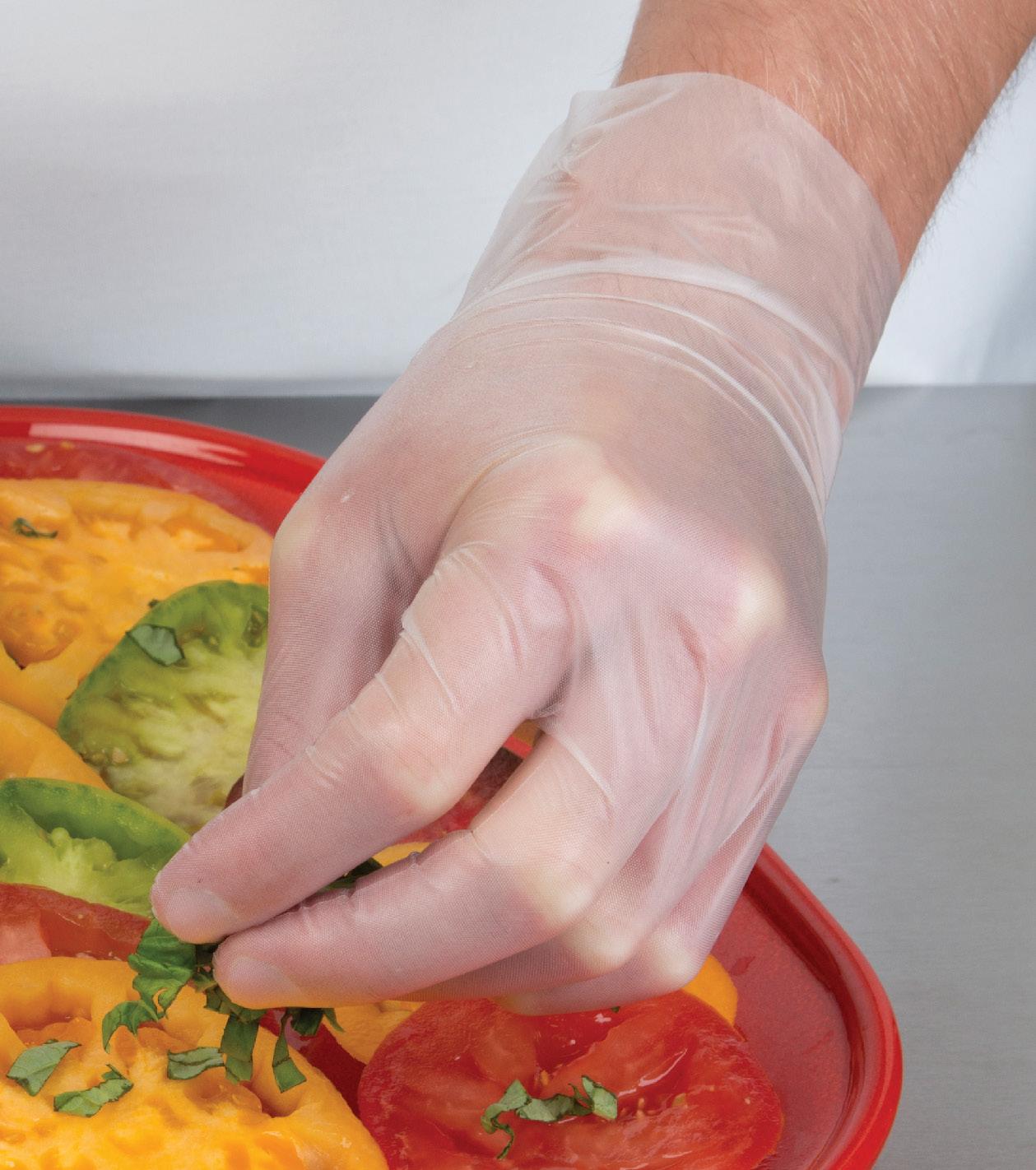

ored the very best gastronomic talent from 26 territories across five continents.
• Neil Perry, original founder of Rockpool Group in Australia and current chef-owner of Margaret in Sydney, received the Woodford Reserve Icon Award
• Paris-based Nina Métayer won The World’s Best Pastry Chef Award 2024, sponsored by Sosa
• The Beronia World’s Best Sommelier Award 2024 was presented to Pablo Rivero of Don Julio, Buenos Aires
• Wing in Hong Kong earned the Highest New Entry Award
• The Highest Climber Award, sponsored by Highstreet World, went to The Chairman, Hong Kong
• Nobelhart & Schmutzig in Berlin was the winner of the Sustainable Restaurant Award
• Mitsuharu ‘Micha’ Tsumura from Maido in Lima received the Estrella Damm Chefs’ Choice Award 2024
SCOOP heard that DoorDash unveiled the latest Accelerator for Local Restaurants participants based in Minneapolis and St. Paul, MN, and Washington D.C. The accelerator includes a series of programming to help these businesses develop revenue diversification strategies, one-on-one guidance and mentorship, and a grant of $5,000. The brick-andmortar restaurants, food trucks, food stalls, and community kitchens selected include:
• Minneapolis and St. Paul—Carbon Kitchen & Market, Chowe Empanadas, The Dripping Root, Erta Ale Ethiopian Restaurant, Game Time Sports Bar and Arcade, Gigi’s Cafe, Little Brazil MN, Nadia’s Jamaican Kitchen and Catering, Nannys Jamaican Kitchen, Q’bo Latin Food, Sweet Heaven by Nne, Vikings and Goddesses Pie Company, and West Indies Soul Foods.
• Washington, D.C.—All Set Restaurant and Bar, America’s Best Wings - Falls Church, Cookie YAY, Dogs On The Curb, FD Book Cafe, FishScale, Fritters and Roast, Greedy Little Eats, Hedzole, Hill Prince, LaLa Lover Catering, Lillian’s Southern Box Catering, Mama’s Boiz, The Ministry D.C., Open Crumb, The Peach Cobbler Factory, Plum Good, Power Source Foods, Scratch Kitchen & Bistro, Sweet Almond, Sweet Sosumba Vegan Cafe, and Tabla.
Data from DoorDash shows that most of these operators represent various diverse communities. For example:
• Sixty-six percent of participants identify as women,
• Forty-nine percent identify as an immigrant or refugee, and
• Eighty percent of participants identify as Hispan -
ic, Latino, Latinx, Black, or African American. Additionally, these businesses will use the funding and support to expand in different ways. DoorDash said that 26 percent will work to introduce a packaged product, 23 percent will incorporate more catering and events into their operations, and 17 percent will open a new location.
--Momofuku, the David Chang is opening a 200seat restaurant called Super Peach at the Westfield Century City in spring 2025. Taking over the first floor St. Marc Pub-Cafe space, the expansive restaurant will be more casual than Majordomo with a similar energy to Momofuku’s Noodle Bar in New York’s East Village. It’s projected per-person price point will be around $50 to $60.
--Brewco the local brewpub-sports bar, which closed after a 32-year run last October, has been revived as Brewco Social with a refreshed menu by chef Neal Fraser, who still operates Redbird and the Vibiana in Downtown and a vibrant new design from Noelle Isbell.
Velvet Taco, the acclaimed national restaurant brand known for its innovative, globally-inspired tacos, delicious sidekicks, house-made red velvet cake, boozy libations and late-night hours, is set to open a new Miami location in July, in Wynwood, the city’s cultural arts district. This milestone marks Velvet Taco’s second location in South Florida following its recent debut in Fort Lauderdale last September, where it’s been garnering a cult following with its scratch-made, chef-driven menu of unique recipes. Combining Velvet Taco’s industrial yet playful design with Wynwood’s artistic spirit, the new location brims with brightness thanks to pops of color, natural wood textures and cheeky and irreverent wall murals. Further highlighting the brand’s passion for the arts, Velvet Taco tapped the Miami-based, global art group The Color Dreamers to curate the restaurant’s exterior and interior murals. The murals capture the essence of the Wynwood community, featuring the neighborhood itself on an interior wall and a bright, abstract design, complete with a grizzly bear devouring a taco, on the exterior. Adding to the allure, the Wynwood location will feature Velvet Taco’s firstever cocktail bar, offering intimate bar seating to enjoy handcrafted libations while soaking in the vibes from the main dining room which includes large airy windows and a front row seat to the dynamic energy synonymous with the bustling streets of Wynwood.
The Board of Trustees of the Culinary Institute of America (CIA) announced the appointment of Michiel Bakker as the college’s sixth president, effective September 1, 2024. Bakker will further CIA’s eight-decade legacy of leadership and excellence. The Board’s decision follows an extensive, 10-month global search. Bakker succeeds Dr. Tim Ryan, the Institute’s longest-serving president, who held the role since 2001 and who moves into the new role of chancellor.
“In its 78-year history, CIA has had just five presidents—pretty astounding when you consider that the average college president’s tenure is less than six years,” said Board Chair John Metz, Jr. “We were committed to finding the person who would ensure that CIA continues to be the world’s premier culinary college. Michiel Bakker’s experience speaks for itself, and we are confident he is the president to build on CIA’s strong foundation and usher the college into its next era.”
For the past 12 years, based in Mountain View, CA, Bakker worked in various global leadership roles at Google. From 2012 to 2021, he was responsible for Google’s celebrated Food at Work program, supporting all foodservice-related activities and initiatives, as well as developing internal and external partnerships to explore and tackle the challenges and opportunities in global food systems.
He also led Google’s Global Workplace Programs organization with overall responsibilities for the ongoing delivery of events, health and performance, transportation, and food at work services to more than 250,000 individuals worldwide. Most recently, Bakker steered the Global Workplace Strategy, Innovation, and Sustainability team, leading the work on Google’s long-term workplace strategy, workplace experience, and sustainability efforts for Google’s global office real estate portfolio.
Before joining Google in 2012, Bakker spent 17 years with Starwood Hotels & Resorts Worldwide, Inc. in various hotel and global food and beverage operations roles. These included creating and building out partnerships, leading hotel food and beverage developments and openings, food experience design, and running hotel and food and beverage operations.
Bakker holds an Executive MSc degree in Real Estate and Construction Management from the University of Denver Daniels College of Business, a Master of Hospitality Administration degree from the University of Nevada, Las Vegas, an MBA from the University of Bradford continued on page 108

in the United Kingdom, and a bachelor’s degree in Hotel Administration from the Hotel Management School Maastricht in the Netherlands.
He is an active contributor to various advisory boards of organizations including the Yale Center for Customer Insights, the EAT Forum, the World Food Program Innovation Accelerator, and the Beans is How initiative. He is also a member of the James Beard Foundation’s Board of Trustees and the Supervisory Board of the Dutch food waste focused startup Orbisk. In addition, Bakker hosts the Food Lab Talk podcast, which highlights bold visions and inspiring actions for the future of food systems, and he contributed a chapter to the book Food Inc. 2. He has been involved with CIA for many years, serving on the advisory councils for the college’s Sustainable Food Systems master’s degree and its Menus of Change®

initiative, and he piloted the college’s ProChef® Plant-Forward Kitchen training and certification program at Google.
“Stepping into the role of president at the Culinary Institute of America is a dream come true for me, as CIA is an organization I have admired and supported for so many years,” Bakker said. “In this new role, I will be able to bring together my deep passion for all aspects of the food and beverage industry, lifelong learning, hospitality, and enabling individuals to be at their best. Building upon the college’s legacy, reputation, and alumni network, I’m excited and eager to collaborate with the incredible faculty, staff, and stakeholders to propel CIA forward, ensuring students continue to graduate with the skills and knowledge to thrive in the dynamic and most amazing and rewarding world of food and beverage.”
dex, ArkA shares in Multi X’s 37-year legacy of sustainability and responsible aquaculture. ArkA holds the highest and most competitive industry certifications including a Best Aquaculture Practices (BAP) 4-star rating, Aquaculture Stewardship Council (ASC) certification, and “Recommended to Buy” status from the Monterrey Bay Aquarium Seafood Watch. ArkA’s clear commitment to transparency surpasses the industry standard and makes it an option chefs can feel proud to put on their menu.
Not only does ArkA offer an incredible taste and unmatched quality, but it also stands by its promise to remain antibiotic-free at every stage, making it a star culinary ingredient for any discerning chef. ArkA‘s world-class sustainability practices ensure your food doesn’t just taste good – it does good, and your patrons will taste the difference. Embrace the future of dining by choosing ArkA, the standard in antibiotic-free, premium Antarctic salmon.
Stay on top of ArkA’s latest offerings and sustainability initiatives by following them on LinkedIn, Facebook, Instagram.
ArkA is the world’s first vertically integrated salmon brand with a full line of antibiotic-free (ABF), Aquaculture Stewardship Council (ASC) Certified, Best Aquaculture Practices (BAP) 4 Star Certified, fresh, frozen and smoked salmon products from the Magallanes Region of Chile, Region XII. Arka ultrapremium salmon is one of the world’s most responsible, conscious, and scalable salmon brands available for retail and food service today.
Multi X was founded in 1987 in Puerto Montt, Chile. As pioneers of Chilean aquaculture, the company actively invests and supports the development of Southern Chile, as it has for three decades. Multi X is committed to making the best salmon in the world, placing sustainability and transparency at the center of the business, managing our global impact, and generating responsible and sustainable value for society and its shareholders.
I worked hard to earn scholarships towards my education, including funding from Les Dames d’Escoffier New York. I earned an additional scholarship from the Jean Gorges Foundation in 2023, which included an externship position at Nougatine. There, I worked the Garde Manger station preparing seafood dishes, salads, sushi, etc., but learned much more under the mentorship of Chefs Joe, Monty, Carla, Hana, and Jules. I do credit the vigorous training at Nougatine for her success to date always striving for excellence, attention to detail and working with integrity whether in front or back of house.
What kind of events do you host at the Manhattanville campus?
I help to manage events for the Columbia Business School clients, including school leadership, executive education events for clients and students, as well as food service for new student
“The culinary world can lead to many opportunities aside from being a chef or working in a restaurant; the career possibilities are endless. Make sure you learn or train from the best people around you.”
orientation and student events.
How many staff do you direct front of house and back of house and which positions?
Yes, it does vary depending on the size of the attendees. The range is 2-30 catering servers.
I do not manage the BOH in-house cooks at Columbia. The chefs handle that but I manage the porters and runners, generally six employees.
Which cuisines do you highlight in
your catering for events? Who are your customers?
Event menus vary based on the client and culinary team’s vision – from Mediterranean or Asian-inspired to Latin-flavored or conventional American fare.
In this next stage of my career at Columbia, I am excited to learn from my colleagues through their professional experience, and also continue to delight our clients at each event.
Having been a part of the Double Discovery program and as a resident of the Harlem community, I look forward to ways I can give back now as member of the Columbia campus community.
What advice would you offer prospective students and young professionals to encourage them to pursue jobs in culinary arts and event management?
The culinary world can lead to many opportunities aside from being a chef or working in a restaurant; the career possibilities are endless. Make sure you learn or train from the best people around you. Having a mentor will help develop your skills and knowledge of the industry. I will also say it’s extremely important to have tough skin. People will challenge or doubt your abilities but as long as you believe in yourself, you can achieve your goals.

Great Hall of Chicago’s Union Station. Silver Plates were awarded in eight category segments, with one winner chosen by secret ballot to receive the coveted Gold Plate Award for the year. This year, the honor went to Chris Tomasso, President & CEO of First Watch Restaurant Group.
The Four Seasons Hotel Chicago played host to the 2024 Dealer of the Year & All-Industry Awards Gala, presented by Foodservice Equipment & Supplies.
The annual event brought together top dealers, sales reps, consultants, operators, manufacturers’ reps, and service agents, for an evening of celebration and recognition. Among the highlights of the 2024 awards, Wasserstrom, winning the coveted Dealer of the Year honor. Rick Post of Compass Group was inducted into the Hall of Fame, honoring his long-standing impact and influence in the industry. TFS dear friend Larry Cantamessa of PBAC, was recog-
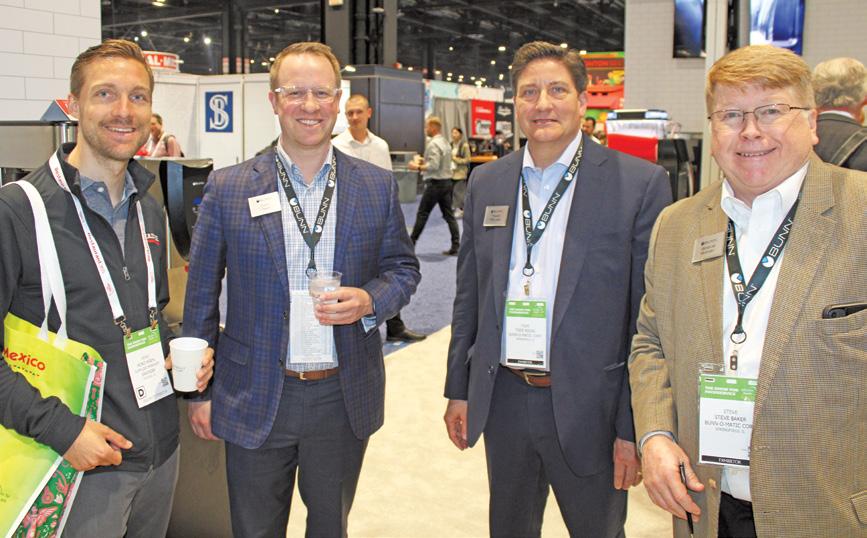
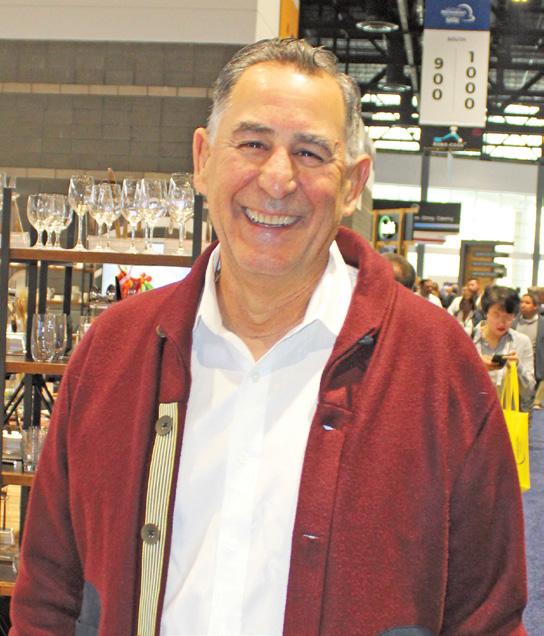



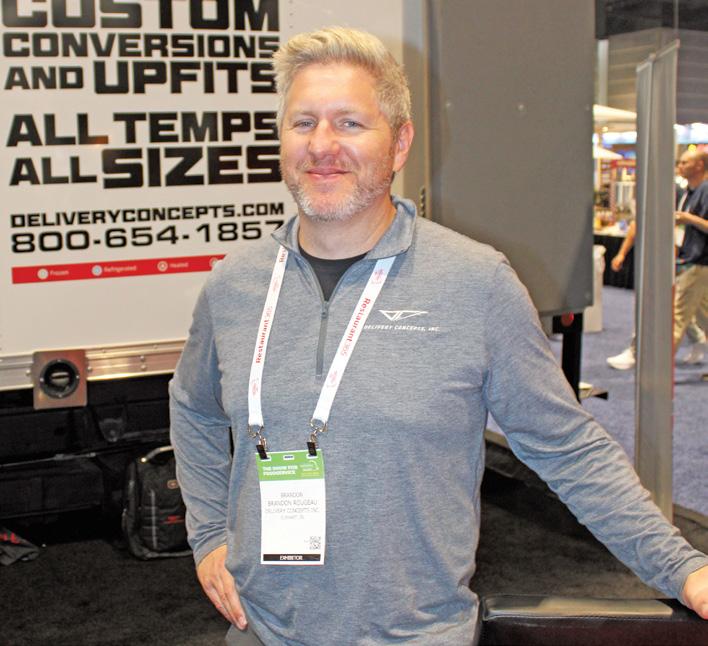
nized posthumously as the nation’s top Manufacturers’ Rep.
The National Restaurant Association Restaurant, Hotel-Motel Show® is the Western Hemisphere’s most influential foodservice event showcasing industry innovations and trends. Each year (starting in 1919), the Show brings together restaurant operators and foodservice professionals for four days of celebrityled demos, exhibits, sampling, educa-



tion and networking. The Show unites a global community and enables exploration of the latest advancements in food, beverage, equipment, technology and solutions driving the industry forward. The Show is owned and operated by Informa in partnership with the National Restaurant Association.
Visit nationalrestaurantshow.com for more information.


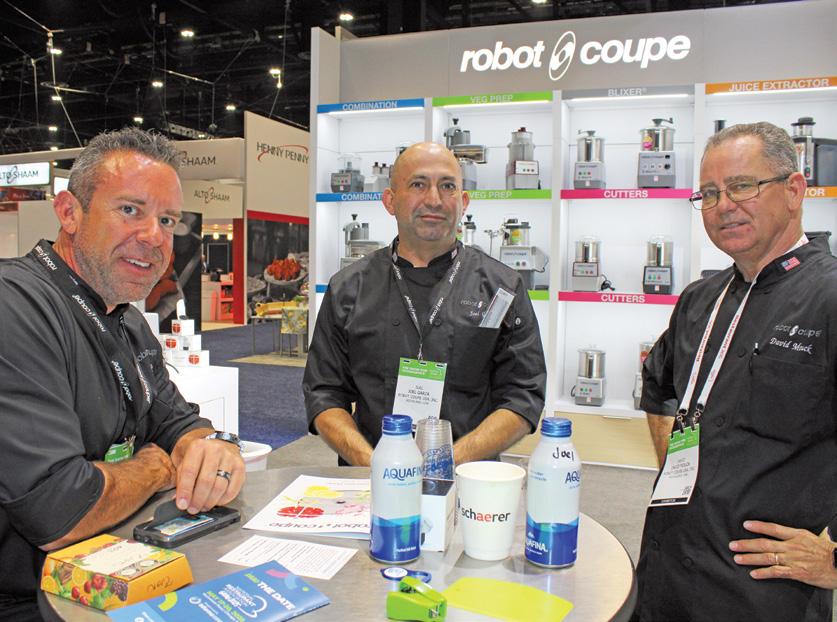

experience f&b and share it with friends and have them want to come back for weekends after.”
Isai Xolalpa, the W Philadelphia’s new Director of Bars and Lounges, leads the beverage team and mixology program, and manages revenue and strategy across the hotel’s B&F outlets - Living Room and WET Bar. Coming from the Aspen W, where he was executing the events the hotel hosted for Aspen Food & Wine and Gay Ski Week, he sees the value in participating in these kinds of events and sees every kind of marketing as good marketing.
Xolalpa says, “Every event is an event that can create connections, more revenue, put the brand on people’s minds, be seen as more prestigious and make sure people are aware of what is happening with us. If we have the opportunity to take on more business in the following weeks we should do it. It’s like networking to bring in more business.”
Peter Eastlake, the James Beard Award Winning Somm who owns three wine shops in Berkeley, and is responsible for creating Winelands, the pioneering beverage offerings for Outside Lands in San Francisco’s Golden Gate Park. Outside Lands has contributed approximately $1 billion to the local economy since its inception and Eastlake is pleased by the industrywide benefit of participating in events like these.
He knows that for restaurants that crush it at Outside Lands there’s great potential to build and strengthen relationships. He notes, “The Bay area wine world is already a community of food and wine and kitchen folks, so you do see those relationships intersect at Outside Lands especially when someone recalls we got to see Green Day together.”
He continues, “Each winery has sent about 4 wine people, all of whom are out there eating and drinking for three days and it does pollinate that way, the community aspect.”
Not to mention festival ticket holders themselves. Eastlake points out, “Our participating wineries, bars and restaurants can see an audience of over 200,000 over the three days. That’s an audience size they can’t get
anywhere else. And, it’s not just an audience that is passing by, but one seeking out the experiences within the music festival in majestic Golden Gate Park.”
Xolalpa wants his guests to park themselves at his hotel bar with as much excitement as they did at the festival and he’s precise in managing both personnel and budgets to make it profitable all around. He comments, “You are successful as much as you are prepared. I like to do investigations and do my research, find out what is the trend, and what is appealing and then you explain this to the team and ask for their input. Maybe they’ve heard someone else. You never know someone else’s life until you ask. So I can’t emphasize enough that information is key. The more you’re open the better. Ask every question you can ask – how many people are coming? Do we think we are going to get more or less? What if they ask for water?”

Tropical fave Chinola, the first shelfstable passion fruit liqueur from the Dominican Republic has expanded its line and Chinola Mango is now available.
Using ecofriendly cultivated locally grown varieties, like the Banilejo, Chinola Mango offers a beautifully balanced combination of sweetness and
tanginess and with a smooth texture which makes it perfect on its own or mixed into cocktails.
It mixes well with many spirits, including tequila, vodka, sparkling wine, and more, serving as both a perfect addition to classic cocktails and in-house creations.
Xolalpa continues with thoughts about labor and potential increased costs in that arena and the satisfaction of good ROI as he remarks, “You need to add some numbers to it. For example, we may only have five bartenders, so we need to create a strategy to revolve bartenders through the events and day to day. At times like this it may require you to add bodies. But, if you get good reviews and the drinks come out on time it reflects well, and you’ve built a good reputation.
Ultimately, when you consider participating in an off-site event it’s not about that singular revenue driving day. Tettemer concludes, “It’s about the legs and halo effect you get that reverberates that you are set to activate in the future. If you participate you want to think about what you are doing next to bring those people back.”
Chinola Mango Liqueur
Here’s some good news about a new product that your guests are going to love this summer, and all year round…

offers a lower cost High-Speed Oven that uses dual impingement and an Inverter controlled microwave with an 8-inch touch screen that operates like a cell phone screen. This combination of impingement and microwave allows for quick cooking times of sandwiches, pizza, chicken, and more. To complete their line are the induction cooktops and an induction Wok. Each Midea product is stainless steel and offers a one-of-a-kind warranty support function.
Stohrer explained that the warranty is designed so that the operator is not without a microwave for more than two days, making it a cost-effective purchase. The exchange warranty covers all 1000-Watt ovens and induction models. “If we get notified by 3:00 p.m. ET of a microwave that is down, an exchange oven will ship under warranty that day from the nearest warehouse to the customer,” Stohrer continued.
Midea’s warranty underlines the company’s care for its customers, and this is also reflected in its availability. The Em-
pire Group of companies has 10 warehouse locations across the United States, and they can ship products anywhere in the lower 48 states within 1-3 business days. Additionally, their warehouses have over $4 million dollars in inventory and prioritize keeping stock on all items.
Stohrer and Megarr’s passion for and belief in the microwave’s capabilities is evident through their product offerings. As they look towards the future, they plan to expand beyond microwaves, potentially releasing products like toasters, immersion blenders, and even refrigerators. “Our goal is not to be known as a commercial microwave oven company but rather a complete food service company.” Stohrer said. Midea’s product line has clearly established itself as a brand that creates 24/7 solutions for restaurants, foodservice professionals and the dealers that support them to achieve their success.
For more information, visit https:// empiremicrowaves.com/


Amidst these looming dangers, innovative solutions like the AutoFry ventless deep-fryer emerge as beacons of safety in commercial kitchens. Unlike traditional open fryers, AutoFry utilizes cutting-edge technology to eliminate the risk of carbon monoxide emissions, safeguarding both staff and customers alike. With its user-friendly interface and automated cooking processes, the AutoFry not only promotes a healthier work environment but also boosts operational efficiency. By adopting such innovative appliances, commercial kitchens can significantly reduce health hazards while maintaining high standards of food quality and safety.
At the heart of AutoFry’s safety features lies its ventless design, which obviates the need for external ventilation systems. By encapsulating the
frying process within a self-contained unit, AutoFry ensures that any CO emissions are safely contained and filtered, preventing them from permeating the kitchen environment. This innovative design not only reduces the installation and maintenance costs associated with traditional ventilation hoods but also allows for greater flexibility in kitchen layout and design. Furthermore, the enclosed system minimizes the release of grease particles and odors, contributing to a cleaner and more pleasant workspace. The advanced filtration technology employed by AutoFry captures and neutralizes harmful contaminants, thereby enhancing air quality and protecting the health of kitchen staff. Additionally, this contained environment reduces the risk of fire hazards, as the potential for grease fires is significantly diminished. Overall, AutoFry’s ventless design represents a significant leap forward in kitchen safety and operational efficiency.
Beyond its safety benefits, AutoFry also boasts unparalleled efficiency and performance, streamlining kitchen operations without compromising on quality. With precise temperature control and automated frying cycles, users can achieve consistent results with minimal oversight, enhancing productivity while reducing the risk of human error. Additionally, AutoFry’s energy-efficient design helps lower operational costs, making it a financially sound investment for busy kitchens. By integrating this technology, establishments can maintain high standards of food quality while optimizing their overall workflow and resource management.
For restaurant owners and managers, investing in AutoFry isn’t just about enhancing safety—it’s also about ensuring regulatory compliance and fostering peace of mind. By
opting for a ventless deep-fryer that meets stringent safety standards, establishments can demonstrate their commitment to protecting both their workforce and patrons, thereby safeguarding their reputation and bottom line.
In the fast-paced world of commercial kitchens, where time is of the essence and safety is paramount, the threat of carbon monoxide from open fryers looms large. However, with innovative solutions like the AutoFry ventless deep-fryer, restaurateurs can mitigate this risk while simultaneously enhancing efficiency and performance. By embracing cutting-edge technology and prioritizing safety, we can ensure that every culinary creation is served with a side of peace of mind.
To learn more about how ventless kitchen equipment can benefit your business, visit mtiproducts.com today!

national origin, or religion. For example, firing an employee for vocalizing their support for Palestine can be easily twisted by a plaintiff’s attorney into an argument that the employee was fired because they are Muslim or from Palestine. That is particularly the case if the employer punishes that employee’s speech but not similar speech of other employees of a different race, religion, or national origin.
It’s easy to make the mistake of firing an employee for reasons that sound good at the time but that turns into a massive headache afterwards. A great example of this is a recent lawsuit against Whole Foods. Back in 2020, when COVID and Black Lives Matter (“BLM”) were common topics of discussion, several Whole Foods employees were disciplined for wearing apparel with BLM messages on it – a violation of Whole Foods’ policy that prohibits employees from wearing apparel displaying non-company related messages. Employees argued that Whole Foods did not enforce this policy until its employees began wearing this BLM-branded apparel – that Whole Foods was discriminating against African American employees. Whole Foods ended up winning the lawsuit by showing that the policy was equally and consistently enforced, meaning that once Whole Foods began applying its policy, it did not target employees wearing BLM apparel, did not target African American employees, and disciplined all violators equally.
Employers who want to control employee speech can use this case as guidance on what to do, and what not to do. Workplace policies are a great way to protect your business from lawsuits such as these, so long as they don’t single out any group or protected class and they are consistently (and equally) enforced.
Deciding to fire an employee based on their political speech entails real legal risk. If you do decide to fire an employee because of their political speech, make sure that you consult with your counsel and avoid accidentally opening yourself up to costly legal liability.
warnings, but SB 1524 would give restaurants an extra year to place the language in their menus.
“SB 478 would in effect, eliminate negotiated service fees and therefore deprive employees of income,” noted Jot Condie, President & CEO of the California Restaurant Association. “There’s nothing in the new law to prohibit restaurants from folding fees into their quoted prices and using the income for whatever purpose it is being used now.”
However, no one from Bonta’s office
from page 6
testified on SB 1524 implying that he doesn’t oppose the restaurant exemption. Bonta is a very likely candidate for governor in 2026, and his major rival may be Lt. Gov. Eleni Kounalakis, who lists herself as a co-sponsor of the new bill along with the California Restaurant Association. By keeping abreast of developments in the California legislature, the nation’s restaurateurs can stay ahead of potential changes that may affect their pricing strategies and overall business operations. Understanding
the implications of legislation like the California Senate Bill 1524 can help restaurant operators make informed decisions and adapt to the evolving regulatory landscape.


products and services from a diverse array of vendors, expanding their professional toolkit to apply on their campuses. Also on Thursday, July 18, the thrilling Culinary Challenge will bring together collegiate chefs from across the country to compete for the national title.
Workforce strategist and award-winning keynote speaker Greg Offner will open the conference with, “The Tip Jar CultureTM: Creating an Engaging Workplace,” a musical presentation that melds his unique experience as a dueling pianist with practical framework for boosting employee engagement. In addition to informative and enlightening learning sessions, attendees will enjoy dynamic roundtable discussions, experiential learning opportunities, inspiring awards presentations and engaging networking events. Award-winning futurist Bryan Alexander, Ph.D., a senior research scholar at Georgetown University, will present the closing keynote presentation, “The Future of Higher Education,” exploring how demograph-
ics, macroeconomics, geopolitics, and emerging technologies are reshaping academia.
“The collective success of our industry in meeting its diverse challenges hinges on the ability to collaborate and build a strong community across the spectrum of collegiate dining,” stated NACUFS President and CEO Robert Nelson. “This conference serves as a pivotal platform for sharing knowledge and innovation that not only enhance services but also shape the future of campus dining. Together, we are setting new standards in the industry, driven by our shared commitment to excellence.”
The event also serves as a backdrop for leading college & university dining programs to be recognized. The Loyal E. Horton Dining Awards named after a NACUFS founder, past president and highly regarded innovator will be presented a the Louisville conference.
The Horton Dining Awards celebrate members’ innovative ideas and program implementation. Member institu-
from page 94
awarded the prestigious AAA 5-Star Diamond Award, a testament to his culinary talent and dedication to excellence. His culinary journey then led him back to Miami, where he served as Chef de Cuisine at Zest and Zest MRKT, where he embraced a diverse and seasonally driven culinary approach.
In 2018, Chef Mike and his wife made the decision to relocate to the Bay Area, drawn by the region’s reputation for fresh, high-quality ingredients and vibrant culinary scene. With his wife pursuing a career in the wine industry, Chef Mike found his home at Va de Vi, where he brought his unique culinary perspective and flavors to the restaurant’s international small plates concept. His passion for creating dishes that blend global influences with local ingredients has garnered praise from diners and critics alike.
“At The Pocket, we believe in the power of shared moments and the joy of savoring delicious food and wine
tions across North America submitted entries in 12 dining categories, covering retail sales, catering, special events, renovations, new facilities, employee development programs, outreach and education, and more.
The NACUFS Nutrition Awards will also be presented at NACUFS ‘24. These awards recognize the outstanding nutrition and wellness programs implemented within collegiate foodservice programs to meet the needs of a dynamic student population. Member institutions across North America submitted entries in three categories –Wellness and Nutrition Program of the Year, Special Diet Program of the Year, and Special Diet Recipe of the Year. In addition, NACUFS will present top honors for sustainability. The NACUFS Sustainability Awards recognize the pivotal role dining services has in the overall environmental sustainability and social responsibility of a campus. Member institutions across North America submitted entries in these categories – Sustainable Procurement; Diversity,
“Our menu is carefully crafted to offer a perfect balance of flavors, with each dish expertly paired with a selection of wines chosen to enhance your dining experience.”
— Chef Mike Fischetti
in good company, Fischetti noted. Our menu is carefully crafted to offer a perfect balance of flavors, with each dish expertly paired with a selection of wines chosen to enhance your dining experience. Whether you choose to indulge in our braised short rib or savor our fresh seafood options, every bite is a celebration of culinary excellence.”
One of the keys to Chef Mike’s transition to the West Coast was the ability to find a resource that would enable him to continue creating signature dishes. “I choose to work with Chefs’ Warehouse because they offer very high-quality products at a very rea -
Equity & Inclusion/Social Justice; Carbon Neutrality; and Waste Reduction.
The National Association of College & University Food Services (NACUFS) was founded in 1958 by a group of college and university foodservice professionals from across the United States. Since its inception, NACUFS has focused on its mission to support and promote excellence in collegiate dining by providing members with the programs and resources they need to excel, from benchmarking and best practices to educational programming and professional networking.
NACUFS institutional members range from private colleges to large public universities, including two-year and four-year institutions, spanning the United States, Canada, United Kingdom and beyond. Industry members include food and equipment manufacturers, distributors, brokers, foodservice support companies, councils, boards, trade associations, advisory commissions and other professional groups.
sonable price,” Fischetti said. “Beyond that their customer service is and always has been great, starting from my sales rep to the delivery driver, everyone is always kind and helpful.”
“We have an ever-evolving menu that we change quite frequently, but our Bone in Certified Angus Beef Short Rib has become a staple at The Pocket,” Chef Mike detailed. “We put a generous rub of Chefs’ Warehouse smoked paprika & Bel Aria Porcini Powder and then roast them overnight. When it comes time to serve it is placed on a bed of Giusto’s Vita-Grain Polenta then it is topped with Bacon
Marmalade and demi-glace. It’s one of those labor of love dishes that we take our time to make properly and has become a fan favorite.”
In addition to exceptional dining experience, The Pocket Residences offer guests a unique opportunity to extend their stay and enjoy the luxury of a private residence with the amenities of a 5-star hotel. With the adjunct hotel operation, Chef Mike and his team offer private dining options for those who prefer a more intimate setting.
Chef Mike Fischetti is a talented chef who has brought a unique culinary perspective and flavors to the Bay Area dining scene. His dedication to quality ingredients, passion for global cuisine, and creativity in the kitchen have earned him a well-deserved reputation as a culinary artist. Through his partnership with The Chefs’ Warehouse, Chef Mike continues to push the boundaries of his culinary creations and delight diners with innovative and delicious dishes.

from page 16
capturing her readers’ attention and getting them excited about the plantbased lifestyle.
Sharon, why are you interested in including more prunes in cuisine?
I find that including more diverse ingredients in recipes can enhance their unique taste and nutrient qualities. For example, prunes (dried plums) can be included in savory dishes because they have a unique caramelized flavor and rich texture that can increase the quality of a variety of savory dishes, including pilafs, stews, casseroles, curries, and salads. In addition, prunes are rich in fiber, potassium, and vitamin K, as well as phenolics linked with health benefits, such as bone health.
What are the benefits for foodservice chefs to add prunes to their menus?
You can add unique quality, taste, texture, and nutrition components with an easy ingredient. Prunes are shelf-stable, economical, always in season, and easy to add to recipes. Just slice them to include in many dishes.
AHF-NY
from page 80
addition of plant-based delicacies to healthcare dining operations.
The AHF-NY continued its tradition of helping its membership deal with the potential of the most challenging of issues. Ruck-Shockey Associates Georgie Shockey and Michael Salvatore anchored a discussion on Food Disaster Planning for Healthcare.
“Our members face a number of big challenges in catering to the diverse dietary needs of our patients,” noted AHF-NY President Simone Nicolas. “We have to be mindful of allergies, dietary restrictions, and cultural preferences, all while ensuring that the meals we provide are both nutritious and appealing. Additionally, we also have to consider the impact of mental health conditions on our patients’ eating habits. It’s a delicate balance that we have to strike every day and
How can foodservice establishments incorporate more prunes into their menu planning?
Prunes fit really well in a variety of cultural cuisines, such as Mediterranean, Middle Eastern, French, and Italian. They can add an interesting profile to a variety of menu options, including a Mediterranean grain bowl with cucumbers, tomatoes, bulgur, and olives. You can include them in a chickpea tagine dish for a unique sweet-savory taste. They are delicious stirred into hearty salads, such as grain, pasta, or green salads. And even a chickpea curry served with brown rice.
I understand that one prevalent misconception about prunes is that they are only useful for relieving constipation and are primarily consumed by older adults for this purpose. How can this misconception be debunked for younger consumers?
Yes, it’s so true! Indeed, prunes are rich in fiber, and the average American is seriously running short of fiber, which has multiple benefits, including digestion, heart health, and lower
risk of obesity and type 2 diabetes. But prunes have recently been linked with their potential for improving bone health, which is a significant advantage, given many people suffer from bone loss that can be devastating. I just love to see people fit in another type of fruit into their diet, too. Only 12% of Americans meet their recommended fruit-serving intake.
Can you share your favorite prune recipe that you developed in your own kitchen?
Vegetable Couscous Salad with Za’atar
This super easy, delicious, healthy recipe for Vegetable Couscous Salad with Za’atar is vibrant with the sunny flavors of the Mediterranean and Middle East. You can make this vegan salad gluten-free by using gluten-free couscous.
INGREDIENTS
Salad:
• 2 cups water
• 1 ½ cups Israeli or pearled couscous, dried
• ¼ cup pine nuts
• 1 large tomato, sliced into thin wedges
1. Prepare couscous (according to package directions, or the following instructions). Pour water into a small pot, cover, and bring to a boil over high heat. Add the couscous, reduce heat to medium, cover and cook for 10 minutes. Place in colander and rinse with cool water. Set aside to cool slightly while preparing remaining ingredients for salad.
2. Preheat oven to broil setting. Place pinenuts in a small baking dish in top shelf of oven. Broil for 3-5 minutes, until golden brown. Be careful not to burn. Set aside.
3. In a large mixing bowl, add sliced tomato, chopped bell pepper, sliced onion, chopped mint, chickpeas, olives, and prunes. Add cooked, cooled couscous and toasted pinenuts. Gently mix ingredients to combine.
4. Make lemon za’atar vinaigrette by whisking together lemon juice, olive oil, minced garlic, za’atar, salt (optional), and black pepper in a small dish.
today’s program provided insight into a number of those challenges.”
AHF New York’s goal is to play a key role in the journey to health and wellness. As healthcare foodservice selfoperators, the group understands the important alignment between nutrition and healing. The chapter’s mission is to develop leaders and raise the bar for foodservice in New York’s self-operated facilities, whether acute or long-term care. Its members are directors, managers, dietitians, and chefs.
AHF-NY provides professional growth through focused education - the programming that drives productivity, innovation, and patient satisfaction from within all facets of the foodservice department, from patient meals to staff dining to retail concepts.
• 1 medium bell pepper (green, red, yellow, or orange), coarsely chopped
• ¼ medium white or red onion, thinly sliced
• ½ cup coarsely chopped fresh mint
• 1 (15-ounce) can chickpeas, rinsed and drained
• ¼ cup kalamata olives, whole, rinsed and drained
• 1/3 cup sliced dried prunes
Lemon Za’atar Vinaigrette:
• 1 large lemon, juiced
• 2 tablespoon extra virgin olive oil
• 1 small garlic clove, minced
• 1 tablespoon za’atar (see below)
• ½ teaspoon salt (optional)
• ½ teaspoon black pepper
5. Drizzle vinaigrette over salad, and gently mix ingredients to combine. Serve immediately, or chill until serving time.
Makes 6 servings (about 1 ¼ cups each).
Follow Sharon Palmer on Instagram, Twitter, and Pinterest @sharonpalmerrd; Facebook at Sharon Palmer, The Plant-Powered Dietitian.


and technologies being introduced to make the process more efficient and user-friendly
Tock, which was launched in Chicago in 2014 and acquired by Squarespace in 2021, provides reservation and table management services to approximately 7,000 restaurants and other venues. Some notable restaurants on the Tock platform include Aquavit in New York and Chez Noir in California. The acquisition of Tock by American Express is seen as a strategic move to further enhance its offerings in the dining and event space.
“American Express has demonstrated its commitment to the hospitality industry, and we believe that as part of American Express, Tock will deliver enhanced value to our customers through access to a broad network of diners,” said Matthew Tucker, Head of Tock. “We appreciate American Express’ recognition of Tock’s exceptional products, experienced team, and our first-rate customer base. We look forward to working together to broaden American Express’ world class dining program and are excited by the tremendous opportunity to continue to innovate on behalf of our customers as part of American Express. We are also deeply appreciative of Squarespace’s support of Tock’s vision and its commitment to the business over the past three years.”
from page 22
our standard stock items.” The program began with adding drop-in sinks to their pre-existing tables, which he explained was an optimal entry-level way to go. “We grew because we understood exactly what our capabilities were and what our dealer and consultant’s end-user customers needed to succeed,” Woelfer explained.
“With that we made significant investments in making key additions to our factory to make this vision for speed and quality a reality,” Woelfer said. Creating custom-like projects from standard stock items also allows operators to save over 50% of the cost of a from-scratch custom-product.
The underbar sphere has become a major market for BK, and it has grown
“Since adding Tock as a Squarespace company in 2021, we have been honored to partner together to serve the hospitality industry,” said Anthony Casalena, Founder and CEO of Squarespace. “We are thankful for
Matt’s leadership and the team’s emphasis on innovative products and world class customer care. Our shared commitment to help small businesses grow has been core to our partnership and we believe the Tock business will continue to thrive in its exciting next chapter with American Express.”
Squarespace is a design-driven platform helping entrepreneurs build brands and businesses online. We empower millions in more than 200 countries and territories with all the tools they need to create an online presence, build an audience, monetize, and scale their business. Our suite of products range from websites, domains, ecommerce, and marketing tools, as well as tools for scheduling with Acuity, creating and managing social media presence with Bio Sites
and Unfold, and hospitality business management via Tock.
In addition to the acquisition of Tock, American Express also announced its purchase of Rooam, a contactless payment platform used in stadiums and entertainment venues. These acquisitions demonstrate American Express’s commitment to providing innovative and convenient payment solutions to its cardmembers.
The acquisition of Tock and Rooam by American Express marks a significant milestone in the company’s growth strategy in the dining and event space. By expanding its portfolio of services and offerings, American Express aims to strengthen its position as a leading provider of premium payment solutions for consumers and businesses alike.
immensely since the Pandemic. Their commitment to the bar designer and customer is seen in the unique features of the line. All standard units are constructed from 18ga 304 stainless steel and feature stainless steel legs. That same unit can be upgraded to a cleaner looking base design, and a fully customizable die-wall system that we can deliver in 15-20 days. “Prior to the Pandemic, we set a goal to focus on improving our current lineup, and then expanded the line, and we looked at trends in the bar segment to help drive further development,” Woelfer noted. “Setting these goals and accomplishing them are why BK Resources has seen the success within all segments of the underbar space.”
Perhaps the most impressive of BK’s
from page 68
After this initial assessment, Coombe urges business owners to establish an ongoing plan of action and outline remediation steps to get to compliance: “a top priority,” she emphasized.
Despite the allure of an easy fix, “you can’t just add a third-party plug-in to your website that claims to ‘check’ for accessibility and automatically be ADAcompliant,” Coombe stressed. “Depend-
ing on the state of a client’s site, we’ll likely need to adjust their font sizing and colors, readjust their content in a clearer lineage, title-tag images and descriptions, and ensure their third-party booking systems are also accessible.”
This can be complicated and timeconsuming work, Coombe acknowledged – “but our experience as manual experts has enabled us to become the
services, however, is its turnaround times. Bernstein explained that one of their clients sketched their bar design onto a piece of graph paper and sent it along to BK. The team quickly turned it into a drawing, then into an isometric design, and in less than a month, the bar was delivered. “I don’t know of any manufacturer that can turn a project that quickly,” Bernstein said. The speed in which BK-designed equipment is delivered ensures that operators aren’t wasting time and money sitting around for delivery. “We have even added the ability to track out inventory in real-time by visiting www.bk-resources.com.”
Since the release of this technology, and their partnership with P3, BK’s success has gained national attention.
“We get contacted by a lot of national chains,” Bernstein said. “They’re all looking for valued engineering projects and at ways to lower their costs, to better their ROI. BK does a great job in that avenue.” The manufacturer’s commitment to affordable, high-quality, and economically-efficient equipment is truly what gives BK an edge in an everexpanding marketplace.
Operators and the dealers and consultants that serve them in Metro New York can get more info on BK-Resources. com and clicking on the EasyMod dropdown or by visiting P3 Reps website at www.p3reps.com or by calling BK Resources at 888-310-4393 or P3 Reps at 201-797-2266.
go-to provider for all things digital, including accessibility” she contended. “Most pressingly, we want our clients to understand the aggressive and fastacting nature of these lawsuits and form an ongoing plan to stay in compliance.”
Elite Strategies personalizes the execution of each plan to clients’ unique needs and budgets. Depending on the case, “we can build and manage a site,
perform an audit, support with design and development, and create a marketing plan to maintain and grow the site –all in compliance with ADA regulations,” Coombe assured.
For more information about Elite Strategies’ website accessibility services and other offerings, visit their website at https://elite-strategies.com/.

their products in the United States, which Mathews noted has been a big commitment, but has allowed them to keep the focus on customization and client relations. “It takes a high level of customer service and connection to our customers to understand their pain points and how we can best provide a solution. This would be much harder to do if we hadn’t committed to keeping our manufacturing within the U.S.,” she said.
Often, these solutions work for customers throughout the food service industry. One example is Delfield’s line of “flexi” products, which allow for one service station to hold multiple purposes. “We’ve focused a lot on our flexi products recently,” Mathews said. “If you see “flexi” on one of our products, that means it serves multiple purposes, like the ability to serve hot, cold, and frozen products. We invest in a lot of time with consultants on these products, but it pays off—we’ve seen these products really change the market in the last few years.”
When designing new products like these, Mathews noted, it’s all about the solution that makes the most sense for the customer. The challenge is making a product intuitive and easy to use. Mathews used the example of a product Delfield was designing with a “sleek, sophisticated touchscreen” digital control; initially designed to be used in the K-12 education space, customers consistently mentioned that an easy to use control was what they preferred. After pivoting to a simple switch and dial control, although it was less modern, customers were happier across the board, and the product has been rolled out in industries outside of K-12 education as well. “We do a lot of customization, and we do it very well because that’s how our manufacturing process is set up,” Mathews said.
Delfield also emphasizes sustainability when designing solutions for clients, both in environmentally and for long-lasting solutions that ideally won’t require updating. A recent sustainable initiative focused on removing the need for water from many products, such as hot food wells that
typically require water, which not only cuts down on water usage but saves clients money in the long run— for example, if a customer wants to start serving hot food products but doesn’t have a floor drain, it would cost much more to install a floor drain than to pay a slightly higher price for a Delfield hot food well that they can use dry.
The focus on energy and sustainability is here to stay, noted Mathews, and she believes that the future of the food service fabrication industry is all about doing more with less, whether that means designing more intelligent ways to do things, or even just creating the infrastructure to minimize the number of footsteps it takes to walk around and make a sandwich. “Many of our solutions are about responding to a lack of time and space,” she said. Even going out to eat has changed over the last few years because it has gotten more difficult to find workers, but that also means that the infrastructure is now there—think pickup shelves for delivery drivers who used to have to ask an employee for their order.
Delfield has reps and service providers around the country, and still strives to maintain the feel of a local company. “Our reps always know who their service provider is and can call them directly; you never have to call and hope you’re getting the right person,” Mathews said.
Visit delfield.com to find a local rep or get in touch with their service team.

Hatco, trust is essential. “Trust makes everyone’s job easier,” Deacon asserted. “We trust and empower our divisions –FWE, ADM, American Range and Ovention – to operate autonomously and make the best decisions for their customers.”
He continued: “When we take on the risk of acquisition, for example, or dedicate more dollars to developing a new product for a new market, we have more shared trust and move quicker towards the desired result.”
When asked where Hatco is moving, Deacon reported on the company’s crystal ball with enthusiasm and a characteristic focus on employees, KYSO, and quality-engineered equipment. “We are dedicated to enhancing our core competencies in holding and warming solutions, considering both visual appeal and practical usability,” he shared. “We also recognize the critical role of labor in kitchen operations, and plan to address this challenge by introducing practical automation solutions to streamline processes and significantly reduce costs.”
These projections are supported by
the company’s diverse product mix, coupled with “support consultants, responsive technical support, and accurate information like delivery times and technical features of the products,” Deacon outlined, as well as “some of the most advanced automation technology at our Sturgeon Bay facility.”
Hatco’s growth persists into the realm of sustainability and environmental responsibility, evidenced by its ECOization program. “ECOization means that we do all we can to manufacture our products and provide our services using the least amount of energy possible and producing the least amount of waste possible,” Deacon summarized.
Under Deacon’s leadership, Hatco has recommitted to investing in the environment, employees, and customer satisfaction. These indicators of growth encapsulate Deacon’s management style and Hatco’s ethos as a steadfast leader in the industry: one that reframes challenges as opportunities to better support customers and the employees who serve them.



Our educational sessions will also detail e-commerce and distribution strategies that are tailored to help businesses stay competitive in this changing landscape.”
ISSA Show North America is the premier event for the cleaning industry in North America, bringing together over 600 leading manufacturers and service providers. With a focus on industrial, commercial, and residential supply chains, the show attracts over 13,000 distributors, building service contractors, and facility service management professionals from various vertical markets.
Last year’s ISSA show kicked off a yearlong celebration for ISSA. “Celebrating its 100th anniversary in 2023, ISSA has been a leader in advancing the cleaning industry through professionalism, global resources, and legislative services. The association’s commitment to education and networking has made it a go-to destination for industry professionals,” Nichols added.
Attendees and exhibitors at ISSA Show North America highlight the value of the annual event for networking, education, and business growth. Participants have praised the show for its informative sessions, networking opportunities, and the chance to connect with industry peers and leaders. The show has been described as a crucial event by its exhibitors for brand recognition and business growth, as well as an excellent platform for learning and professional development.
Clearly the creation and the continuing updating of a sustainability and cleanliness strategy have become essential aspects of the hospitality industry.
Today’s restaurant and foodservice patrons demand their favorite restaurants display their consciousness towards the environmental impact of every aspect of their operation.
While cleaning and the need to clean will never go away, how we clean, when we clean and with what is constantly evolving. If we don’t continue to explore what is available to ensure that we have, what we are doing and how we are doing it is best for our customer and our business, our business doesn’t continue. That will come from innovation, whether that is products, services, or labor strategies, and ultimately, the industry
working together, those enjoying success and giving back by attending, and many speaking at, the ISSA Show, truly elevates the entire industry.
Nichols and his team have also integrated their commitment to the actual daily operation of the show floor. “Last year, we had a sustainability lounge sponsored by Kimberly Clark, promoting industry initiatives around sustainability. We are proud to say that 88% of the waste generated by the show was recycled, and 86% of booth and aisle carpet was reused.”
“We understand that our event needs to be special to continue to ask industry professionals to make the commitment to attend,” Nichols explained. “Each year, we have been able to attract a show exhibit floor that features 20% companies that are new to our event. It’s all about offering a unique experience for distributors, building service contractors, and facility service professionals to connect with new products, innovations, and potential partners.”
For many industry professionals the lure of Las Vegas makes the trip to the show a win-win. Today’s Las Vegas offers entertainment for all with everything from legendary dining and shows to NHL hockey with last year’s Stanley Cup champion Vegas Golden Knights. “What’s really fun is that the show doesn’t end when the exhibition floor closes,” Nichols concluded. “The Mandalay Bay property provides a seamless transition to continue networking through the evening.”
ISSA Show North America is set for Mandalay Bay in Las Vegas, Nov. 17-21, 2024, will play a crucial role in driving the sustainability movement within the industry, providing a platform for industry professionals to explore new innovations, connect with peers, and elevate their businesses. Once again ISSA Show North America 2024 will enable the hospitality professional to stay ahead of market trends, meet the demands of their environmentally conscious patrons, and ultimately drive business growth and success.
For more information on the 2024 ISSA Show North America, visit their website at https://www.issashow.com/.
market. True to their tradition, though, White Lily mixes their cornmeals with a smaller portion of soft winter wheat flour, to give cornbreads made from the mixes a distinct soft and pillowy texture akin to a biscuit.
The brand also offers a range of preproportioned baking mixes, including brownies and poundcakes, for larger, scaled-up operations, like catering businesses or university cafeterias, which serve more people. “We actually work with a lot of customers that start off as one-or-two location operations, and then expand into multi-unit operations, and their needs change over time,” Minner outlined.
Another more recent addition to the brand’s portfolio is a line of bread flour, which, unlike the majority of its other products, is not made from soft winter wheat flour. Nevertheless, Minner attested that its quality is on par with the renowned winter wheat products White Lily has to offer: “We’re offering something different, something that an operator can turn to and expect the same qual-
ity.” While pizzas and flatbreads make their way onto more and more menus across the country, the company’s focus remains on what it does best: “100% soft winter wheat flour will always be at the core of the White Lily brand identity, but we won’t ever turn away opportunities in other food types if we think that we can offer the same quality in another line of flour,” Minner shared.
White Lily has been – and undoubtedly still is – among the most trusted brands for Southern bakers. Offering unfaltering quality since 1883, the brand continues to offer stellar soft winter wheat products – ideal for the perfect biscuit – while venturing into other primarily Southern cuisine-oriented ingredient markets.
Even as the company wades through the uncertain waters of inflation and economic instability, it’s clear that the White Lily brand will remain a Southern staple for 150 more years to come.
For more information about the brand’s products, visit www.whitelily. com.


any residual moisture.
2. Optimal Heat and Grill Management
Achieving the perfect grill marks, and ensuring the fish cooks evenly, requires precise temperature control. Preheat your grill to a high temperature, ideally between 425°F and 465°F. This high heat helps sear the fish quickly, locking in moisture and flavor.
Why It Works: High temperatures create a crust on the fish, preventing it from sticking to the grill and making it easier to turn without breaking apart.
Pro Tip: The grill grates are clean and lightly oiled to prevent sticking.
3. Seasoning and Brushing with Fat
Seasoning your fish about 10 minutes before grilling allows the flavors to penetrate and enhances the natural taste of the fish. Additionally, brushing the fish with a small amount of fat, such as olive oil, helps it absorb the
smoky flavors from the grill.
Why It Works: Proper seasoning highlights the delicate flavors of Mediterranean fish. The fat acts as a conduit for the smoky aroma, creating a rich, flavorful crust.
Pro Tip: Over-brushing can cause flare-ups and make the fish greasy. Use fresh herbs, citrus zest, or spices in your seasoning mix to add depth to the flavor profile.
AVRAMAR’s premium Mediterranean fish offers endless possibilities for summer BBQs and restaurant menus. By following these expert tips and incorporating our high-quality fish into your dishes, you can create unforgettable dining experiences that will keep your customers coming back all season long.
Embrace the summer with AVRAMAR and make your menu shine with the flavors of the Mediterranean.
Learn more at https://avramar.eu/

